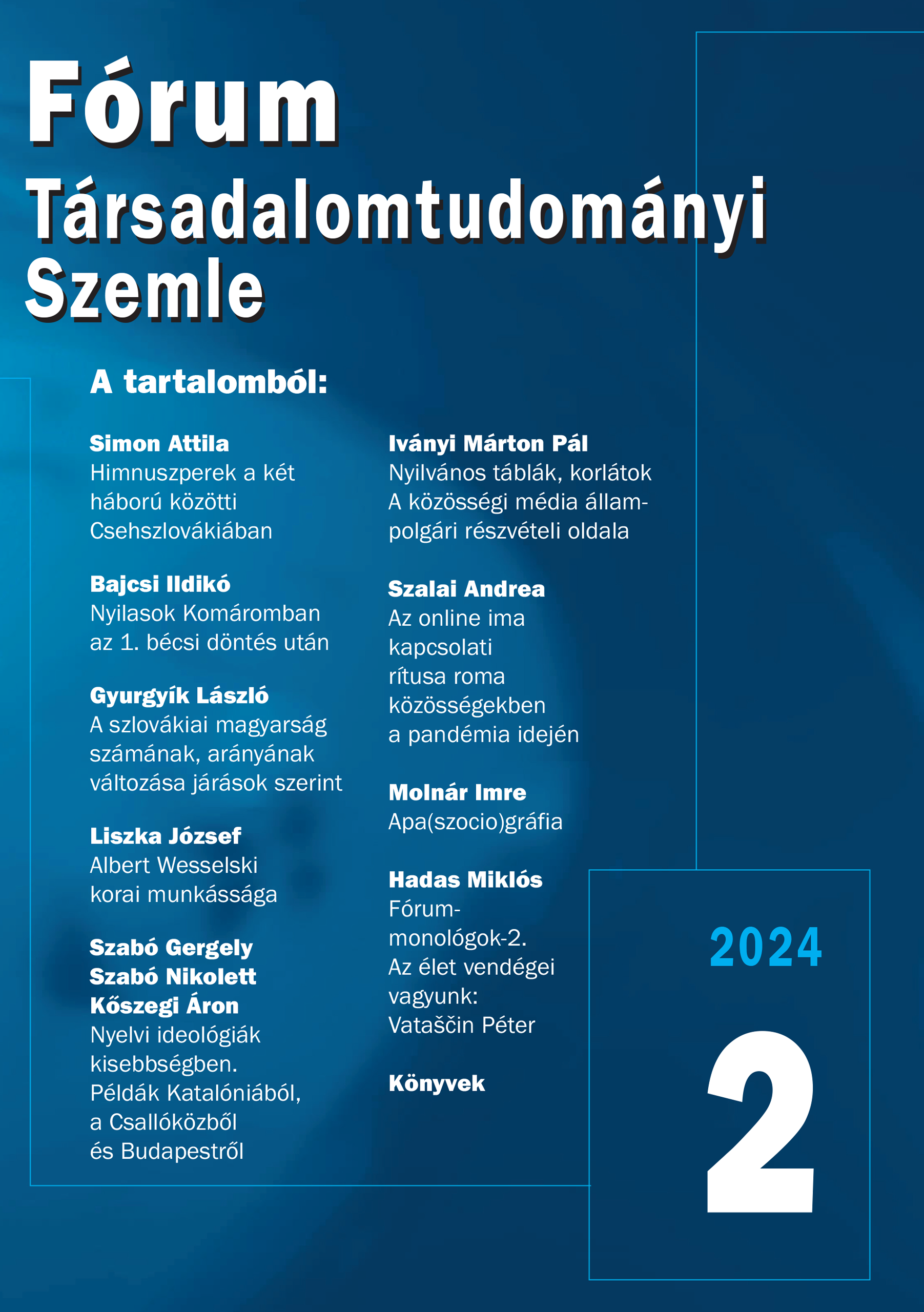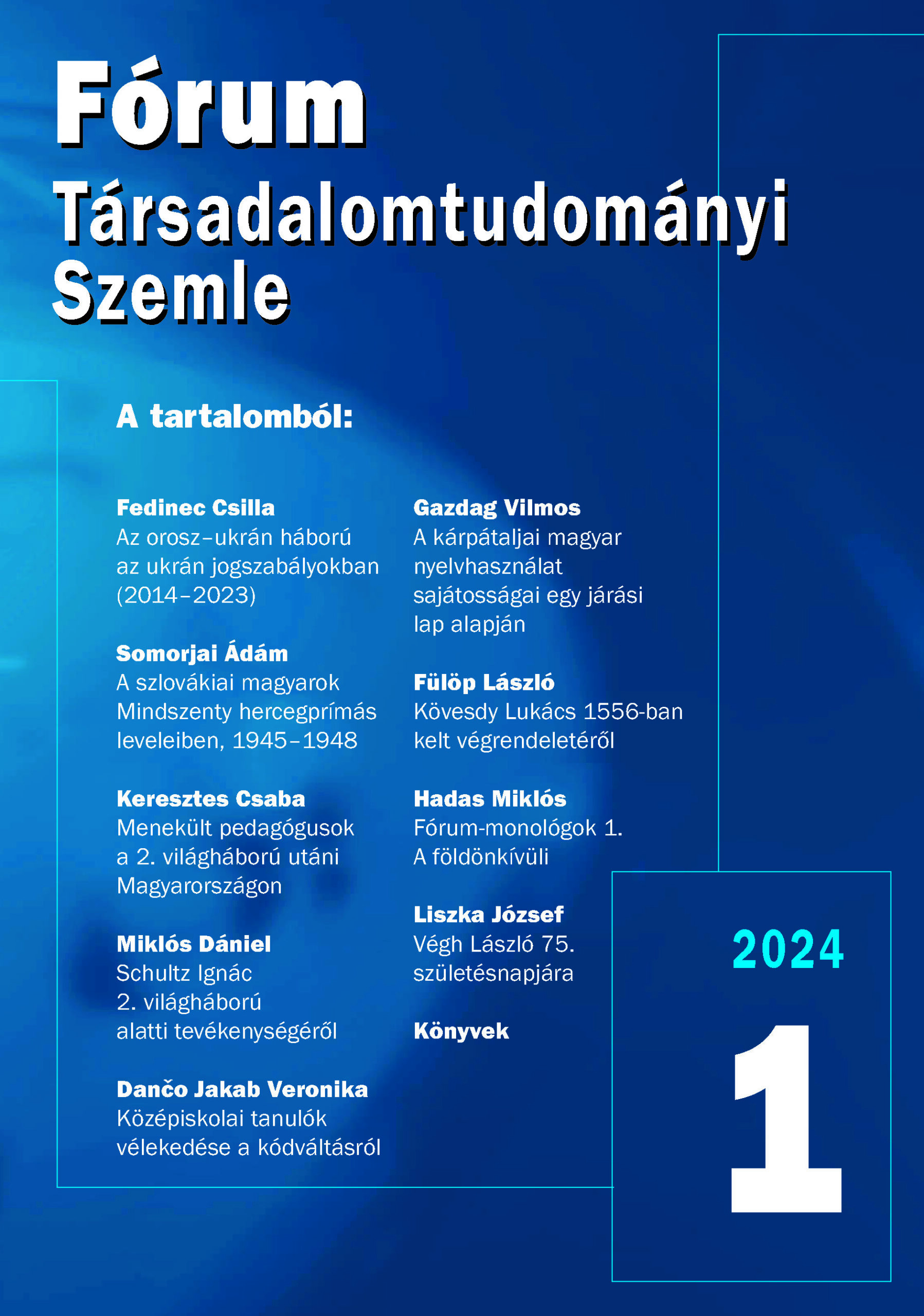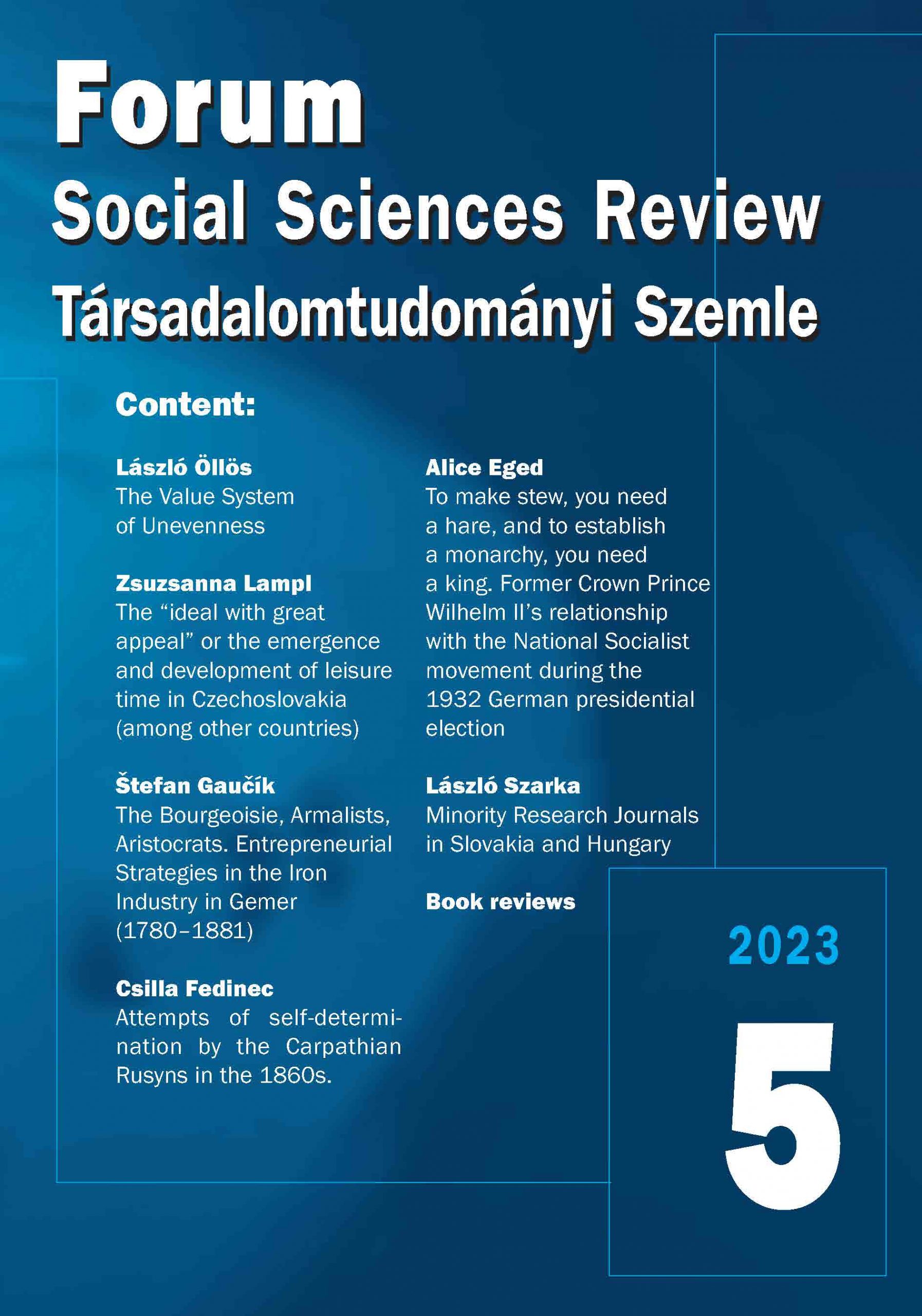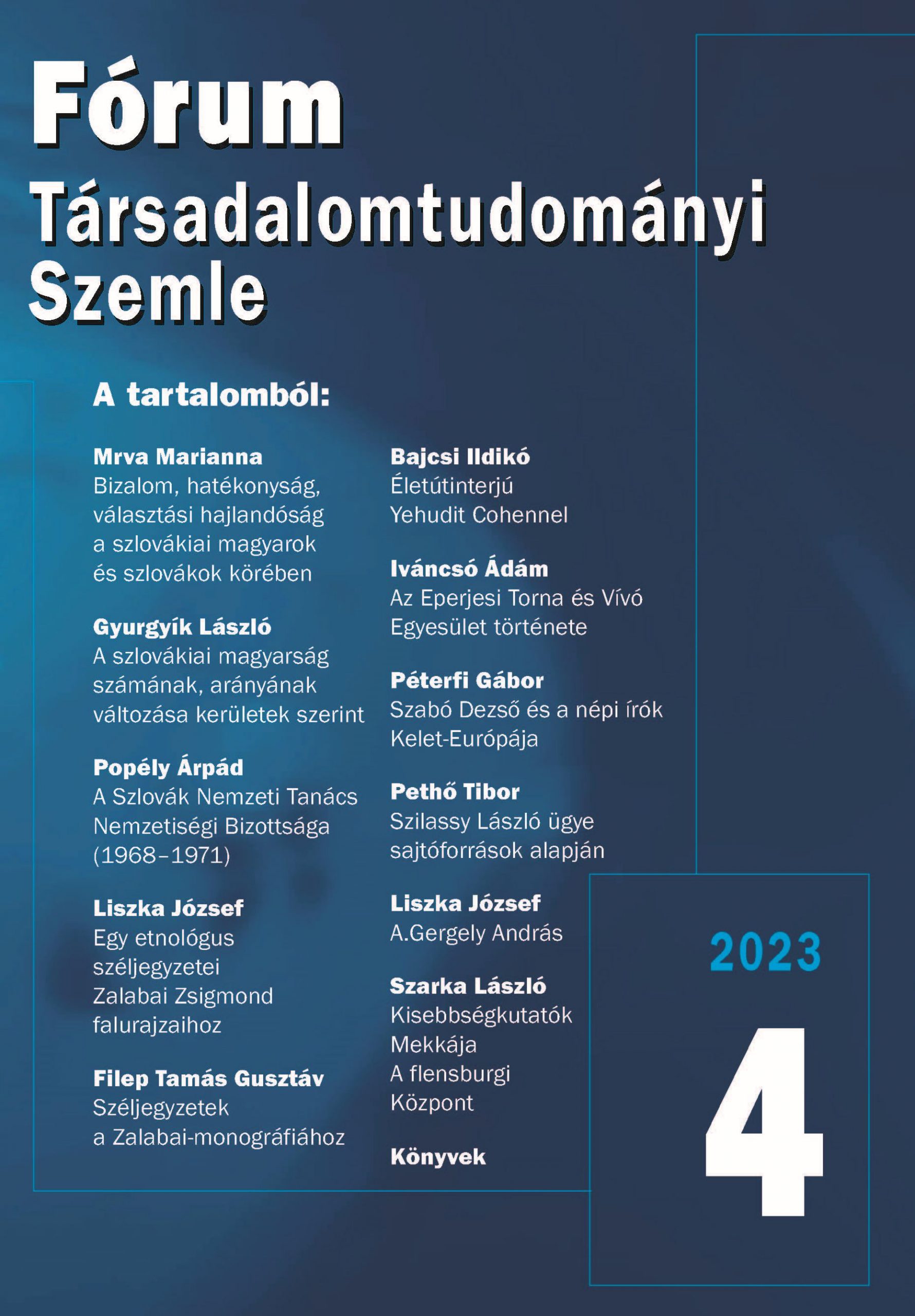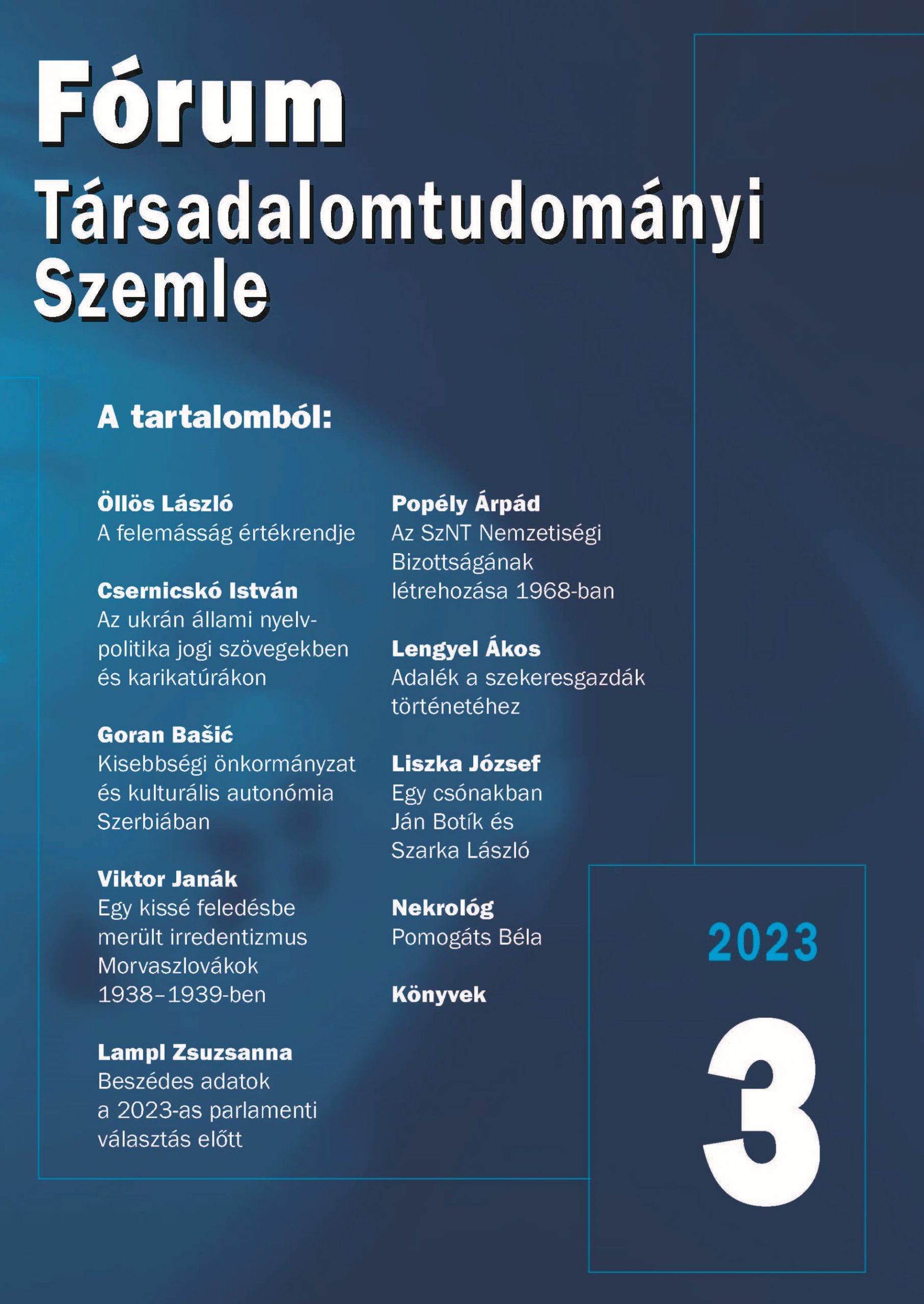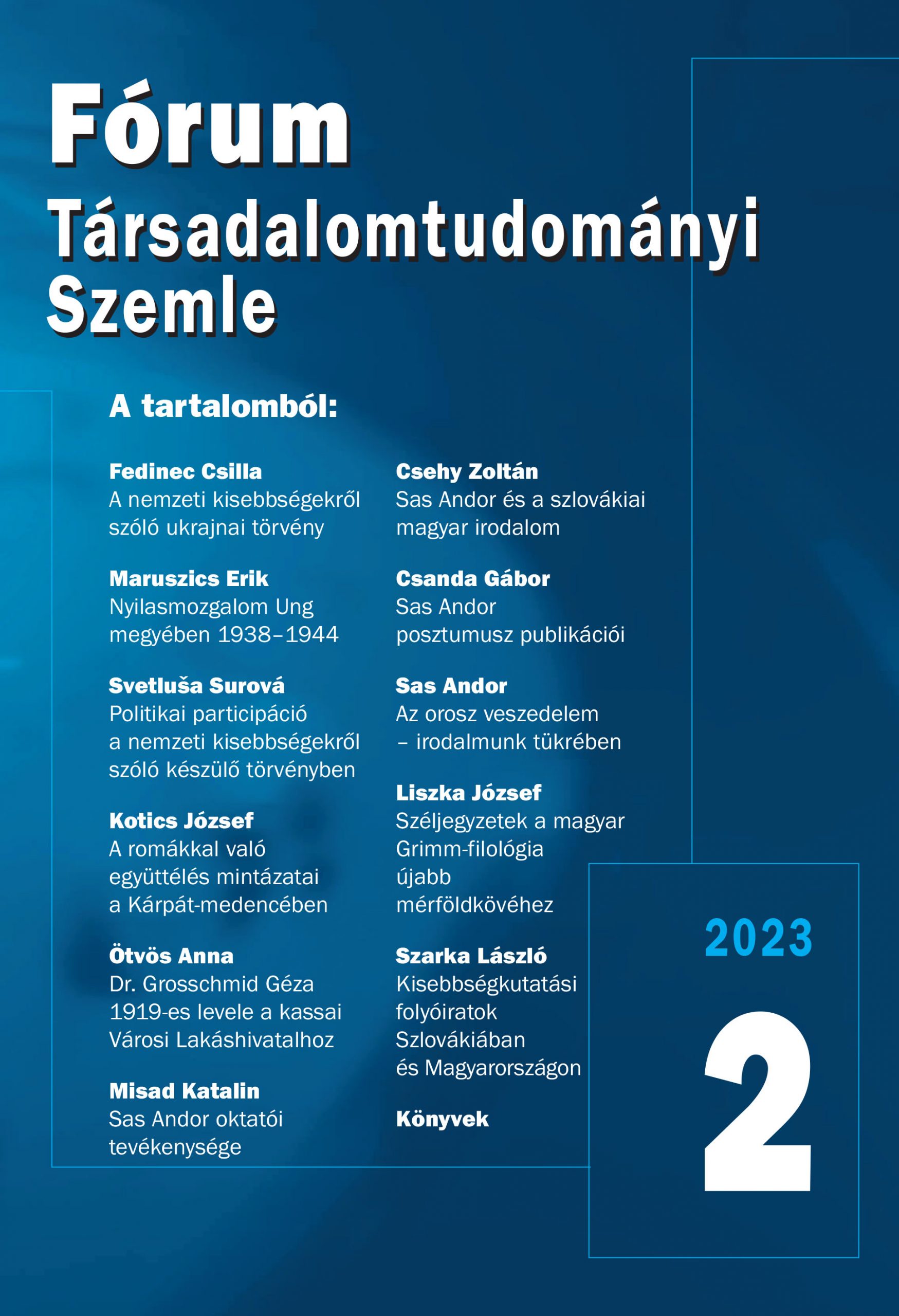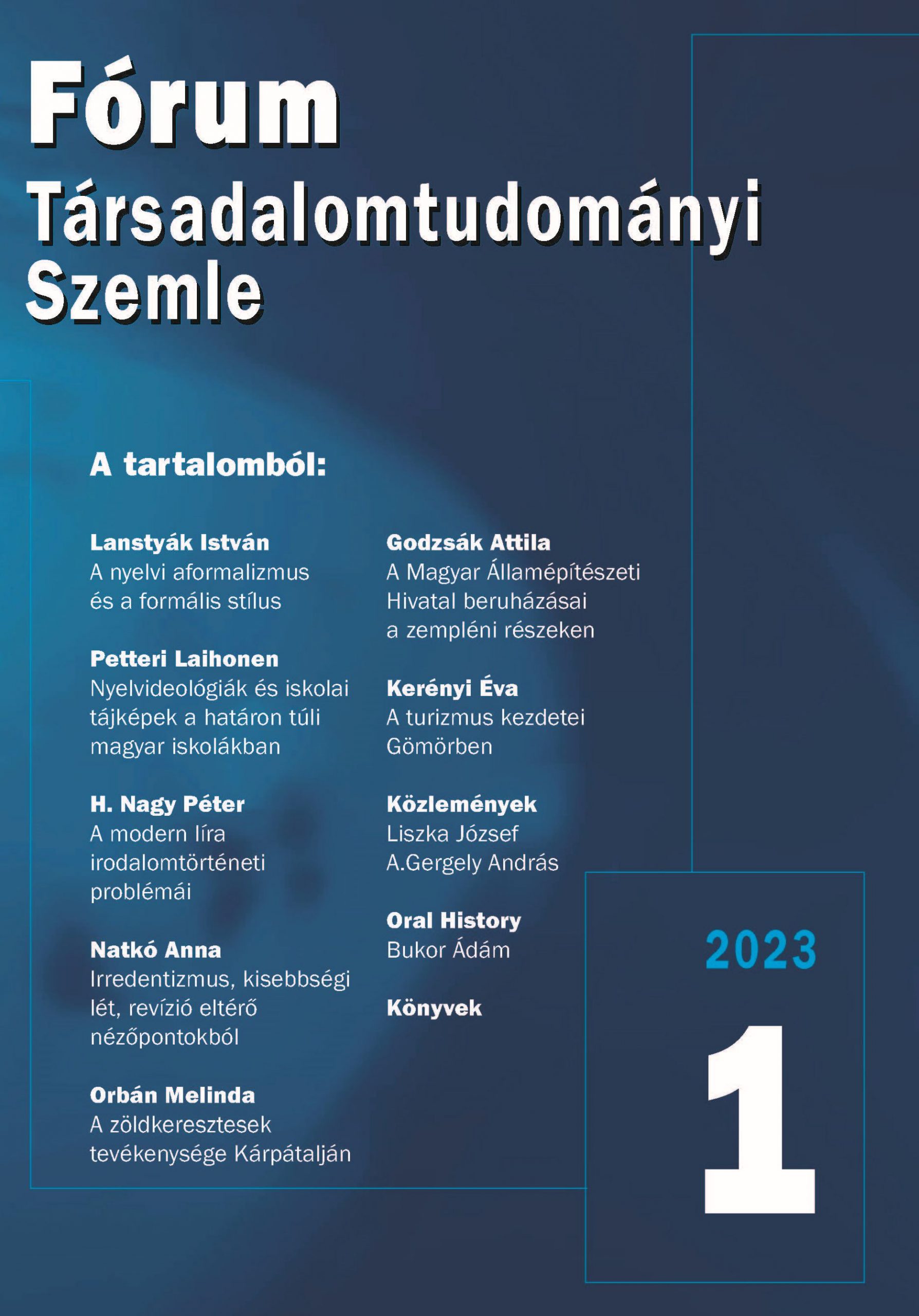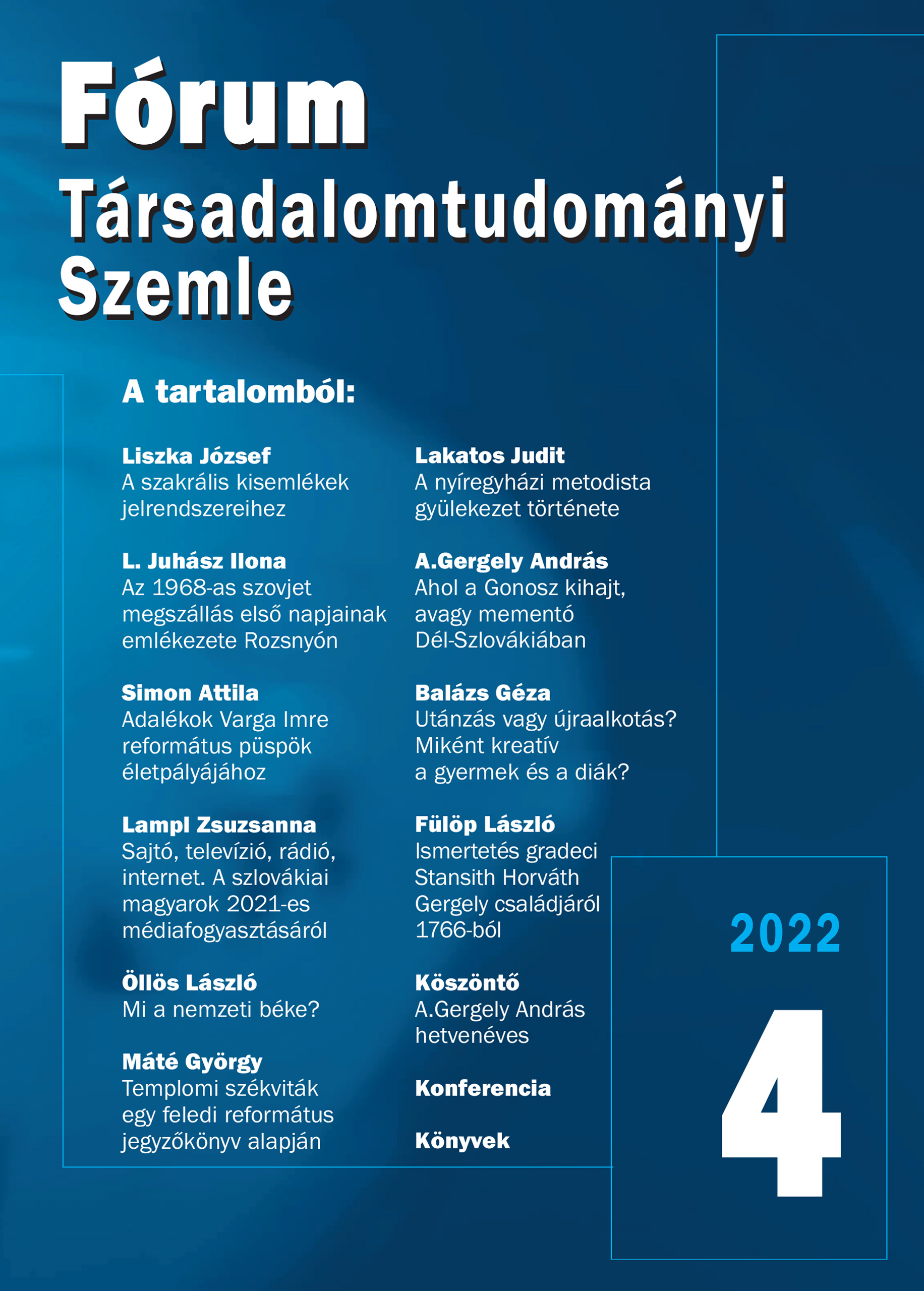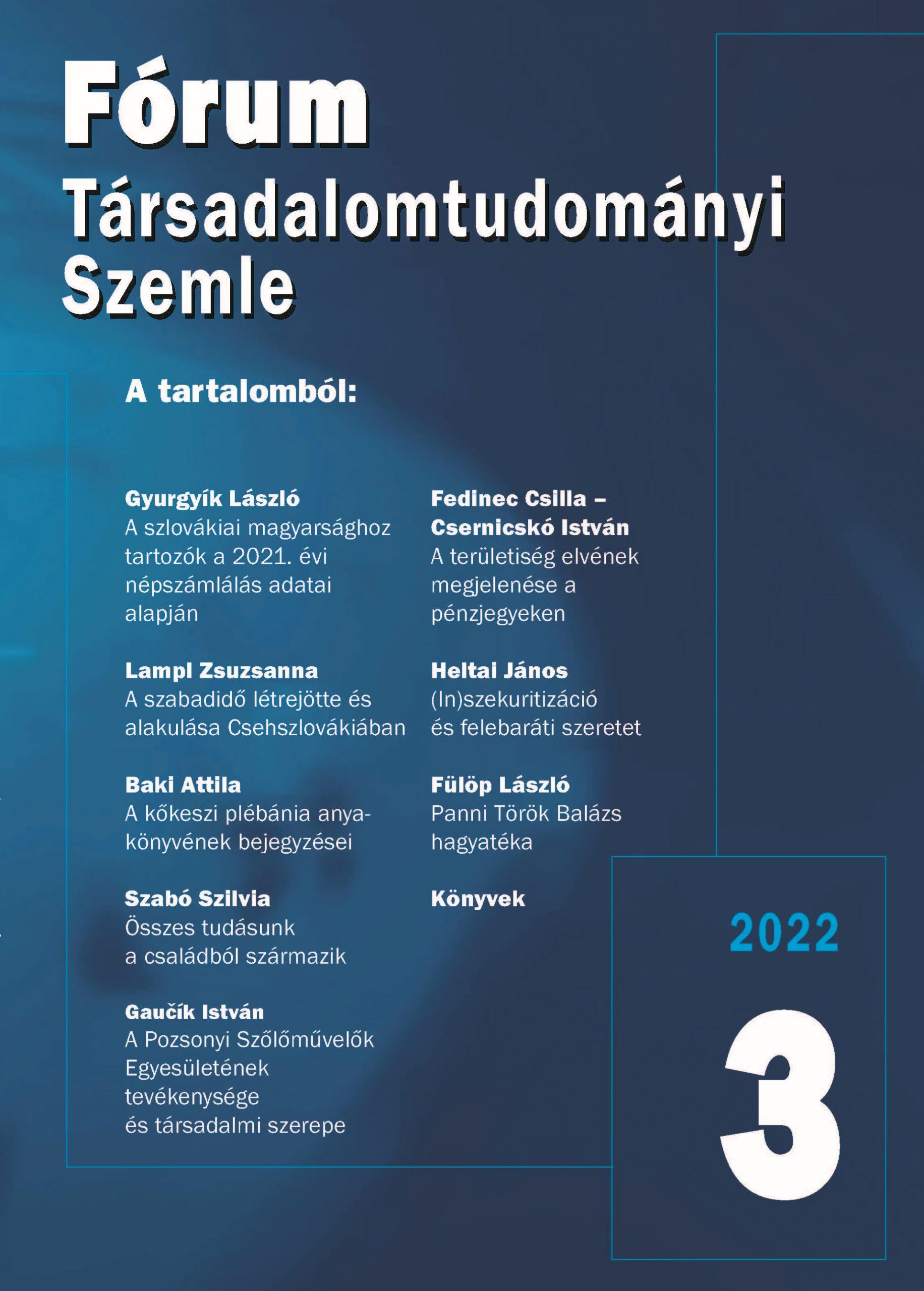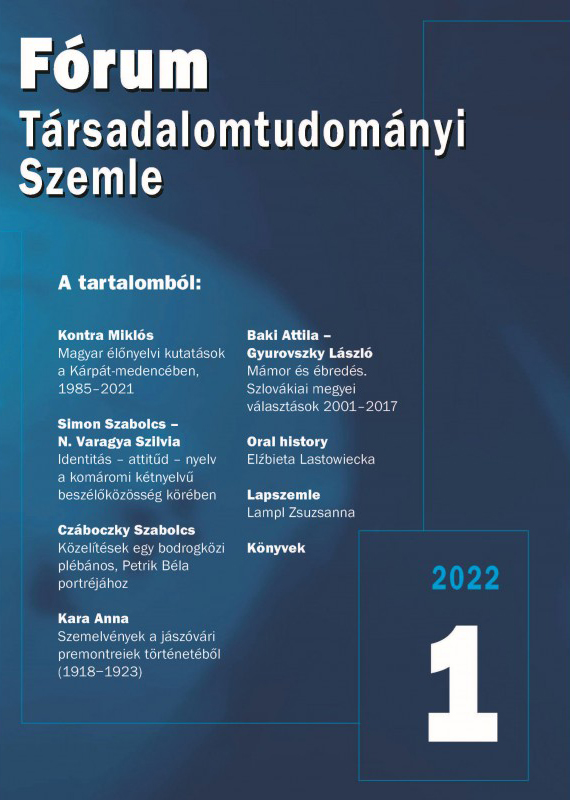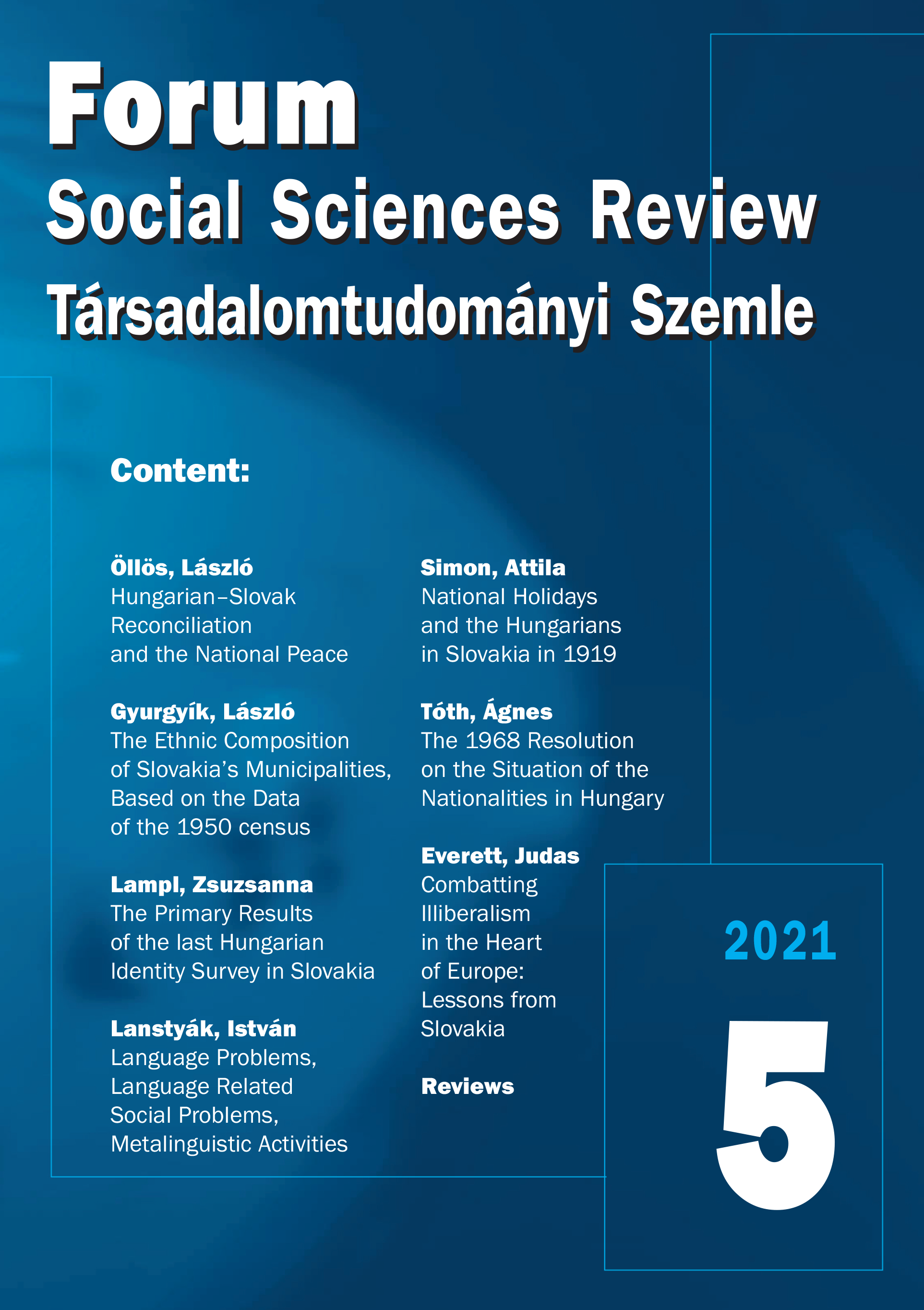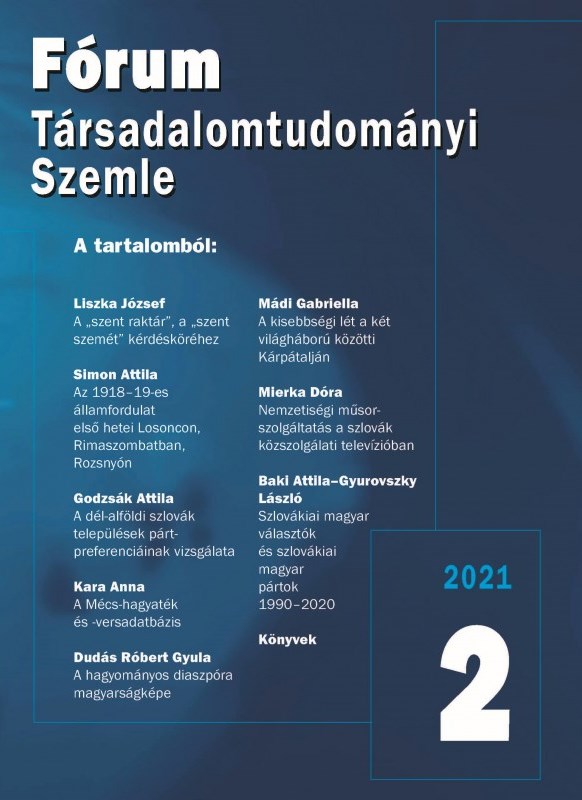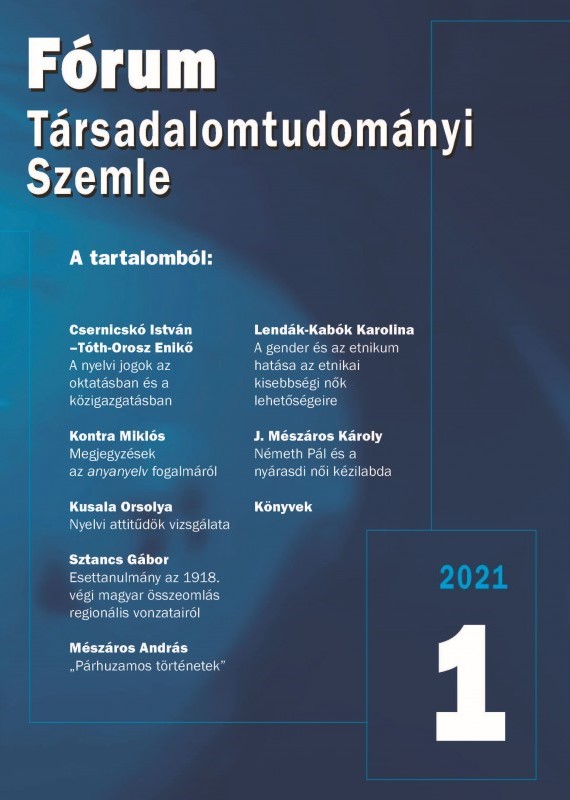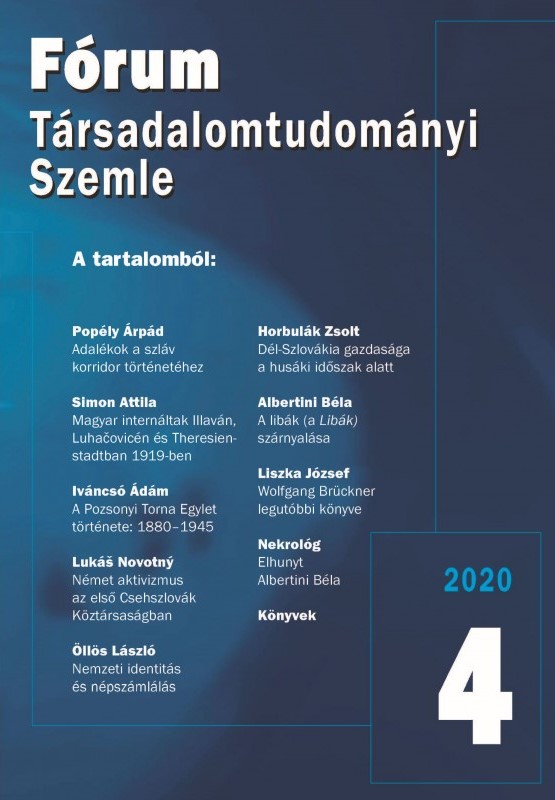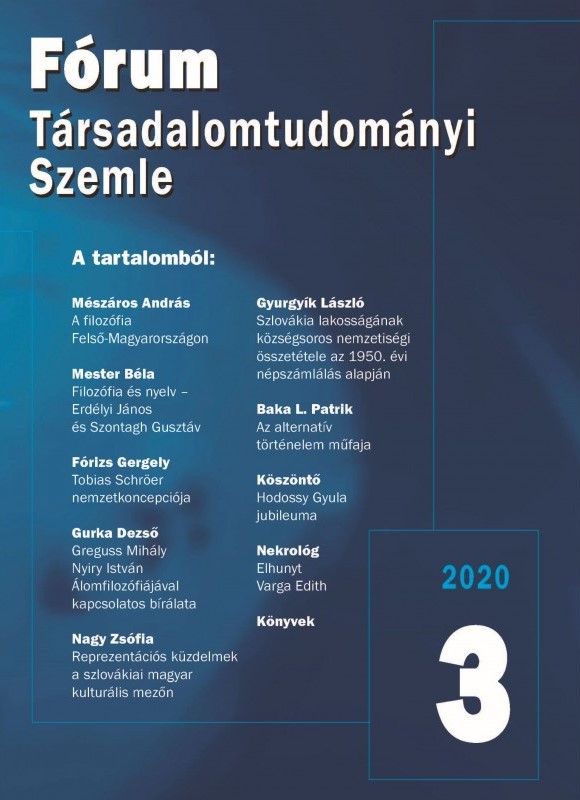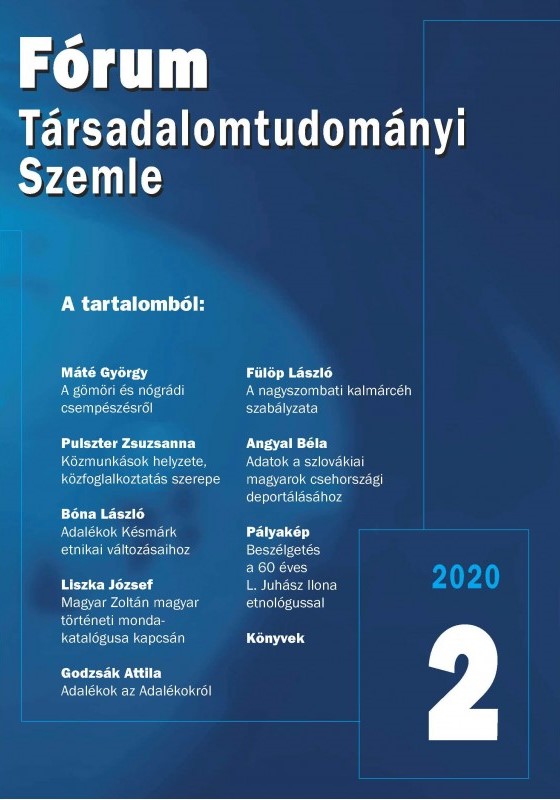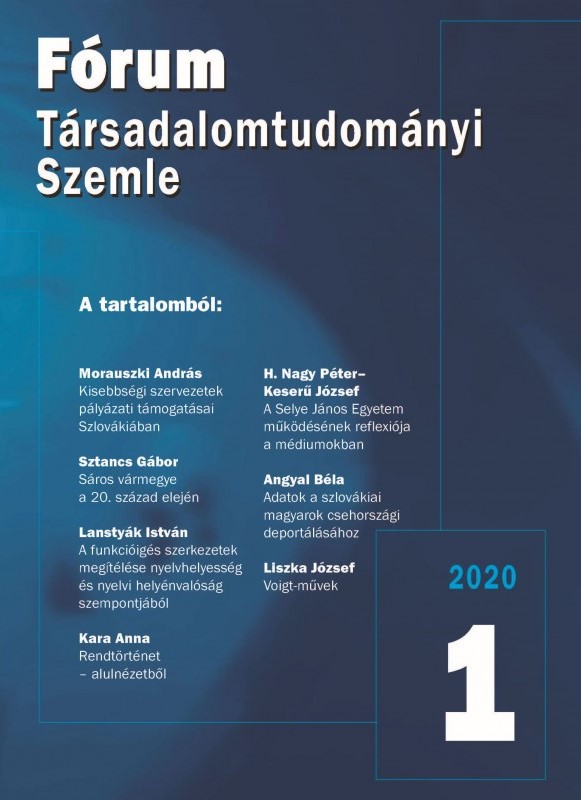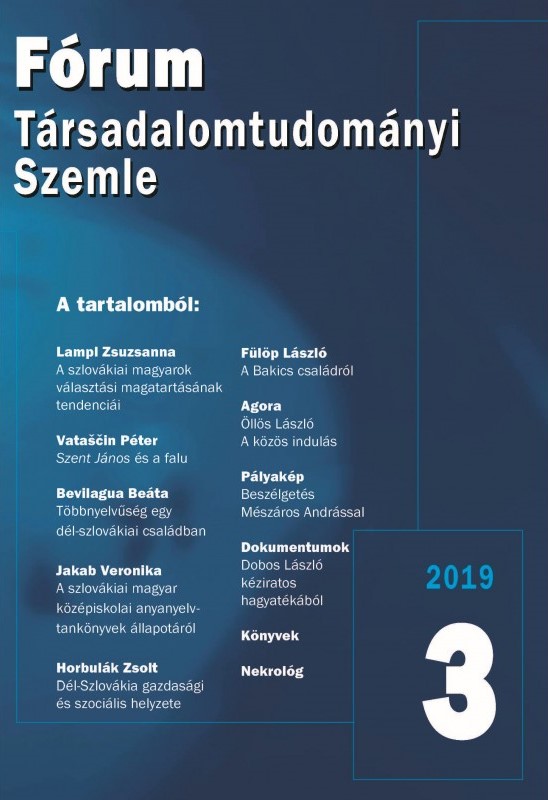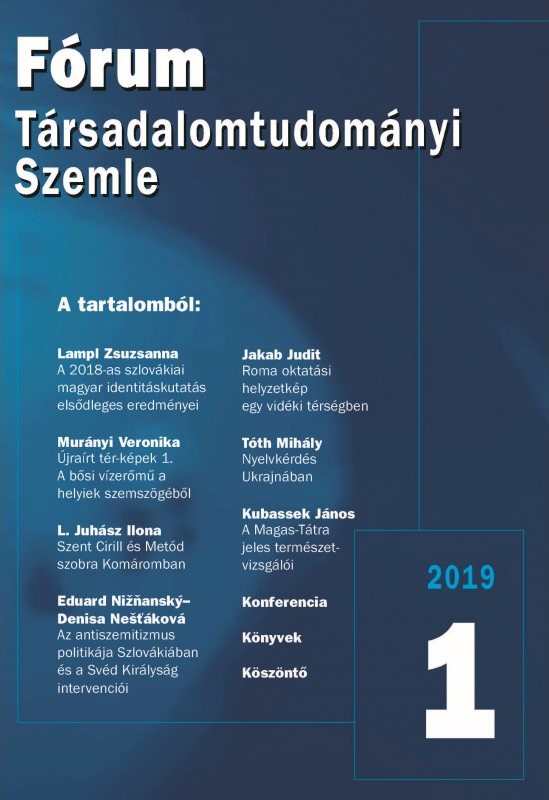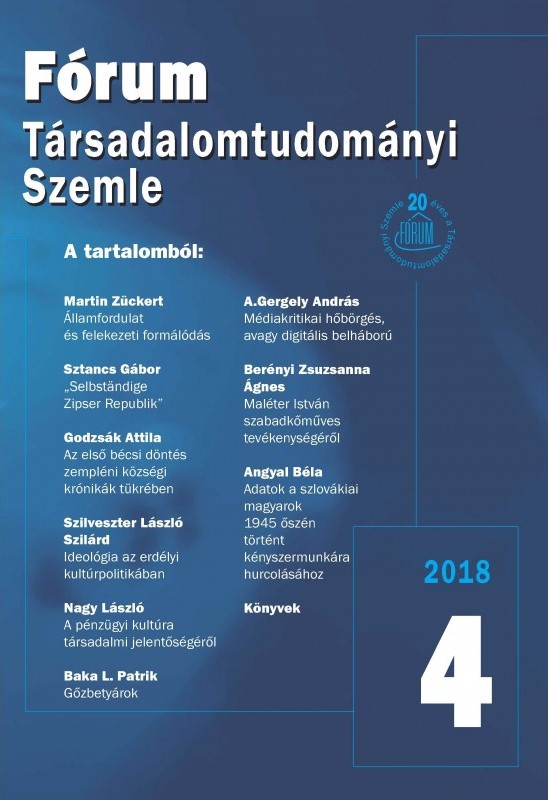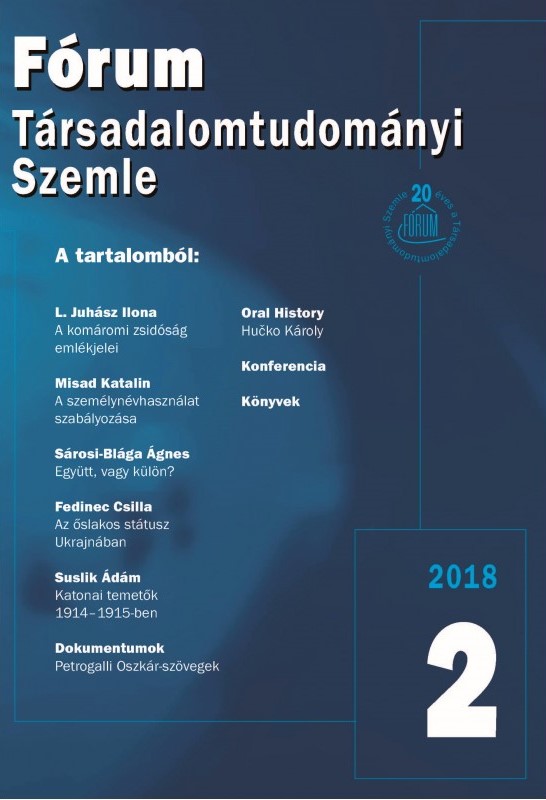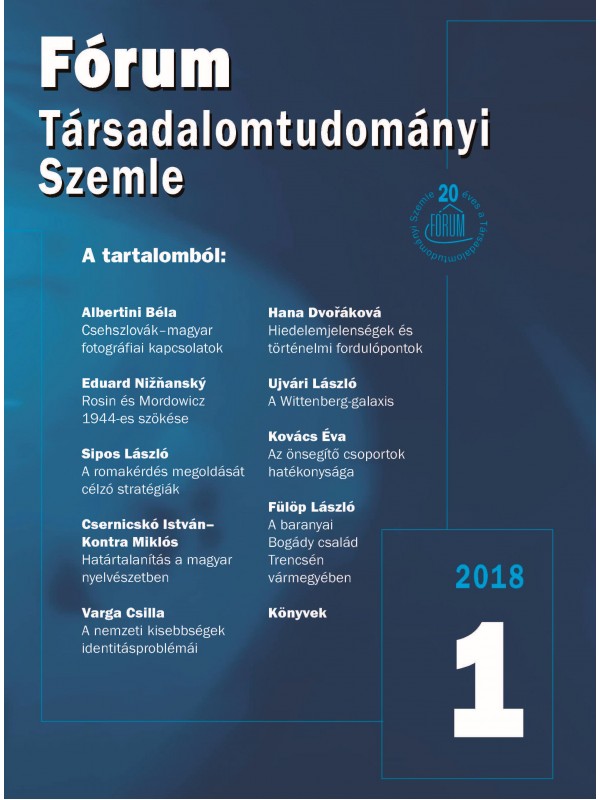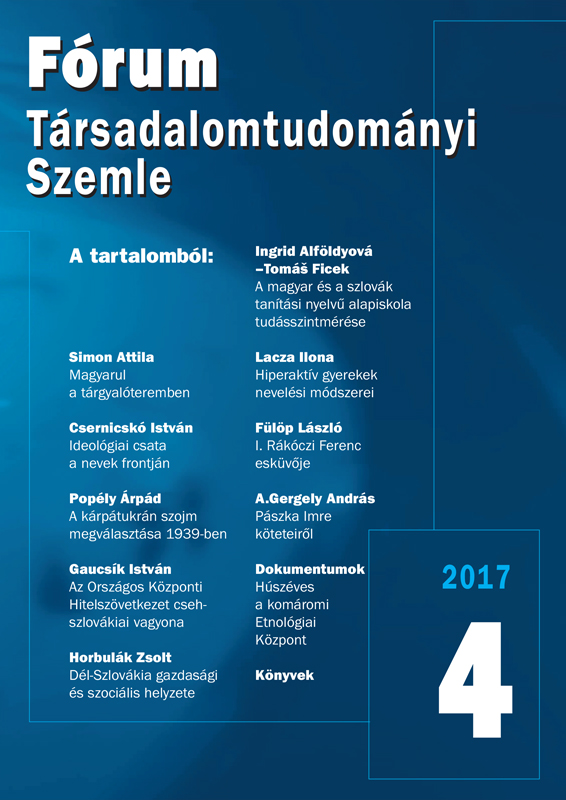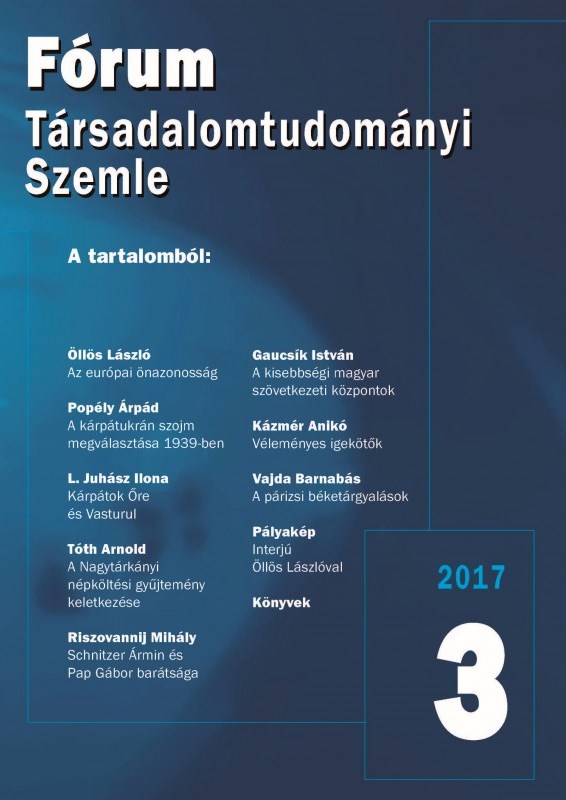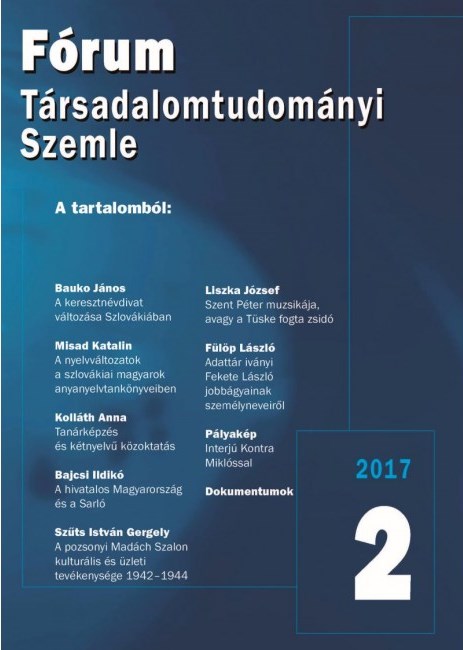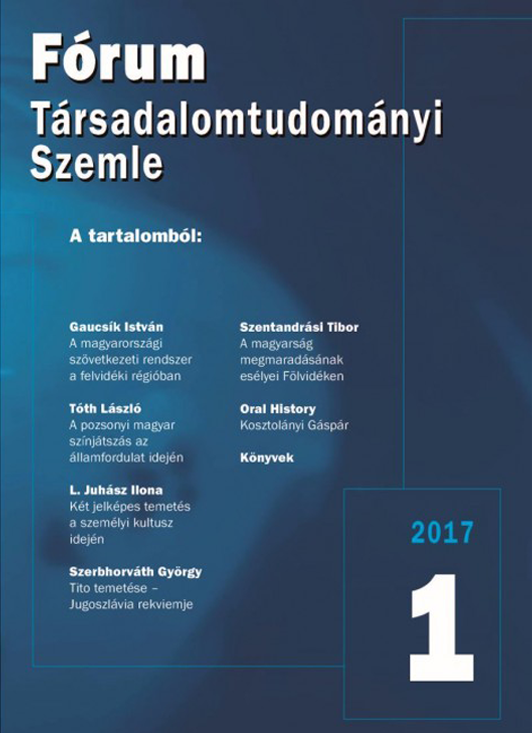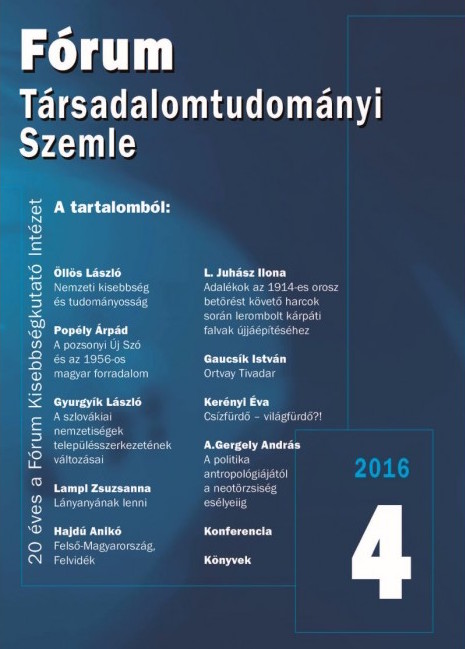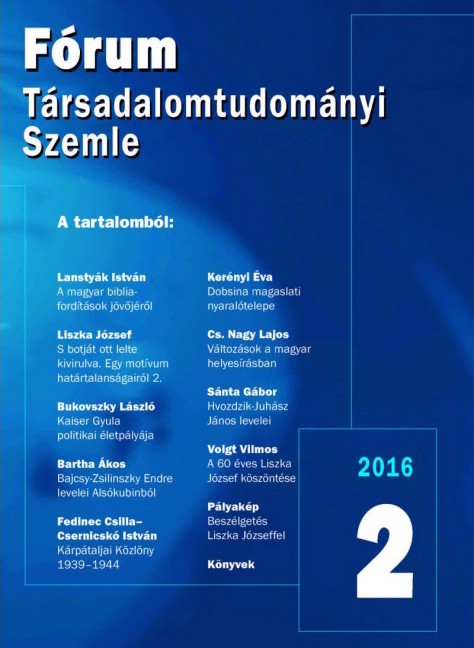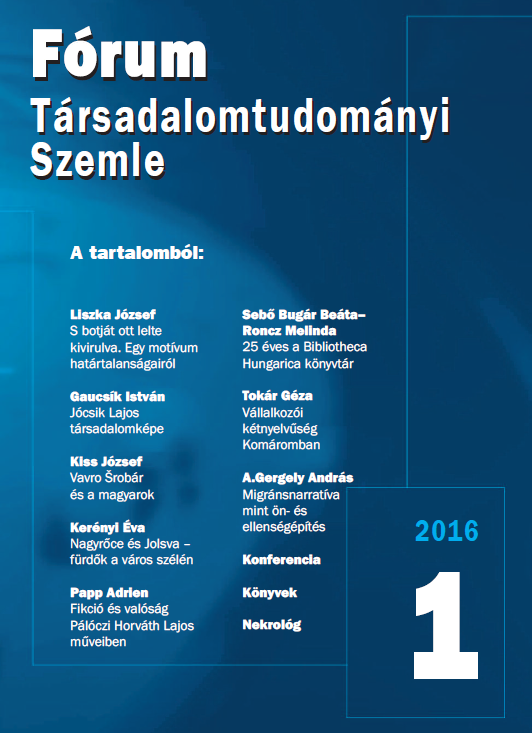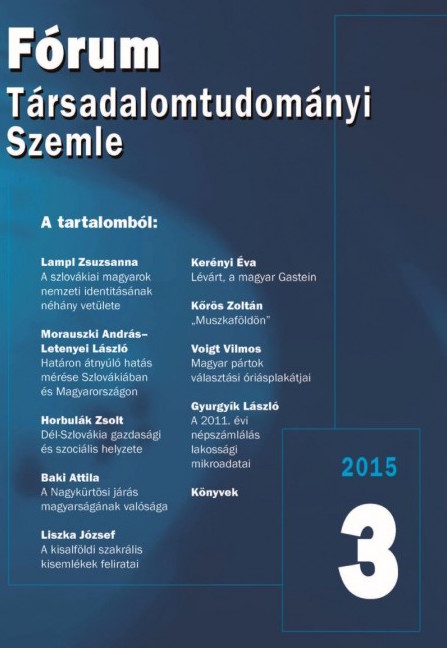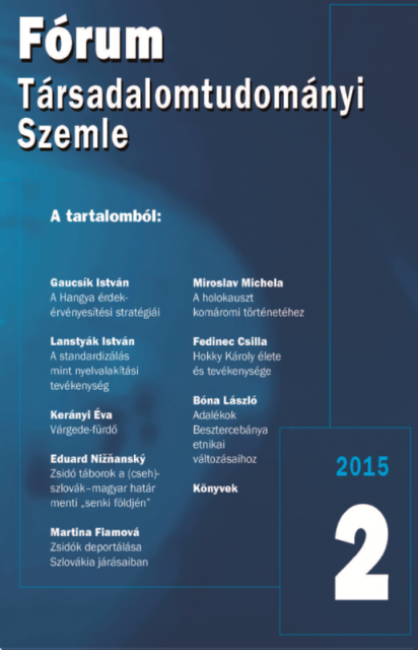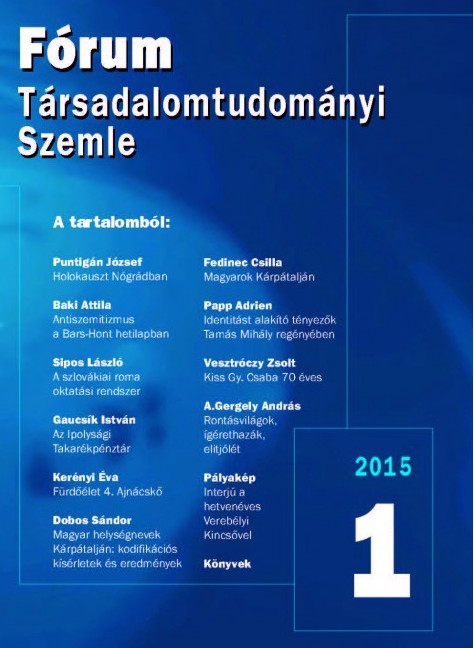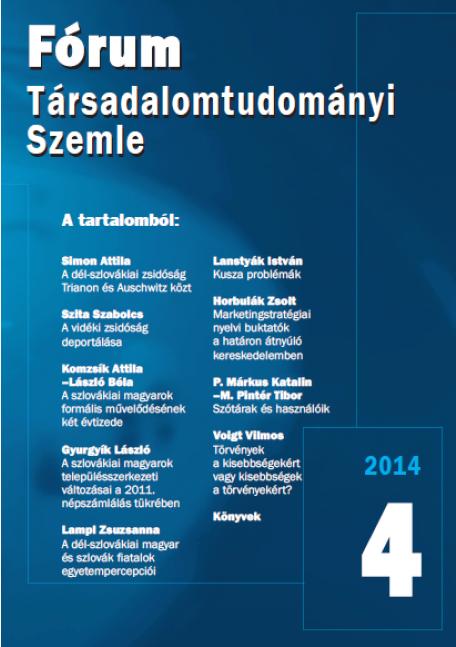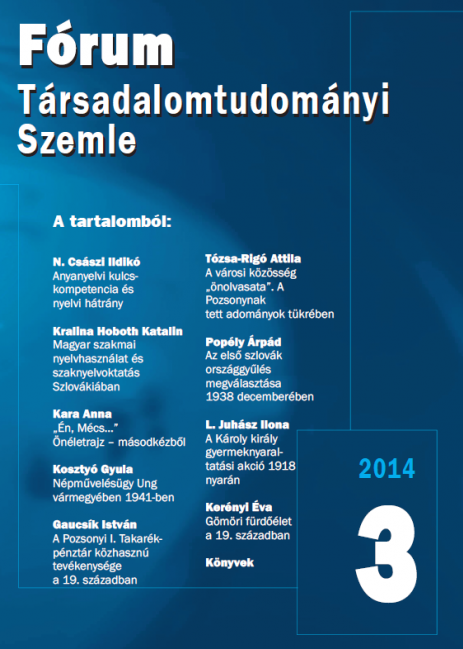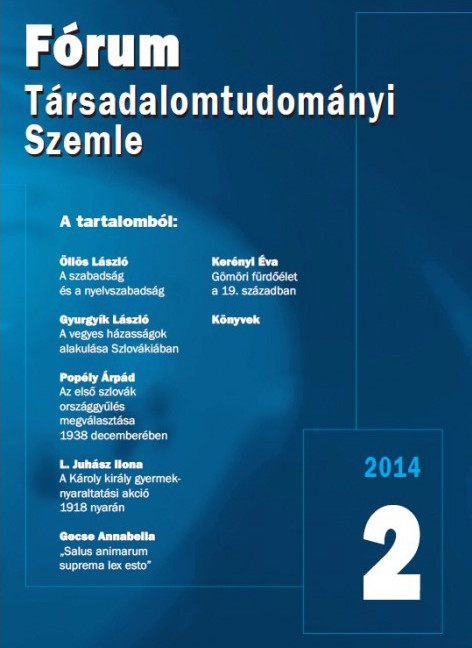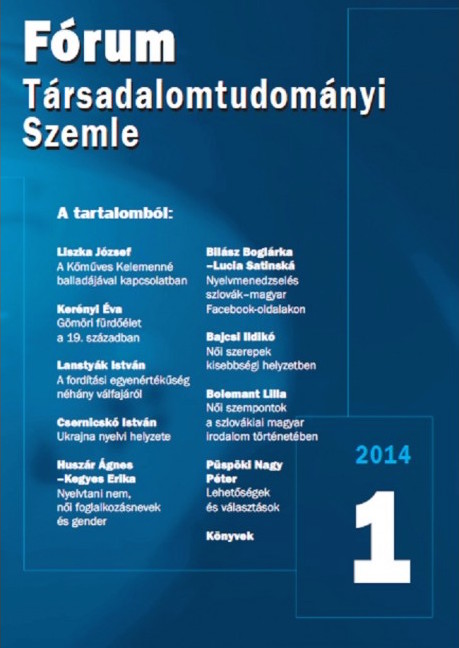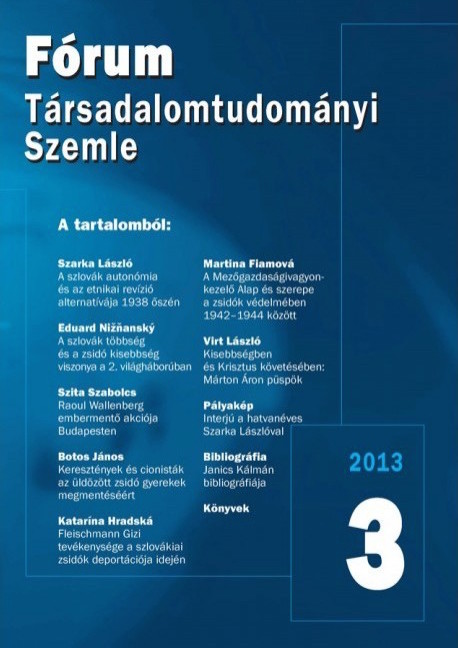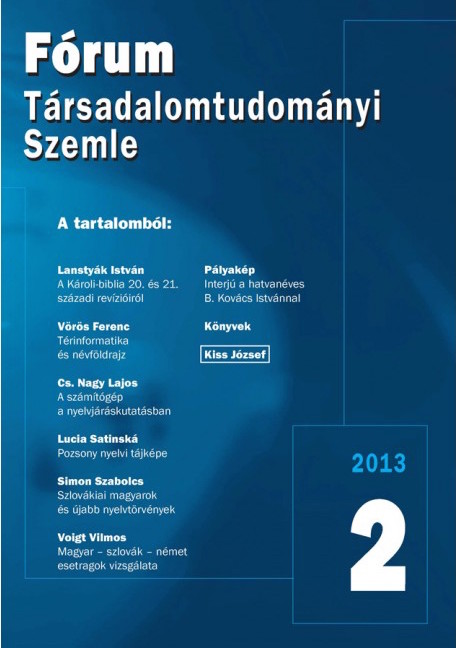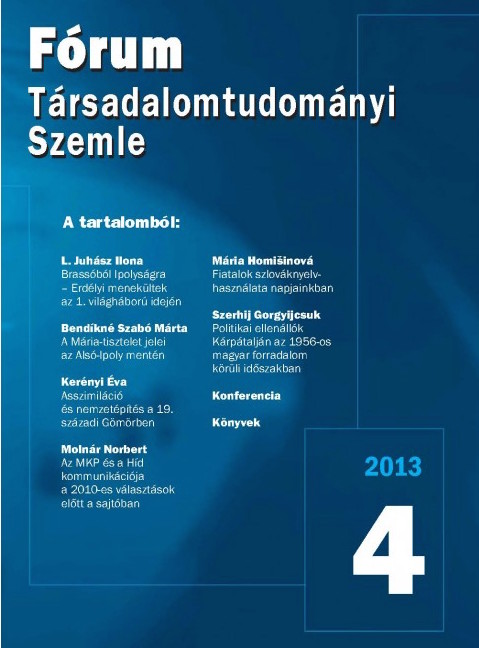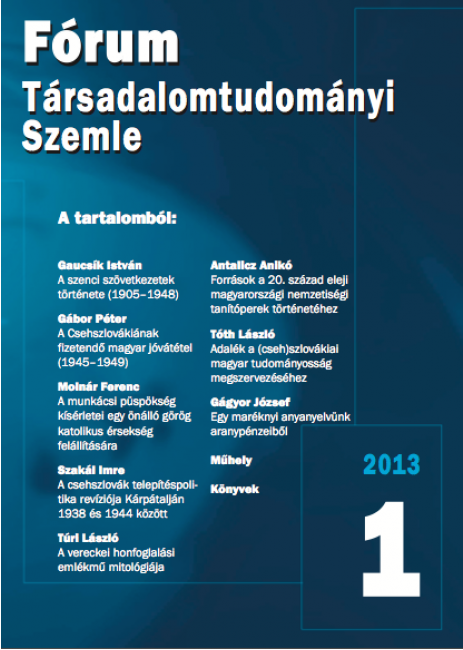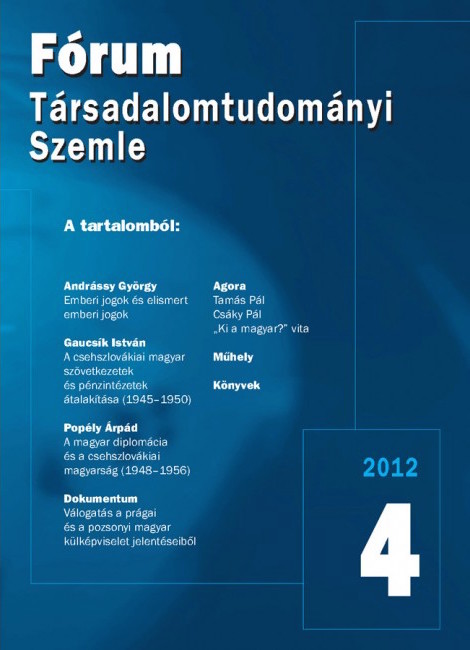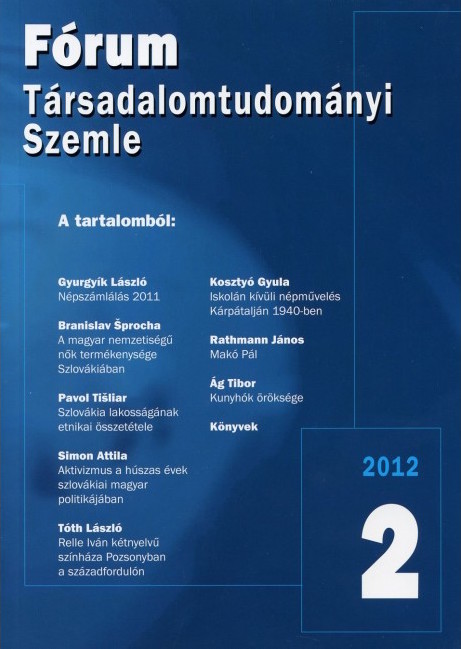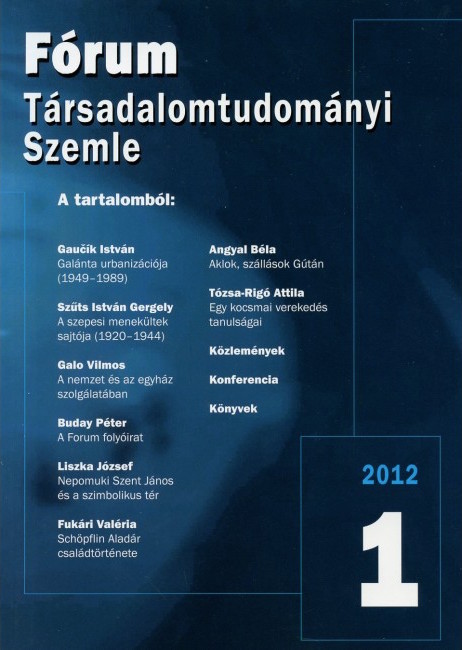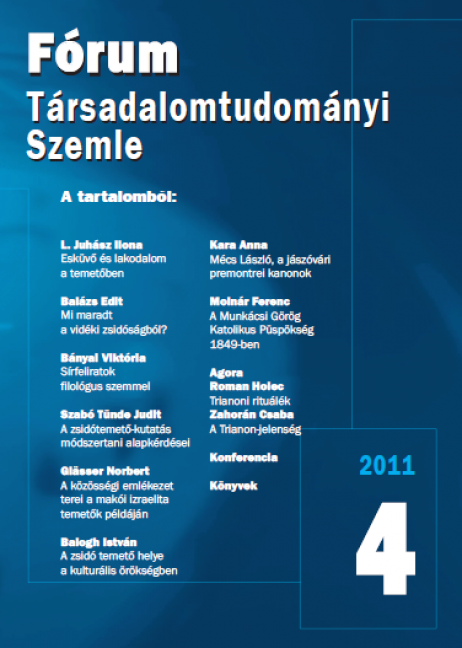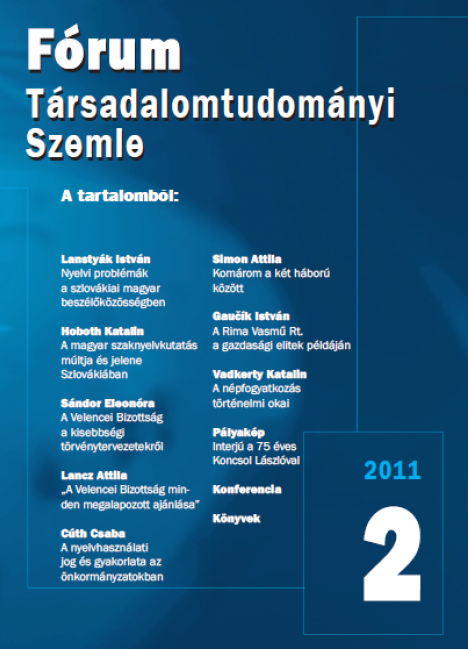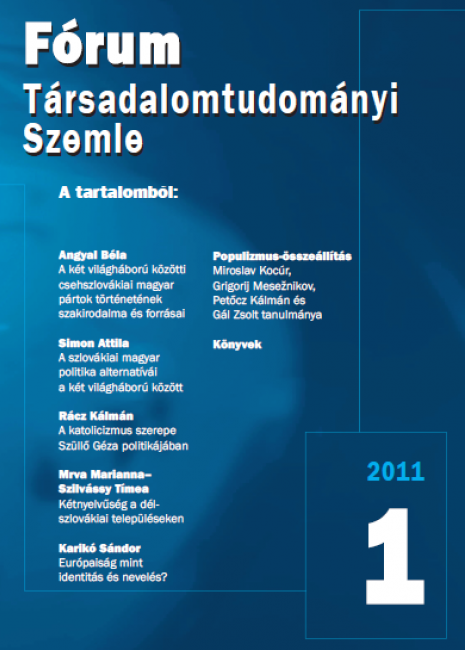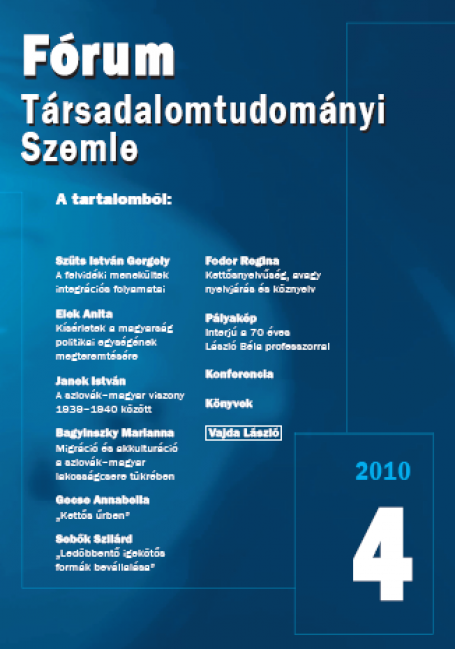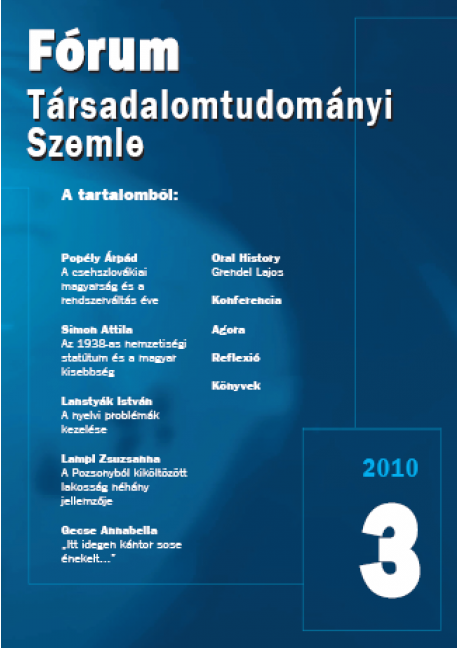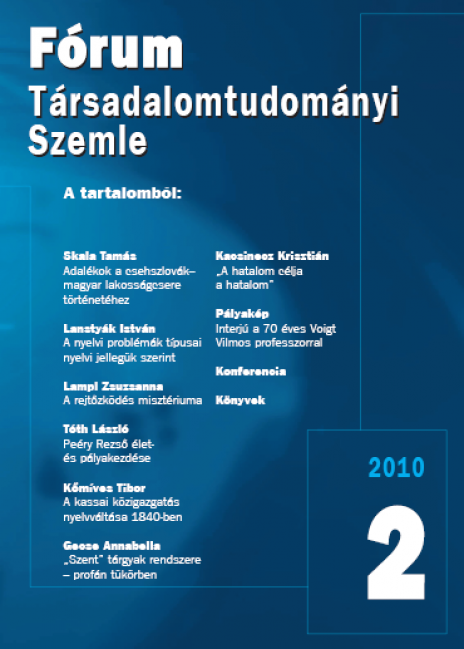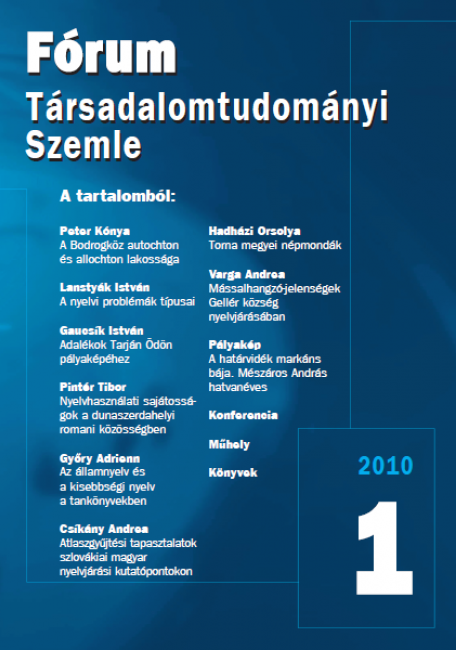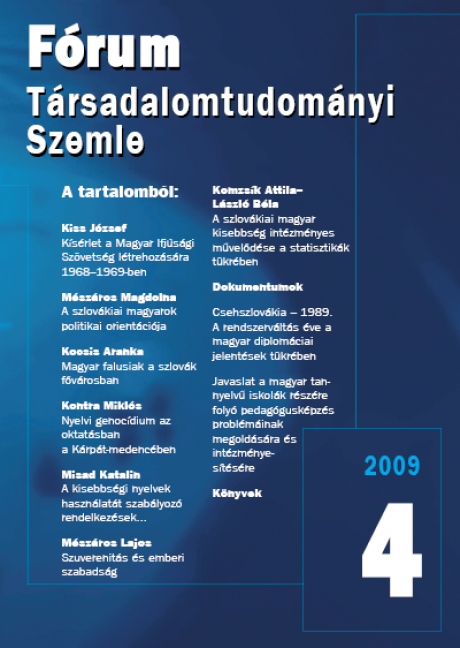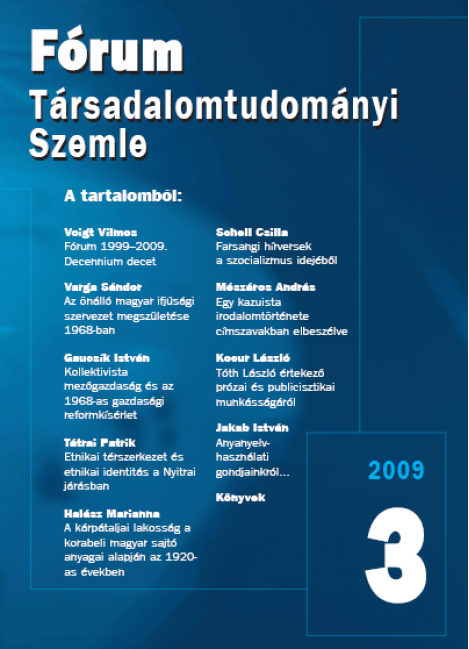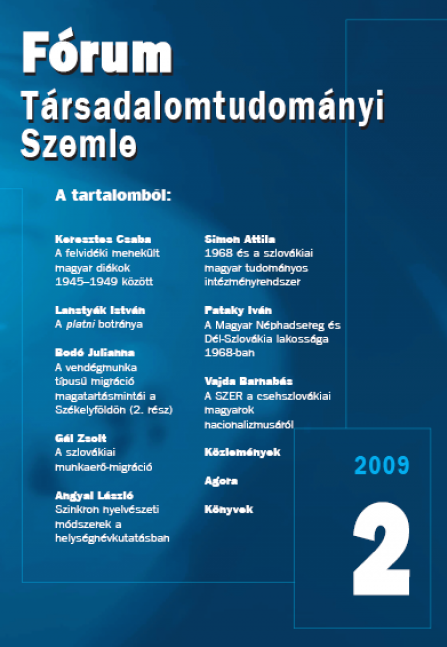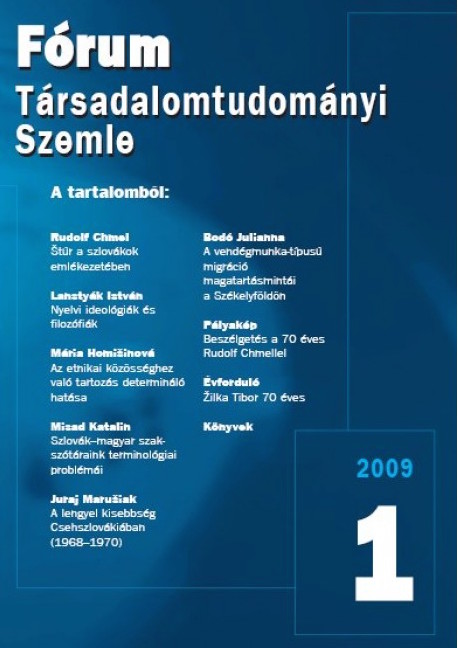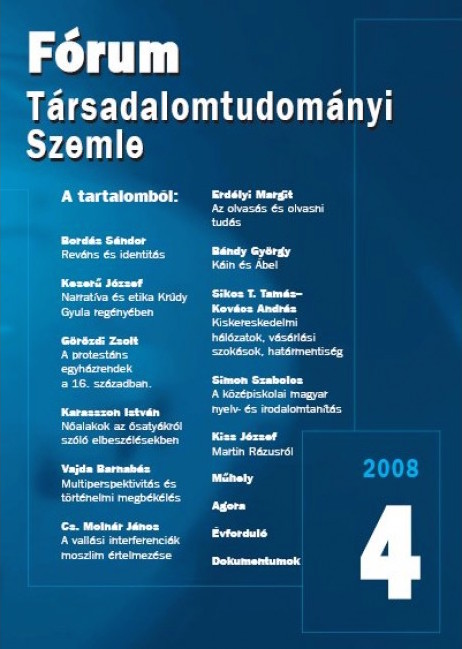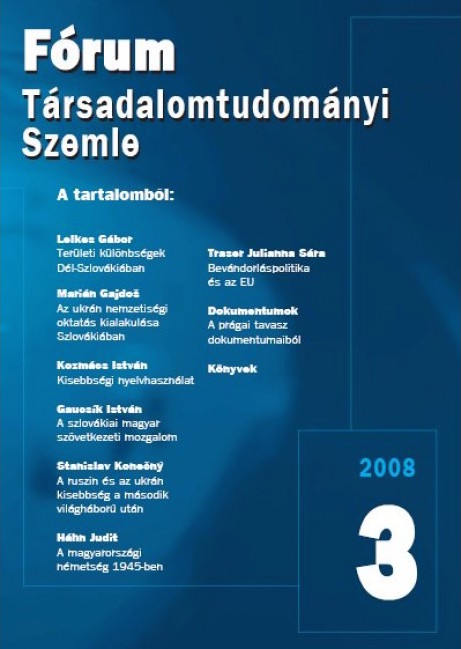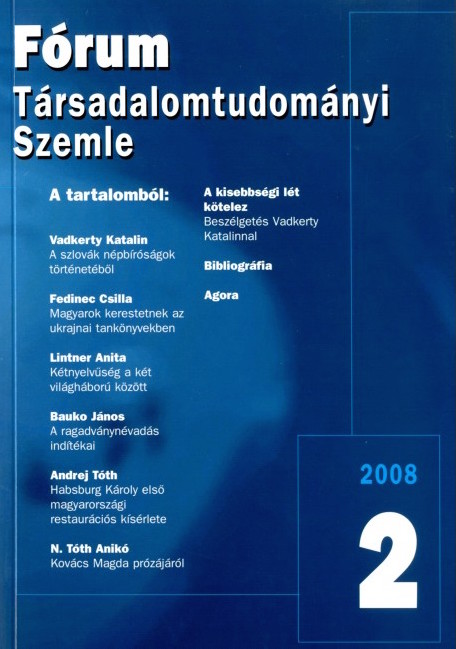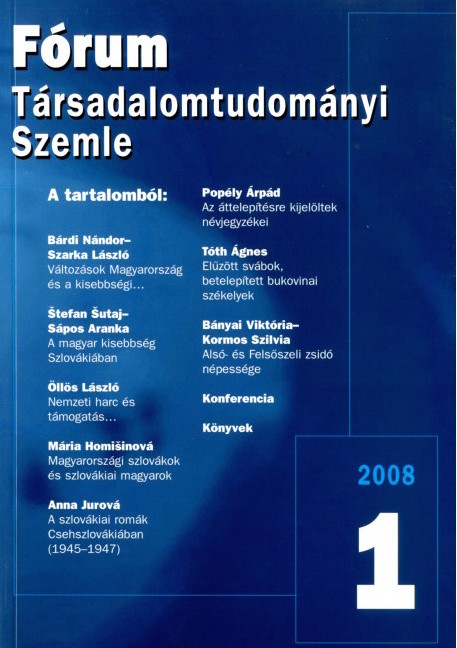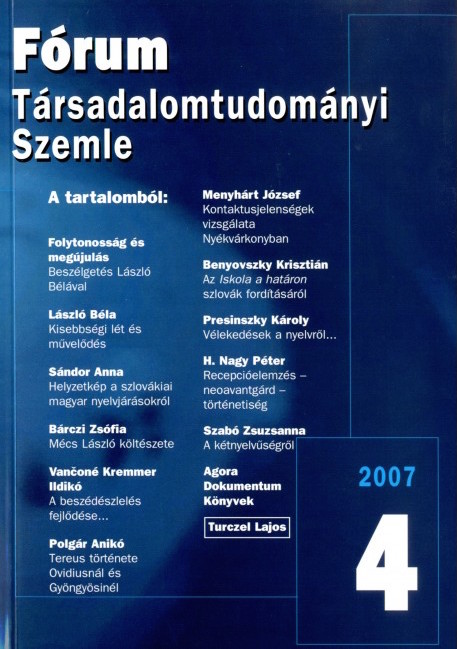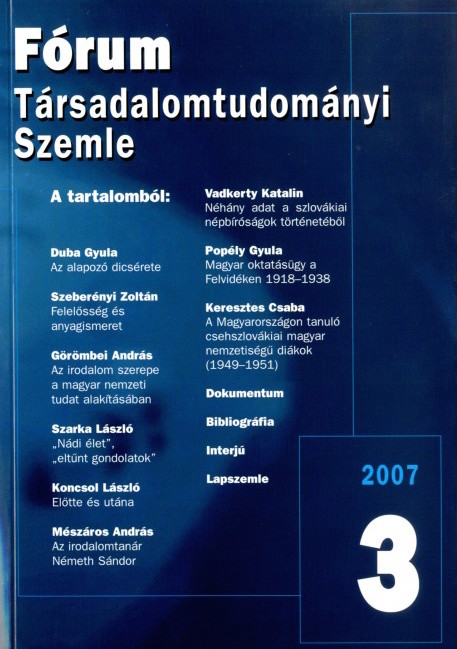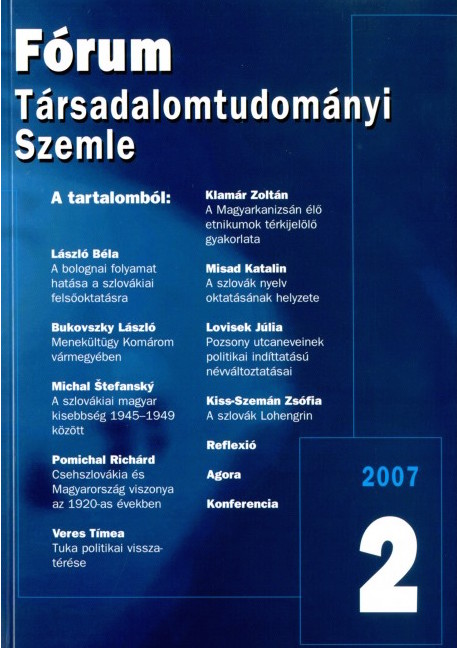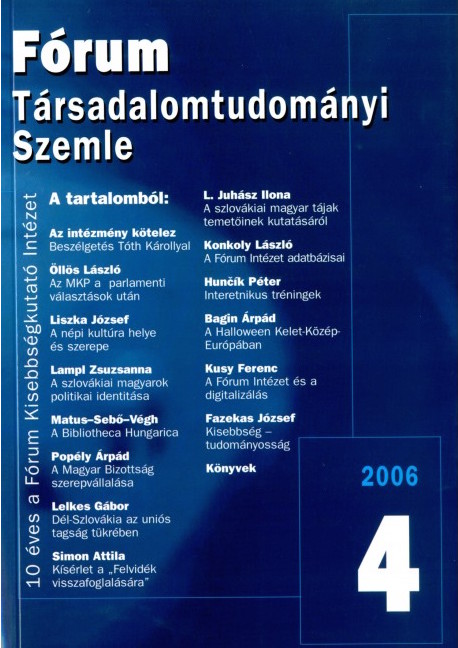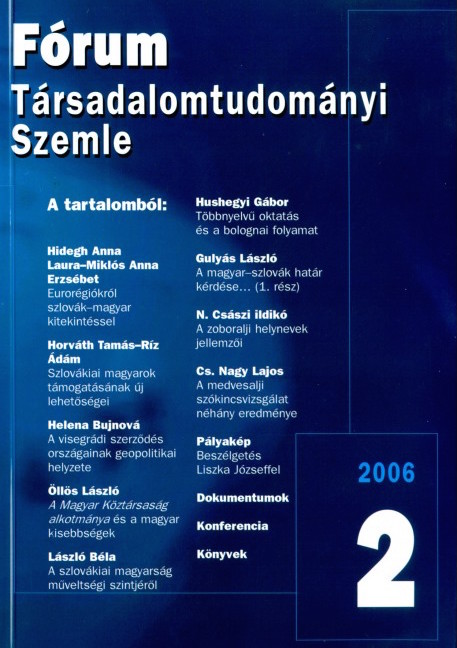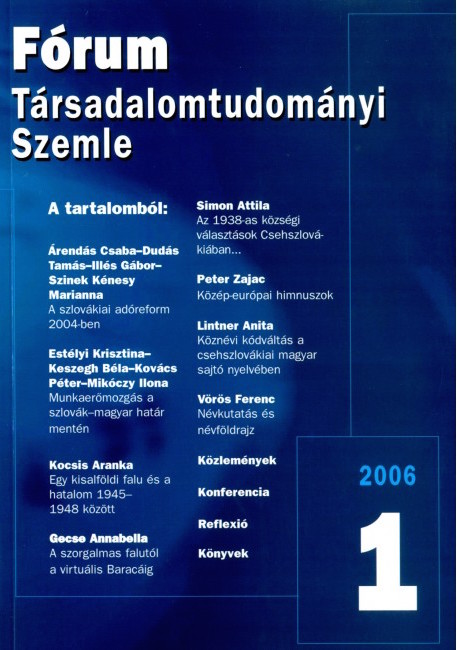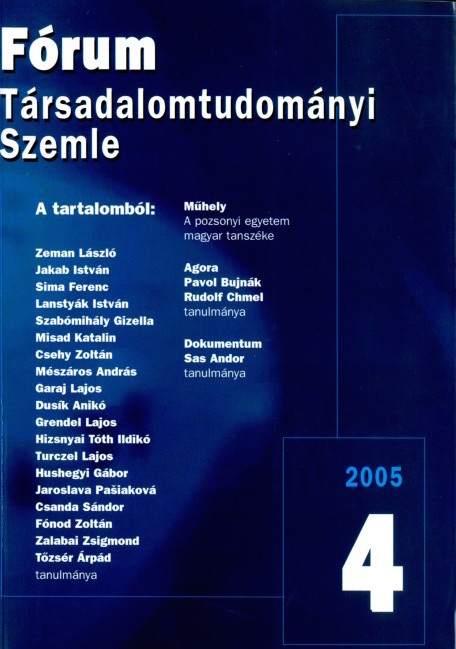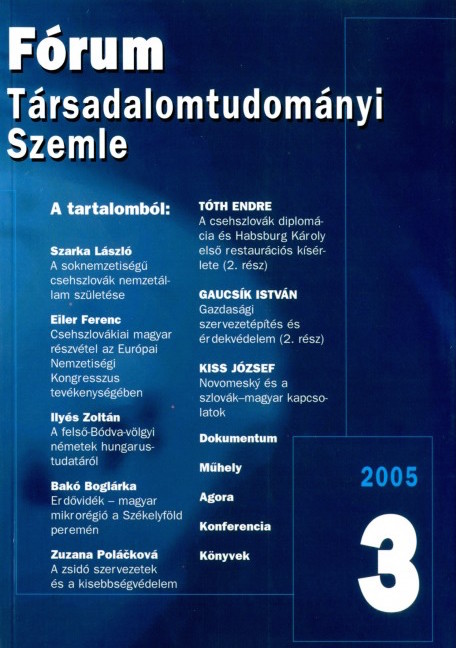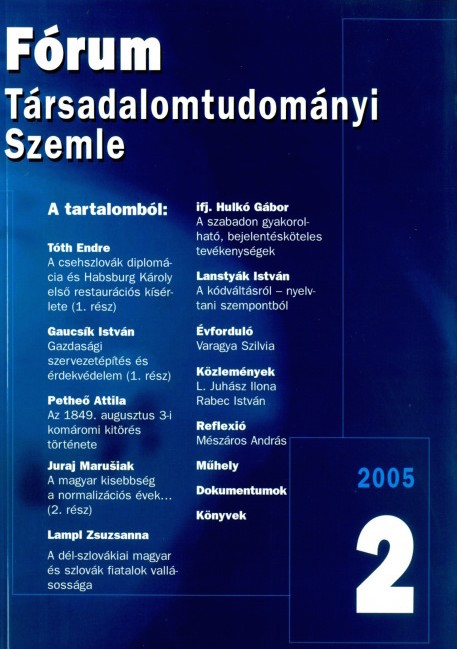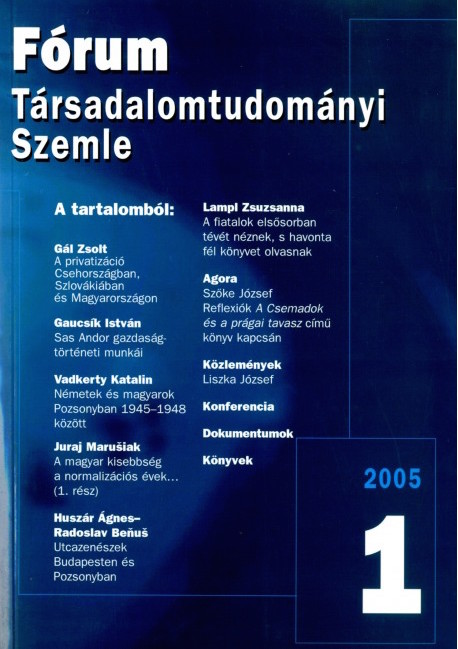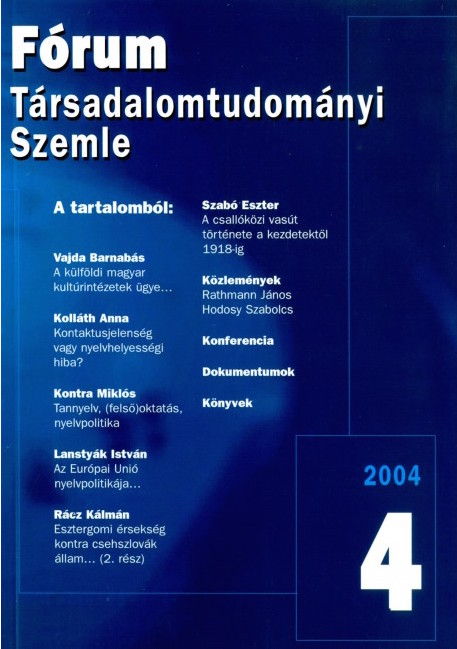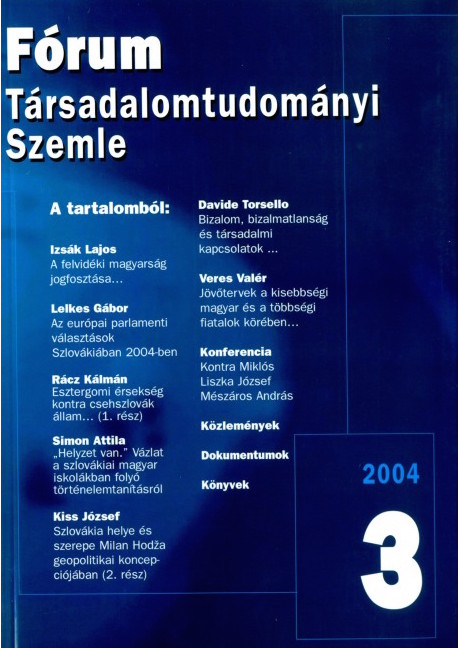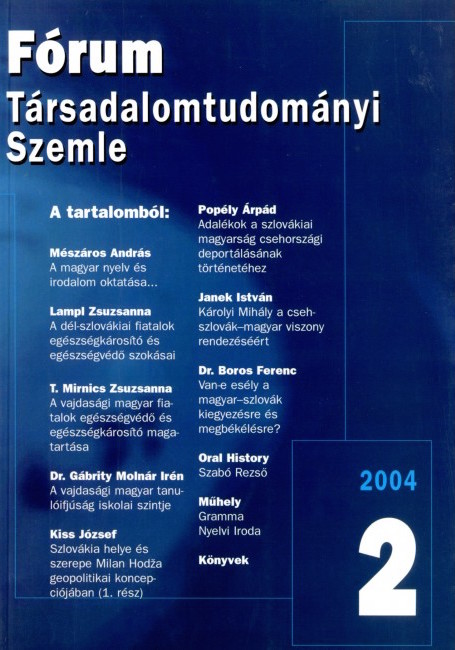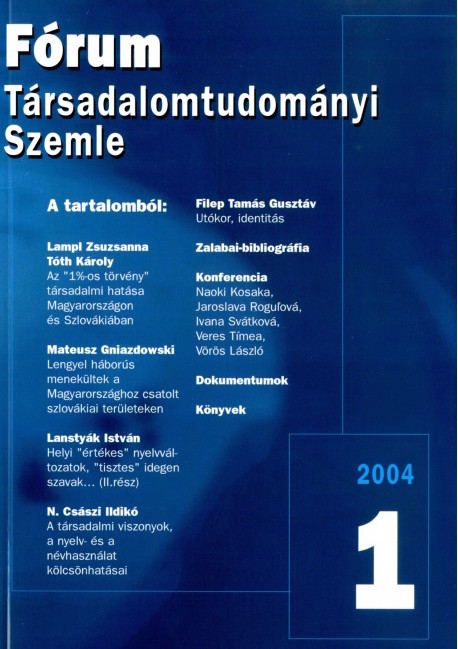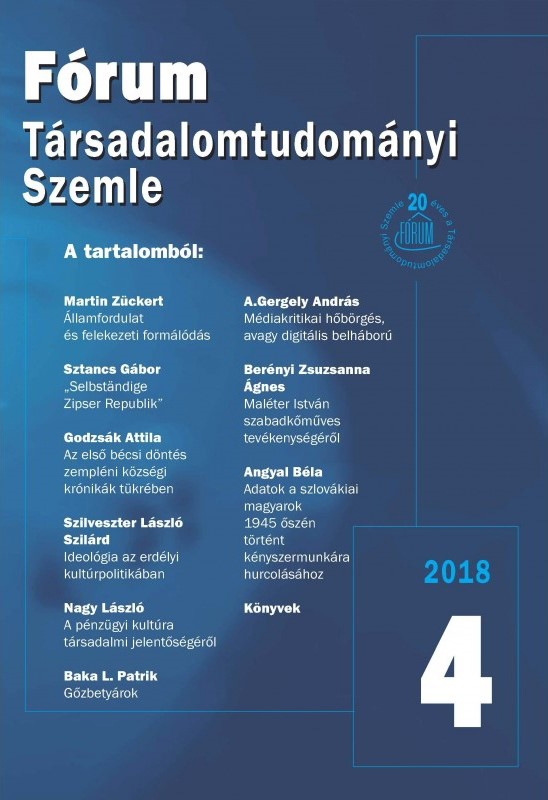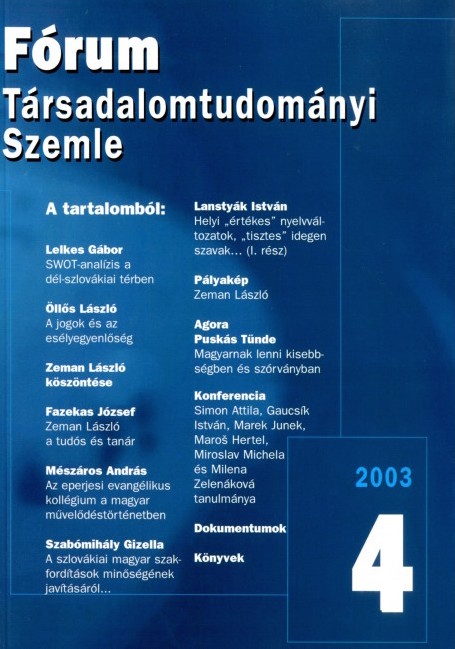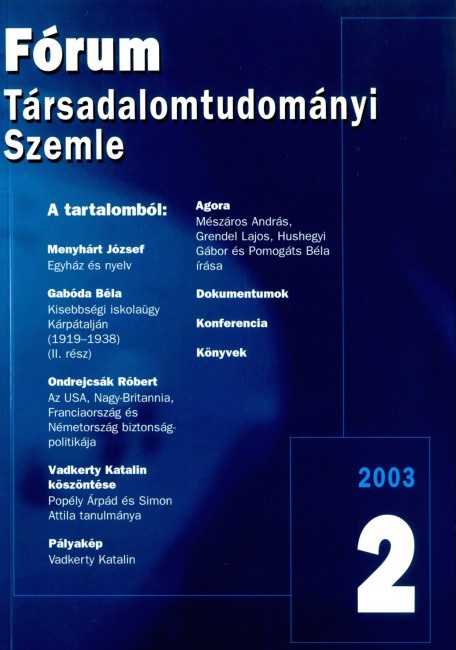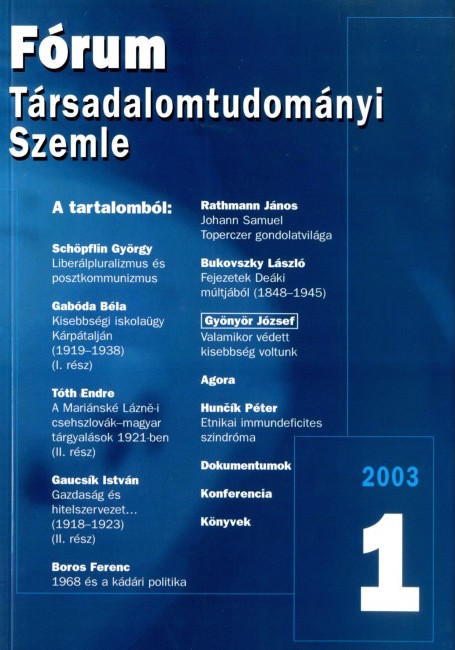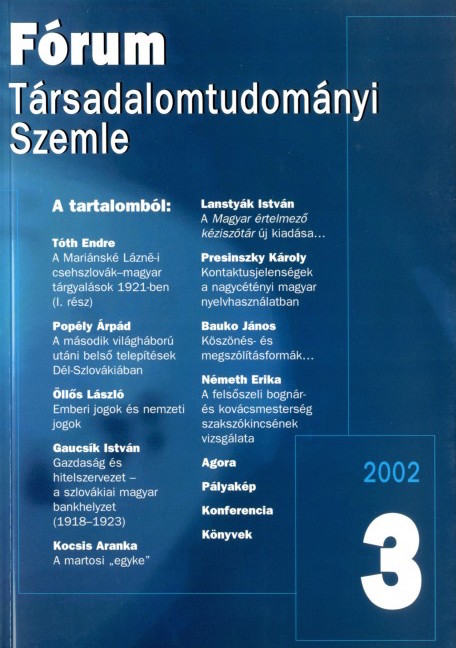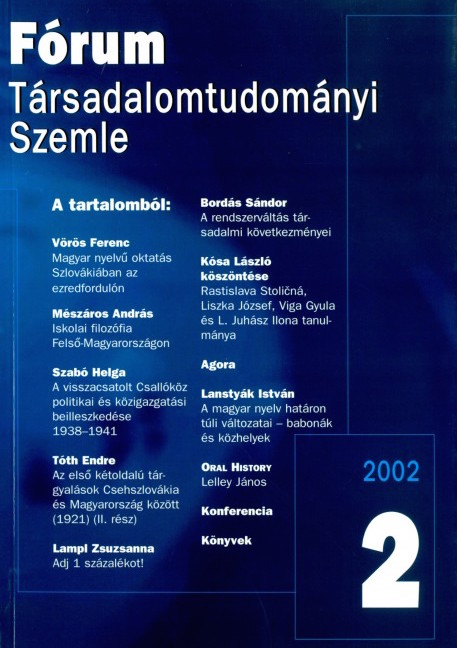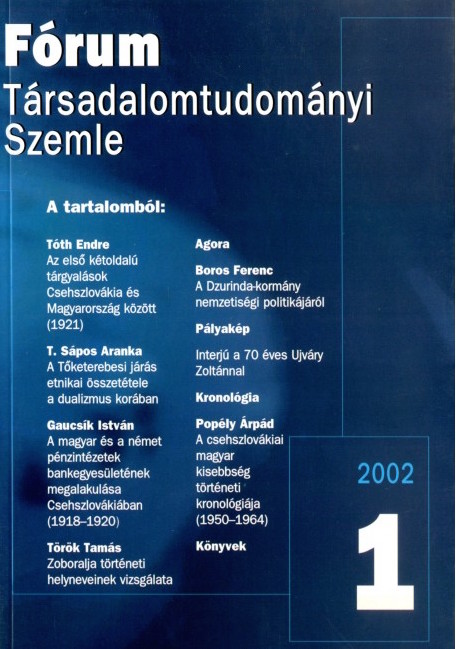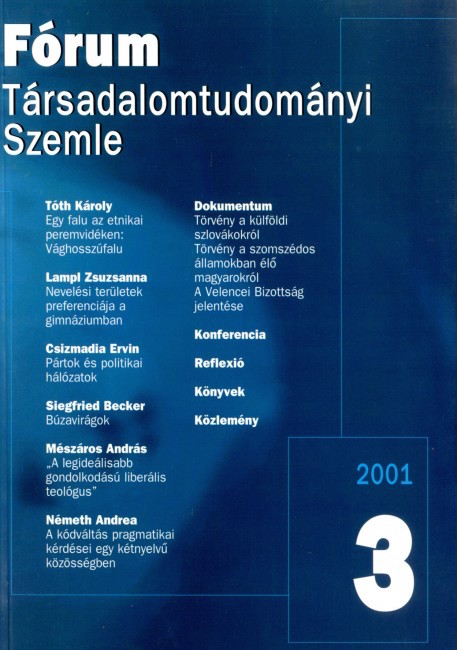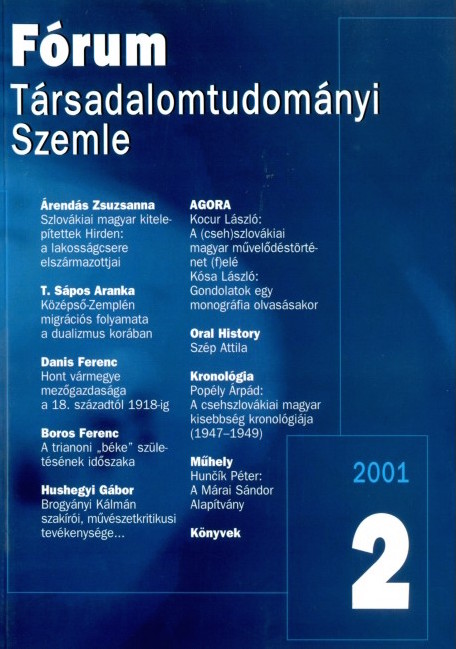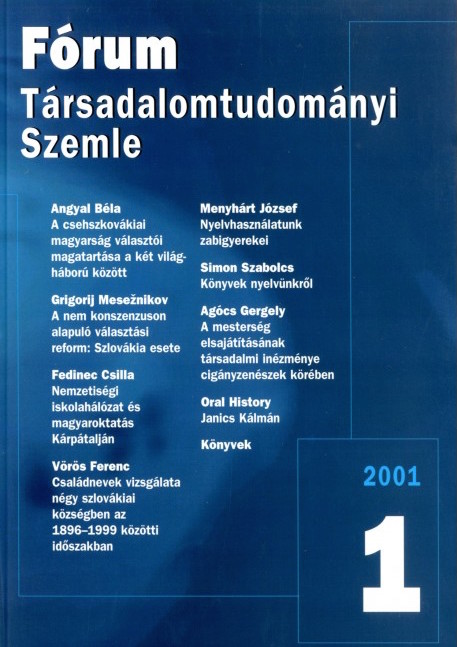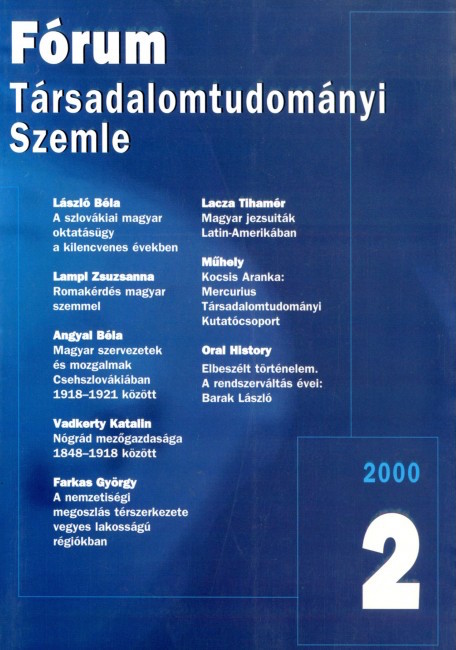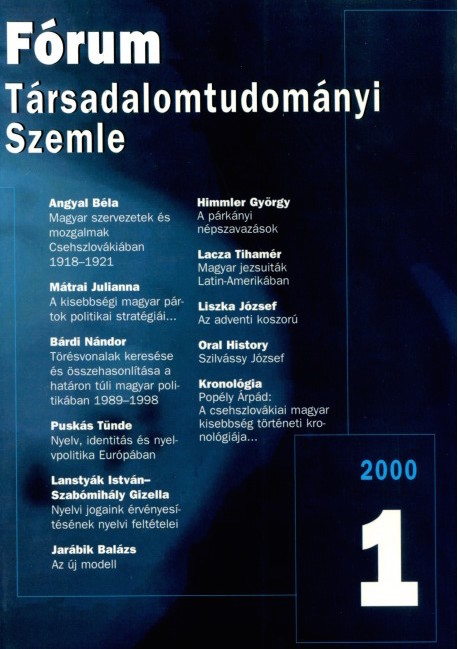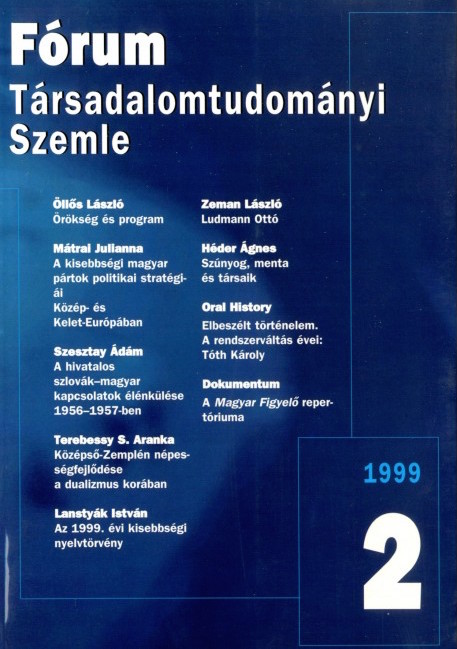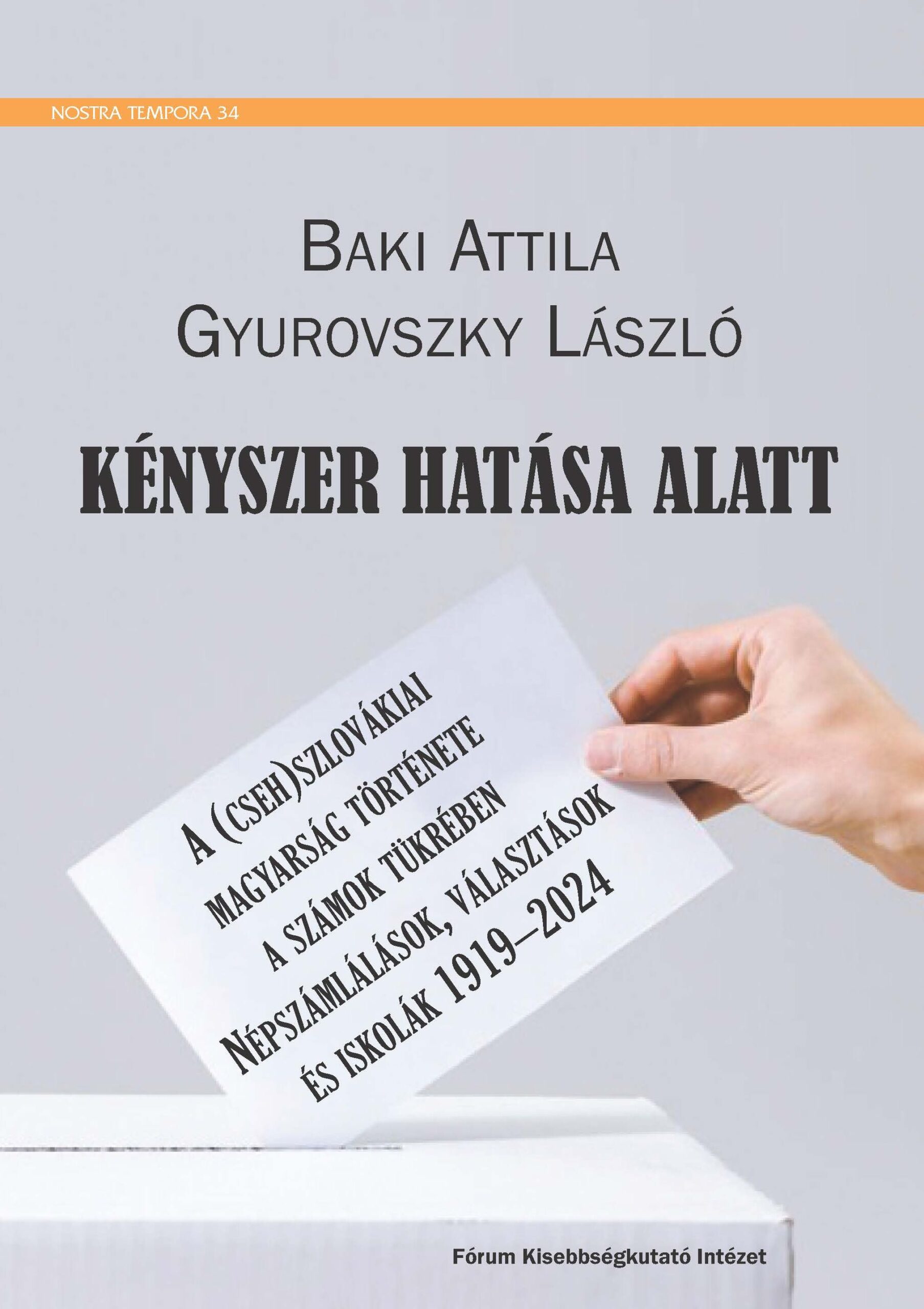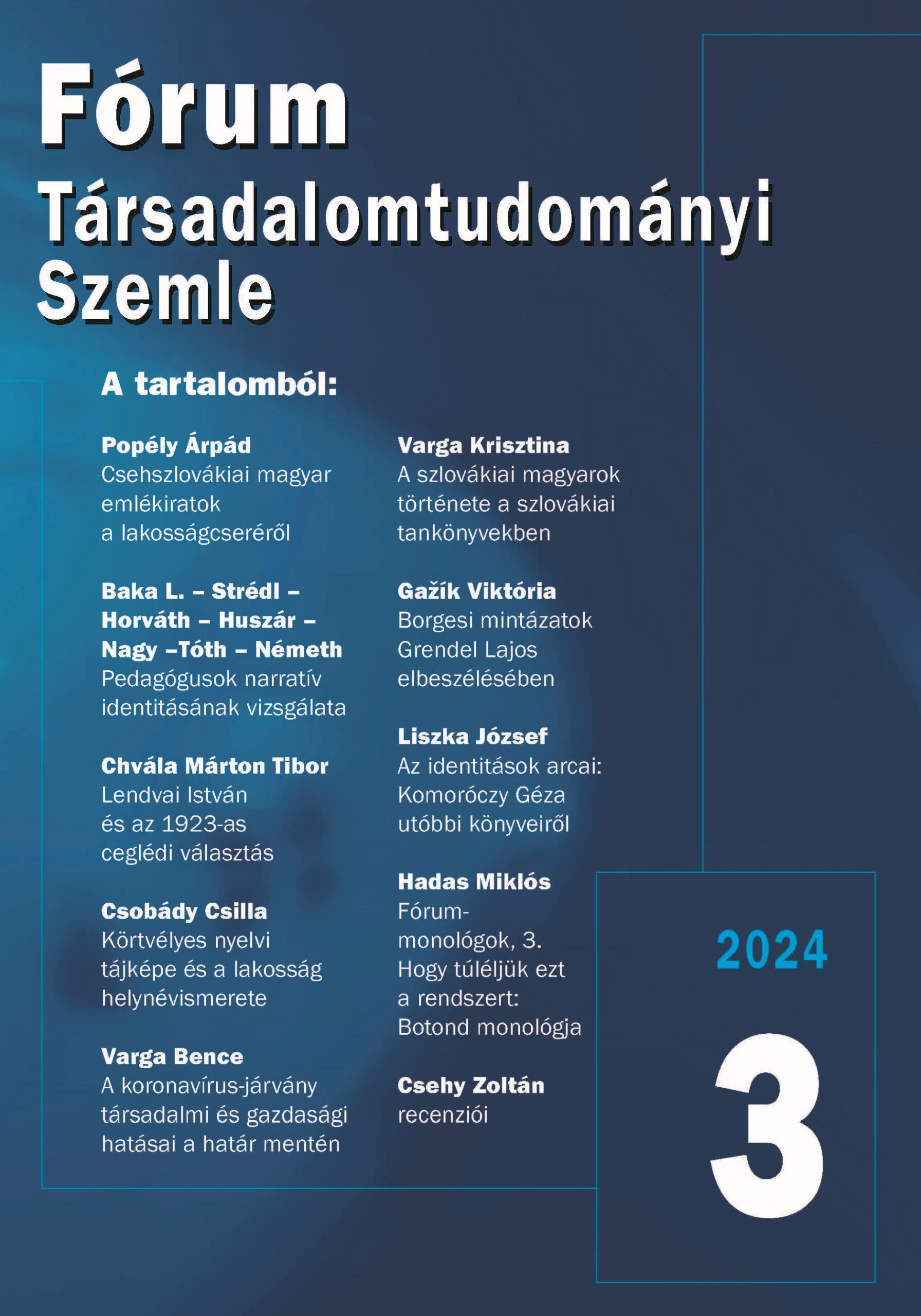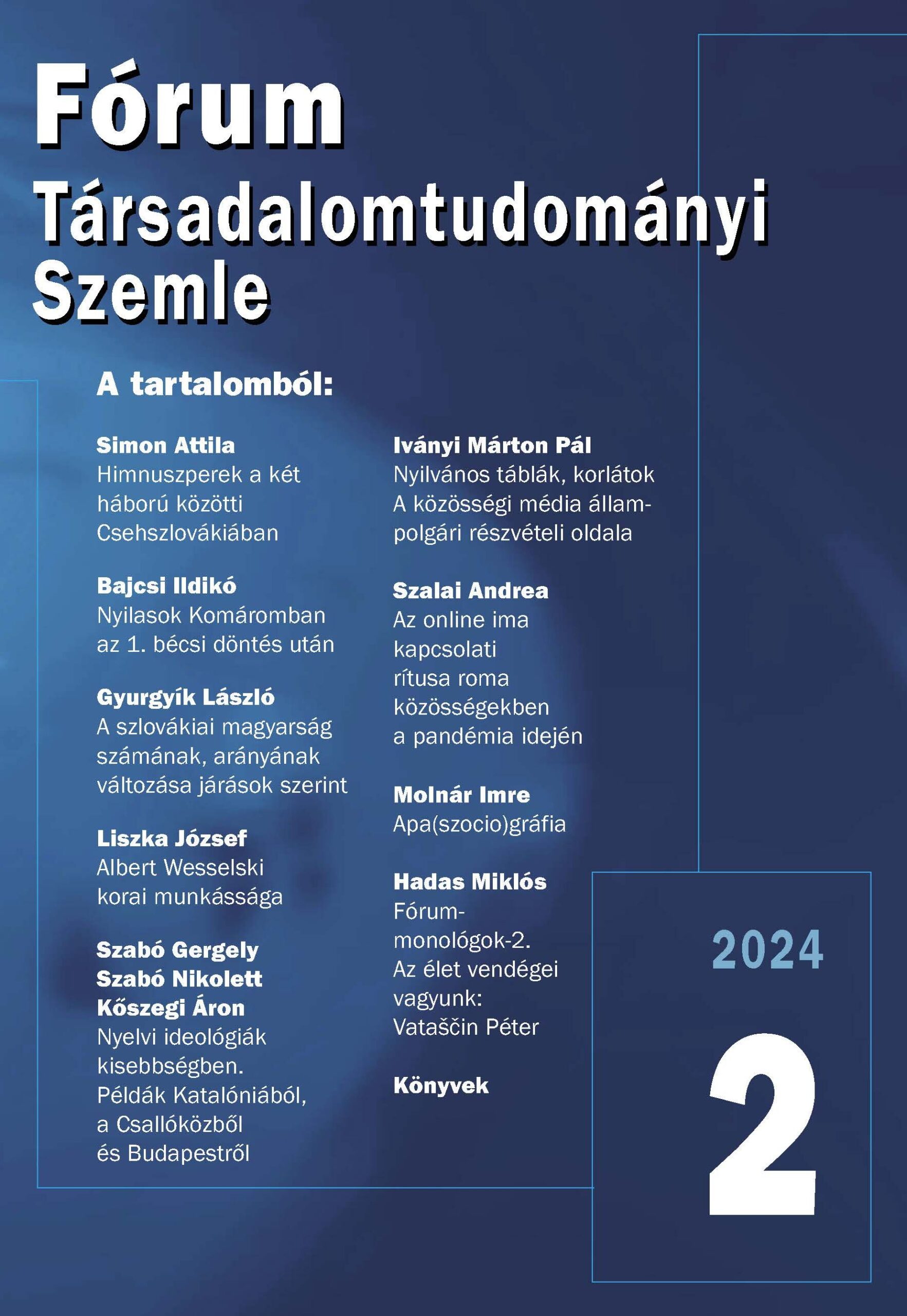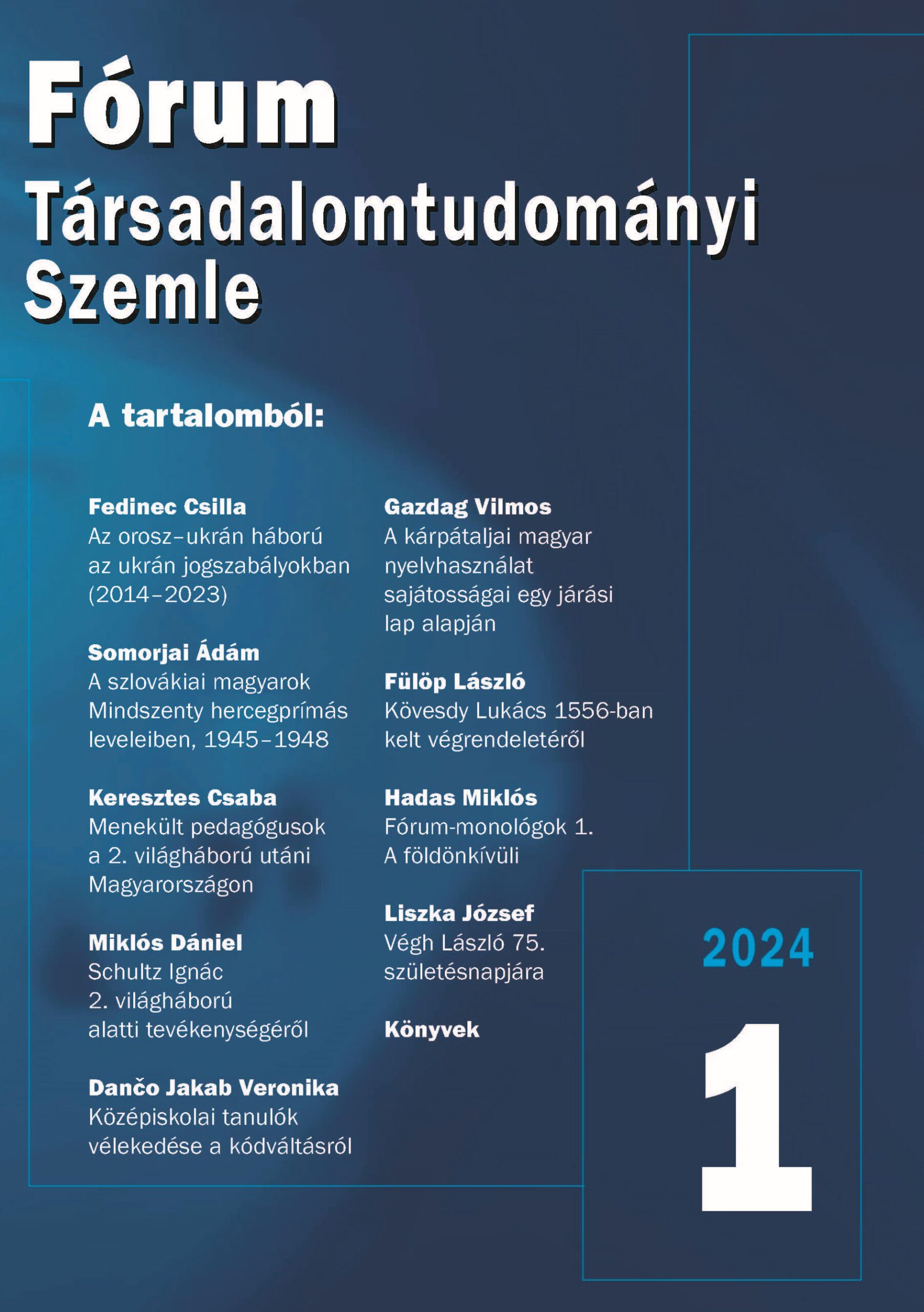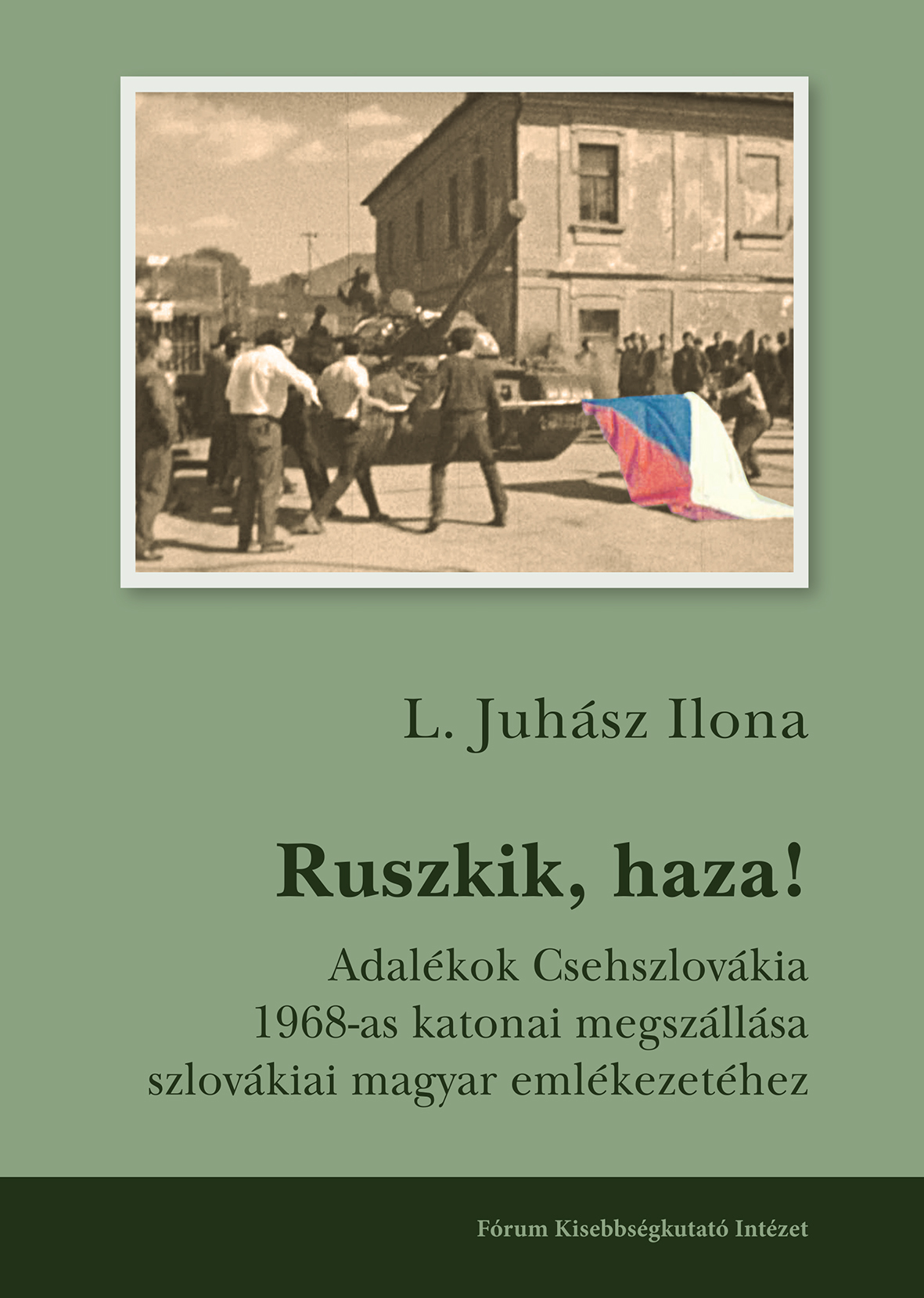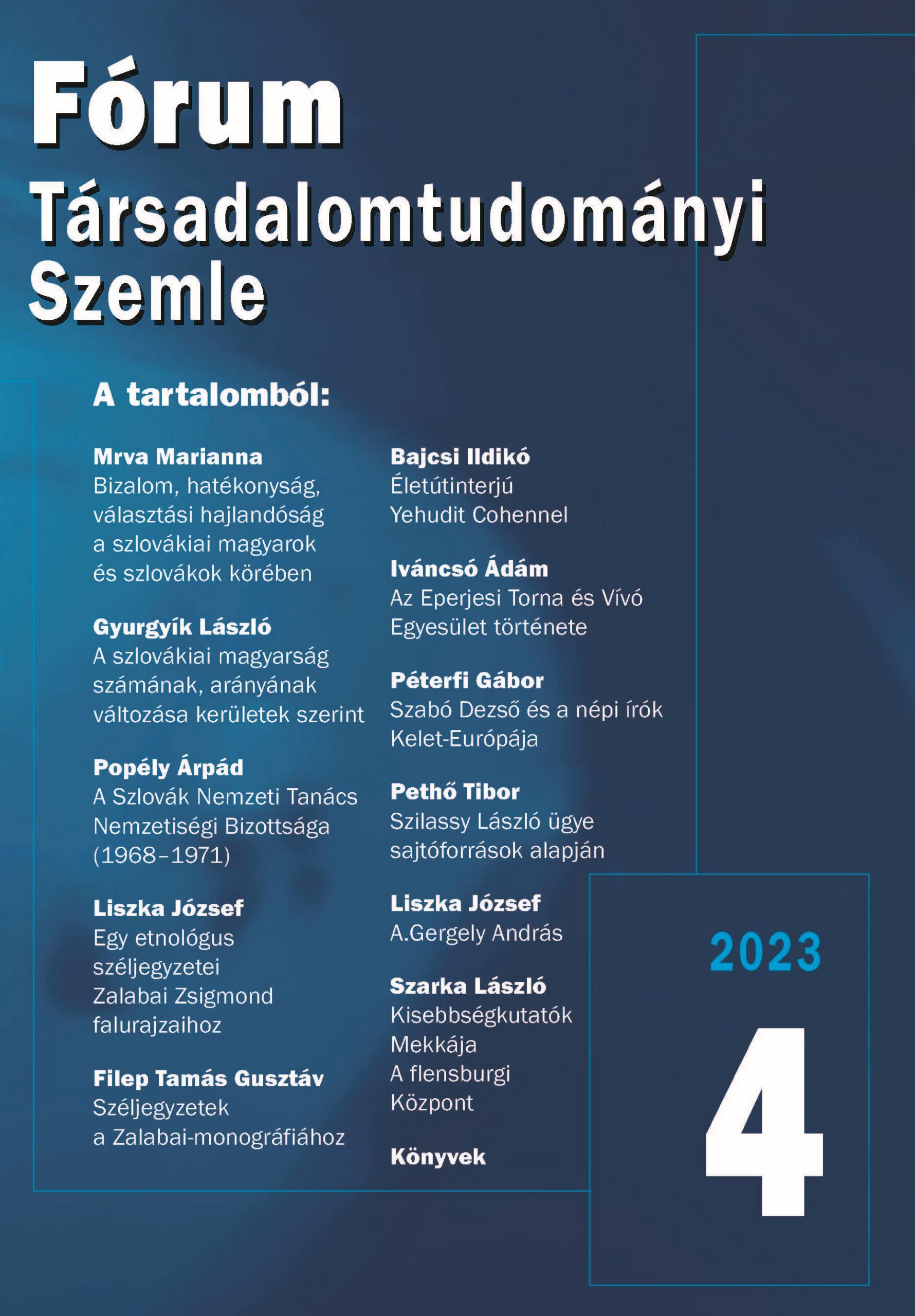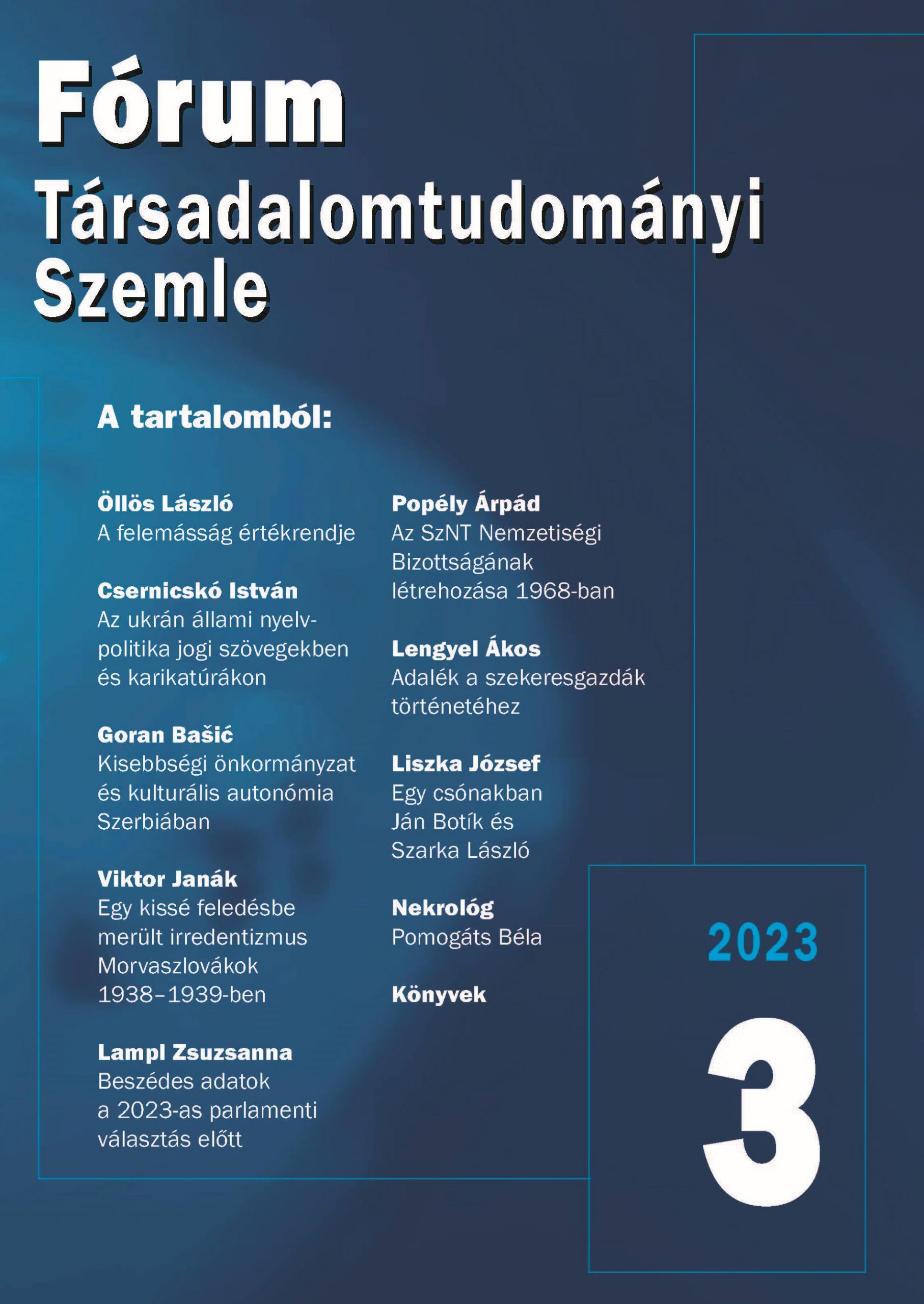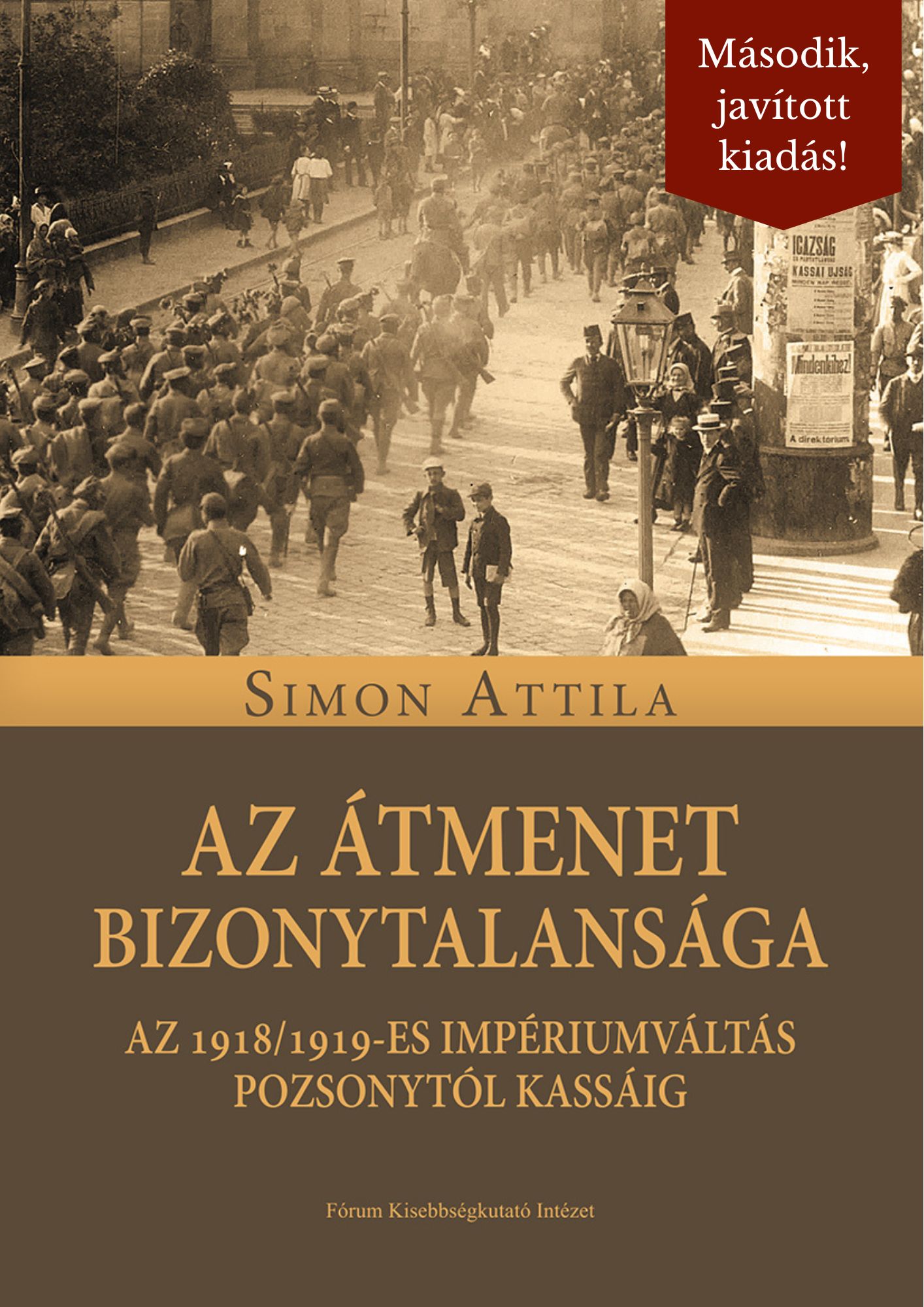Imprint 2023/5
FÓRUM TÁRSADALOMTUDOMÁNYI SZEMLE
FORUM SOCIAL SCIENCES REVIEW
ANNUAL SCIENTIFIC JOURNAL IN ENGLISH LANGUAGE
Volume XXV (2023)
Editor: BARNABÁS VAJDA
Head of the Editorial Board: LÁSZLÓ ÖLLÖS
Members of the Editorial Board
Zoltán Biró A. (Romania), Gábor Csanda (Slovakia), Zsuzsa Csergő (Canada), István Csernicskó (Ukraine), Csilla Fedinec (Hungary), Holger Fischer (Germany), Susan Gal (USA), László Gyurgyík (Slovakia), Péter Hunčík (Slovakia), Zsolt K. Lengyel (Germany), Attila Kovács (Slovenia), Ferenc Laczkó (The Netherlands), Petteri Laihonen (Finland), Zsuzsanna Lampl (Slovakia), István Lanstyák (Slovakia), József Liszka (Slovakia), András Mészáros (Slovakia), Attila Simon (Slovakia), László Szarka (Hungary), Andrej Tóth (Czech Republic), Barnabás Vajda (Slovakia), László Végh (Slovakia)
English translation and proofreading: László Zala
Content
Studies
ÖLLÖS, LÁSZLÓ: The Value System of Unevenness
LAMPL, ZSUZSANNA: The “ideal with great appeal” or the emergence and development of leisure time in Czechoslovakia (among other countries)
GAUČÍK, ŠTEFAN: The Bourgeoisie, Armalists, Aristocrats. Entrepreneurial Strategies in the Iron Industry in Gemer (1780–1881)
FEDINEC, CSILLA: Attempts of self-determination by the Carpathian Rusyns in the 1860s.
EGED, ALICE: To make stew, you need a hare, and to establish a monarchy, you need a king. Former Crown Prince Wilhelm II’s relationship with the National Socialist movement during the 1932 German presidential election
Central European Forum
SZARKA, LÁSZLÓ: Minority Research Journals in Slovakia and Hungary
Book reviews
Liszka, József: Monumentumok: Szakrális (és „szakrális”) kisemlékek a Kárpát-medencében. [Monuments. Sacred (and “sacred”) small relics in the Carpathian Basin]. Komárom–Somorja, Fórum Kisebbségkutató Intézet–Etnológiai Központ. Reviewed by Attila Terbócs
Szeghy-Gayer, Veronika: Tost László, Kassa polgármestere [László Tost, Mayor of Košice]. Reviewed by Štefan Gaučík
Bajcsi, Ildikó: Nemzethűség és őrségváltás. A komáromi és környékbeli zsidóság jogfosztása (1938–1944) [National Loyalty and Changing the Guard. The Disenfranchisement of the Jews of Komárom and the Surrounding Area (1938–1944)]. Reviewed by Gábor Hollósi
The Value System of Unevenness
DOI: https://doi.org/10.61795/fssr.v25y2023i5.01
To transform unevenness into a moral concept deserving defense and preservation, compelling arguments are imperative. The core of unevenness lies in the assertion that the components of underdevelopment hold greater value than the state of progress.[1]
For this shift to occur, the state of progress must be perceived as a precursor to decline and deterioration. Furthermore, even if downfall does not occur, one should not doubt the forecast of future downfall. Since every advanced culture faces a crisis at some point, who can question that the present one will also face trouble in the future? Moreover, it is possible that its current state is indeed the beginning of its crisis.
However, what unevenness lacks is the way it can advance to the forefront of development. Critiques directed at more advanced cultures are not accompanied by real alternative development strategies. Instead, they attempt to mobilize through prophetic visions, without producing well-defined, achievable, and quantifiable programs.
The ideological defense of underdevelopment is intricately linked to the defense of those responsible for it. If they are not the cause of underdevelopment but, instead, obstruct others from venturing down the path of decline, then their actions may be attributed as morally commendable. Consequently, they uphold a moral prerogative to either retain or regain power. A visionary perspective and fervent political identity are crucial for upholding the unverifiability of this assertion, alongside fervent emotional attachments taking precedence over reason, and tightly controlled vested interests.[2]
Emotions primarily revolve around national sentiments. They are nurtured through the continuous reinforcement of the feelings associated with a wounded national identity. The objective is not to alleviate the feeling of being offended but to amplify the suffering and fortify the perception of injured pride.
Nonetheless, the core of Central European unevenness encompasses not only a relative disconnect from the more developed Western regions but also a distancing from the even less developed East. Unlike the Eastern empires, they perceive themselves as Western and, consequently, as more advanced. Despite the presence of numerous cultural attributes, including elements of their political culture influenced by the East, they have never regarded themselves as belonging to the Eastern sphere because with that, they should have acknowledged the naturalness and legitimacy of their recurrent subjugation to Eastern powers. While some of their leaders may have promoted this ideology, they were aware that their society had no desire to become either Turkish or Russian, nor did it seek to assimilate into these empires. Apart from a few, they themselves were not fully inclined towards this outcome, even though they lent their support to the dominion of these empires and propagated various facets of their culture through the authority received from their conquering rulers.
Nonetheless, the architects of this uneven separation face yet another challenge: they must also distinguish their societies from each other. When dealing with Eastern conquerors, they position themselves as more Eastern, embracing a more communist, pro-Russian stance. If the conquering power hails from the West, such as National Socialist Germany, they endeavor to present themselves as more pro-German than their neighbors. During their alignments with the democratic West, they make a conscious effort to appear more Western, which often results in pushing back against their neighboring nations.[3] Furthermore, when they simultaneously gravitate toward both the East and the West, they employ distinct arguments and approaches for each. It can even be a multipronged strategy, as some Central European countries may seek alignment with more than two powers.
In such a situation, the objective is not to mitigate the unevenness but to perpetuate it as a political and cultural goal. Otherwise, one would need to reckon with the power-related, economic, and cultural implications of this dual nature. This pertains to how the foremost outcome of this power play is not regional autonomy, but rather the region’s subjugation under the guise of national conflicts. They disassemble the formerly unified economic landscape and establish functional units that rely on the currently dominant power. This occurred in the 20th century, an era when even nations once considered powerful discovered that their markets had diminished in size.
In an era of market expansion through colonization, breaking down the previously large market into smaller units means strengthening the dependence of the smaller ones. This, however, must be substantiated.
Furthermore, from a cultural standpoint, those who were previously closely interconnected must also be set apart from one another. The cornerstone of this division is linguistic. They aim to accomplish this by establishing linguistic dominance. As a result, schools predominantly mandate that minorities learn the language of the majority, rather than vice versa, even in regions where they coexist. The other language becomes a tool of oppression, as the two languages are not considered equal. In our case, with the end of the Austro-Hungarian Monarchy, it was not linguistic parity that followed the dominant Hungarian; instead, it was the ascendancy of the dominant Slovak (along with Czech).
In this context, the capacity of individuals within the emerging national majority to independently develop their understanding of the neighboring culture, public life, and the perspectives of their politicians diminishes rapidly. In essence, their own national dominance serves to isolate them from the others.
Another critical element, or rather argument, of cultural separation is the creation of an enemy. The past of the other side is portrayed in such a way that fellow nationals perceive the path of the national struggle as the sole viable option. Achieving this would be challenging without linguistic separation. If a significant part of the majority understood the language of the minority, they could acquaint themselves with shared histori cal events that served the interest of all. However, the injustices and inhuman actions committed by their own side could not be concealed or misinterpreted. They could directly, without any domestic interpretation and misrepresentation, get to know the present views, positions, suggestions, and initiatives of the nationals on the other side.
Their public opinions would overlap, forming a shared public opinion to some extent.[4] Thus, the possibilities for stirring up nationalistic emotions and manipulation would be constrained, and as a result, the ruling elite would find it much more challenging to militarize their own national public opinion.
Moreover, the convergence of public opinions would have another significant consequence. The network of direct connections between members of different nations could become much denser than in the case of cultural separation based on creating an enemy. This would not only involve interest-based economic relations but also the entire spectrum of the human connections.
This sets an example not of regional multiculturalism but rather of separation from those declared as national enemies. (Someone, who publicly identifies as Slovak but speaks Hungarian and is knowledgeable about Hungarian culture becomes nationally suspicious and thus less valuable.) In the value system of the national struggle, anyone who loves, or even just could love, the enemy ranks lower on the hierarchy of values in the fight, as they become suspicious. A person loyal to their nation does not speak the other’s language even if they could, but instead compels the other to use the dominant language. They do not emphasize the values of the other culture but rather highlight how much more valuable their own is.
The expectation of mutual assistance arises primarily when it aligns with their own interests.[5] They do not perceive themselves as accountable for the well-being of the other party unless it involves a conflict. Alliances are established based on shared interests and within the confines of these interests.[6] However, relationships founded on publicly declared responsibility for the other party do not develop, even though their decisions clearly exert a significant, sometimes decisive, impact on the present and future of neighboring nations.
Turning the shifting of responsibility into a societal value has become the primary reason for the lack of solidarity within the European Union. The country’s political leadership and a substantial portion of the population primarily regard EU accession as a means to advance their interests. Many struggle to envision this issue in any other way, while others are interested in ensuring that they do not embrace a different perspective.
Prioritizing the assertion of national interests as the supreme value, however, undermines and raises doubts about universal values (Kant 1995: 85).
Central Europe
The theorists promoting unity among the small Central European nations have recognized the valuable qualities these nations share, particularly those they have borrowed from one another. This highlights the potential benefits of discontinuing hostilities and rekindling cooperation.
Nevertheless, the thesis that, after 1989, the experience of communism and the region’s Nazi and Soviet occupations would awaken the democracies of the Central European small nations to cease their previous national struggles and, by establishing national peace in their states, provide full national freedom and equality for their minorities,[7] did not prove to be true.
Instead, it became clear that many former supporters and adherents of the old dictatorship attempted to utilize the tools of national conflict. While not entirely surprising, this outcome was inconsistent with the assumption of the thesis that those seeking to replace the communist dictatorship with constitutional democracy would also aim to redefine those concepts of nation and state that had long subjugated the entire region. However, this redefinition only occurred to a limited extent.
In each nation, there were individuals who aspired to such change, and some of them even assumed prominent roles in the regional revolutions.[8] Nevertheless, among the opponents of communism, there were many who continued to view the region in the same old way, adjusting only to adapt to the new international order.[9] Essentially, they had no inclination to modify their views, and it is doubtful they were even capable of doing so. Furthermore, in the relationship between Hungarians and Slovaks, the legacies of national aggressiveness, which were present not only before but also during the communist era, persisted after 1989. For the Slovaks, this involved elements of Husák’s nation-building and their sociological implications.
A new identity did emerge, but it existed only in certain aspects. Only few elements existed of this complex identity that could have supplanted the deeply entrenched national sentiments arising from inter-group conflicts. However, these aspects remain underrecognized by the various national public opinions. One of the more well-known aspects is the concept of shared interests.[10]
However, the absence of a new, comprehensive Central European, including a shared Slovak-Hungarian identity, allows the dominance of the previous national hostilities-based self-perception to persist. Something new is needed for the new identity.
Mere modifications to some of the old elements will not suffice.
Critique of the old is necessary, of course,[11] but stable and enduring common interests are also required. The recognition of shared interests is gradually growing, as evidenced by the creation of the Visegrád Group and the continuous reinforcement of their cooperation. Nevertheless, this partnership does not encompass the full range of shared values. While the parties collaborate in several vital areas, there is still a lack of profound understanding and mutual appreciation among them.
When it comes to criticism of the past,[12] these nations often avoid discussing the national injustices they themselves have caused or merely touch upon them, reluctant to draw conclusions that might challenge their core value systems.
One glaringly tacit example is the public silence of two countries that are perhaps closest to each other in their interests, the Czech Republic and Slovakia, on the expulsion of Czechs from the Slovak state that was formed before World War II. If the injustice of this were to become a significant topic in public discourse, it would inevitably raise questions about how to evaluate the expulsion of Germans and Hungarians. This is why they, and the Czechs too, choose to remain silent about it, likely because the expulsion of around three million Germans from the Czech Republic involves far bigger numbers.
Such behavior makes a person of good judgment distrust the other party. Their interests are momentary. They can be factored in, but expecting more is foolish and even naive.
However, if the cultural value system remains largely unchanged, the behavior of these countries will also follow suit. As long as the prevailing values of national relativism persist, their cooperation will remain contingent on serving their immediate interests. While interest-driven cooperation seems sufficient in the current context, it would likely prove insufficient in a crisis demanding substantial risk and sacrifice, or when substantial conflicts arise. The parties involved are aware of this, and in addition to the areas of cooperation, they continue to build or maintain various forms of great power support that can be deployed against their neighboring nations when the need arises.[13] In other words, there is no genuine shared destiny. The European Union refrains from substantial intervention in the Hungarian– Slovak relationship. It lacks the necessary norms and legal framework for such involvement, and it has no intention of pursuing such an avenue. Any such attempt could disrupt the current tacit agreement among the parties where they tolerate each other’s national injustices, following the French model, for example.[14] Thus, an involvement would jeopardize the status quo, and with it, the present-day European Union.
Due to this, the European Union emphasizes its respect for the national identities of its member states. In practice, this translates to non-interference. The EU and its constituent member states have not created any shared system of norms that would affect the core national identity. Clearly, they have no plans to do so. However, everything can be preserved that has accumulated, during the past and present struggles, in the identity of each country’s citizens and nations. This situation, however, does not constitute true national harmony.
The foundation of reconciliation is the desire for peace on the part of the parties involved. This also implies that they must willingly abandon the arsenal of warfare. As a first step, they must scrutinize all the views and actions aimed at defeating and destroying the other party, sometimes even seeking national and, in extreme cases, physical annihilation, both in the past and present. These views must be criticized because aggressive ideologies have driven the formulation of these views, motivated by national conflicts rather than the pursuit of truth. Their primary objective is national mobilization, not the critical presentation of reality.[15] Their measure of success is national victory over the other party, not a benchmark of human progress, universal human freedom and rights, or even universal national freedom.[16] Instead, the yardstick is the advancement of their own nation over the other (Kant 1995: 85).
This moral standard is at odds with universal human values at every turn. The recurring and often glaring contradictions need to be resolved. Therefore, answers must be provided for the acts committed in the name of the nation, such as the killing and deportation of the national enemy, as well as the deprivation of their freedom and fundamental rights. It is also necessary to explain why the same national rights are revoked from those labeled as national enemies, rights for which the predecessors of the present majority fought and which they now consider to be the most just and glorious phase of their national history.[17] Furthermore, it is essential to justify the contempt and disdain directed toward those they perceive as their national enemies.
The solution is relativization, a concept well-known in the history of ideas.[18] It involves challenging the universality of universal human values and demonstrating that their significance is context-dependent and situational. This suggests that their value and validity are relative.[19] However, the examination of the national freedom of individual citizens does not end there; it extends to various aspects of the fundamental human rights upon which the state is built. Moreover, it significantly curtails the natio nal freedom of those who are part of the national majority.
The national freedom of the majority seems to be assured. Their language holds the status of an official language, their traditions prevail, their culture dominates, and their influence is pervasive throughout the state. They even symbolically manifest this dominance, with state symbols reflecting their own image. However, if they decide to employ these elements to hinder the parallel national aspirations of their fellow citizens belonging to different nationalities, they must distort each abovementioned tool.
The argument used to relativize national freedom and oppress minorities significantly contributes to the confusion of the value systems of various political ideologies.
The left is also compelled to engage in the relative interpretation of human rights.[20] In countries undergoing transformation, the desire to suppress other nations involves va rious elements that shape the new left within this context. It encompasses the Jacobin tradition of unification, presupposing the subordination of all to a single political code based on the general will, a thesis reminiscent of Rousseau. The author later adds the ritual reverence of common traditions to this code.[21] It can be concluded that the Jacobin tradition appears in a post-Leninist form in former communist countries.
The ultimate law is therefore the law of war. However, to accomplish this, the past must be viewed in a similar manner. One possible way to evaluate it is by categorizing history into positive and negative periods based on the growth or decline of national power.[22] In this framework, a period of a nation’s history is considered positive when it involves an increase in population, territorial expansion, or international influence, while the opposite is seen as negative. This evaluation remains unaffected even if the nation achieved its goals during a positive period by aligning with regressive forces, and even if they subjugated other nationalities during their expansion, either in their own territories or through alliances with those building their states by oppressing their national minorities.[23] This evaluation does not consider the quest for dominance over others. It measures national greatness solely by the extent of power, not the fate of the subjugated or their relationship to social progress. This has always been the case. The conquest of others rarely triggers a social debate leading to a significant portion of the political community questioning the moral basis of its own achieved national greatness, or the rightness of subjugating others (Habermas 2005).
In such cases, national and democratic principles almost entirely diverge from each other, with the one labeled as “national” becoming the ultimate moral yardstick (Kant 1995). The essence of the Central European dilemma lies precisely in this contradiction. This contradiction has several consequences, which not only contribute to its perpetuation but further strengthen it.
The first consequence in our list is of a political-sociological nature. Maintaining and utilizing this contradiction has placed in positions of power individuals who have a vested interest in its preservation. For example, those who themselves benefited from confiscated assets cannot be expected to wish to clarify the post-World War II expulsions. Similarly, criticism of fascist or communist pasts is not expected from those who owe their careers to these regimes. Furthermore, this extends to a part of the most cri tical and intellectual segments of society, as ideologies are also necessary to restrict the national freedom of others.
Unevenness
The underdevelopment behind the advanced West has, anyway, turned the countries of the region into a kind of transitional space. Underdevelopment and the back-and-forth between the East and West are also self-justifying. They create the morality of unevenness, and this morality naturally takes root in politics. Its essence lies in the fact that political unevenness, behavior that is neither truly Eastern nor truly Western, is not a flaw but a virtue. Therefore, elements of the political system that differ from those of Western democracies are useful and necessary. They protect against Eastern despotism and Western decadence. Neither the one nor the other poses a mortal danger to the existence of these small nations. (Either way, they must continue their constant struggle for survival.)
This mindset also shapes the particular role of nationalism in our region (Szűcs 1974: 31). Here, national identity must justify not only its well-known functions further west but also the unevenness of the state and society. Moreover, since national identity is the dominant identity of our time, it plays an irreplaceable role in this endeavor.
National identity must become the supreme value in such a way that it can also justify backwardness. Therefore, elevating the national identity above universal human values should not only happen because of the struggle against others. Otherwise, the level of freedom and equality and the development of society would be the primary values. It needs to be justified why it is necessary to restrict the national freedom of the country’s citizens of other ethnicities, why it is good for the state to hinder their national equality, and why it is important and right for the majority’s culture to be dominant, while the culture of others is subordinate. The ideology of centralized power for national reasons can be built on this justification. Of course, the ideology must be based on a national sense of danger. The central importance of the national peril simultaneously defines the scope of those conceptions of nationality that are suitable for strengthening this passion.[24]
Taking into account the processes of globalization and the EU’s loss of space, the morality of national unevenness can also spread among the nations of Western Europe if they attempt to justify their own gradual decline.
Critical aspects
The ideology of nationalism cannot be independent of the value system of the Enlightenment because it is also a product of that era. It involves a complex identity that, in many ways, resembles the dominance of earlier prevailing self-perception, namely religious identity.[25] The Enlightenment is, to a significant extent, the ideology of the continent’s renewal precisely due to its critique of the political role of the church and many tenets of religion. The Thirty Years’ War showed that religious identity is not only incapable of preventing major social catastrophes but also serves as the ideological basis for one of the most devastating wars.[26]
One of the most crucial questions of our time is whether European intellectualism will be capable of finding a solution to the problem posed by the aggressive elements of nationalism that underlay the two world conflagrations of the 20th century. The success or failure of the experiment is a fundamental problem not only for the world, but for the Europe that created the idea of nationalism. It is precisely through these two wars that the states of our continent are losing their former dominant position in the world and are becoming secondary, and sometimes even tertiary, actors (CoudenhoveKalergi 1988: 9–12). Without pointing out the flaws of the prevailing ideology in these wars, we should articulate their essence, and then, arising from criticism, outline the foundations of an ideology that, even if covertly, continues to shape the 20th century (Skalnik Leff 2016: 318).
In the European Union, throughout its history, a tacit set of rules have established the boundaries for critically evaluating previous crisis periods. According to this, the ideologies of fascism and communism must be universally criticized, but it is politically inappropriate to address the current aggressive nationalism of member states. As per these rules, anyone who criticizes aggressive nationalism against minorities in another member state and advocates for the resolution of the situation, the granting of rights, and the redress of grievances of the affected, typically their own minorities, is consi dered a nationalist and, therefore, suspicious. The primary weakness of this system of rules does not lie in the incorrect stance because one could expose the wrongness of a stance in a public debate. Instead, it lies in silence, in the elevation of silence as a moral value. Through silence, public debate becomes precisely incorrect.
Moreover, silence, as history has repeatedly shown, does not silence the supporters of national aggression. They continue to voice and act upon their views. Silence, however, silences their critics and those affected, those who suffer the consequences of aggression. This is how the obligation of silence makes them suspicious, and it can be claimed that they, through their outspokenness, endanger European peace and balance, as opposed to those who disregard their rights.
It can be implied that they may ultimately be seeking to disrupt their countries because they are unwilling to remain silent during an era that either promises prosperity or is marked by challenges. Consequently, one should approach their critical statements and national demands with great caution and avoid putting excessive pressure on their countries’ leaders. The primary objective is to maintain a delicate balance rather than address the core issue,[27] which involves changing the value system based on the majority’s exclusivity, fostering unity and diversity among citizens, and, of course, guaranteeing the national freedom and equality of the affected minorities.
Without political debates about the current aggressive nationalisms, those views and prejudices on which individual national aggressions rely do not change. Without change, they continue to exist and resurface in every critical situation.[28]
Literature
Barnard, Frederick M. 1988. Self-Direction and Political Legitimacy – Rousseau and Herder. Oxford, Clarendon Press.
Bibó, István 1986. A kelet-európai kisállamok nyomorúsága. In: Bibó, István: Válogatott tanulmányok, Második kötet 1945—1949. Budapest, Magvető Könyvkiadó.
Breully, John 1998. The Nationalism and the State. Manchester, Manchester University Press.
Coudenhove-Kalergi, Richard 1988. Pan-Europe. Paris, Presses Universitaires de France.
Deutsch, Karl W. 1966. Nationalism and Social Communication: An Inquiry into the Foundations of Nationality. Paperback – June 15, MIT Press.
Dunn, John 1979. Nationalism. Western Political Theory in the Face of the Future. New York, Cambridge University Press.
Habermas, Jürgen 2005. A szabadelvű állam politika előtti morális alapjai. Jürgen Habermas és Joseph Ratzinger eszmecseréje a müncheni Katolikus Akadémián 2004. január 19én. Holmi, 17/11, 1393–1407.
Józwiak, Veronika 2019. A V4-ek hangja az Európai Unióban. In: Stepper, Péter (ed.): KözépEurópa és a Visegrádi Együttműködés. Budapest, Antall József Tudásközpont.
Kant, Immanuel 1997. Történetfilozófiai írások. Budapest, Ictus.
Kedourie, Elie 2000. Nationalism. Oxford, Blacwell Publishers Ltd.
Kis, János 1987. Tágabb összefüggések. Beszélő, (2.). 1/21. http://beszelo.c3.hu/cikkek/ tagabb-osszefuggesek.
Kymlicka, Will 1995. Multicultural Citizenship. Oxford, Clarendon Press.
McMahan, Jeff 1997. The Limits of National Partiality. In McKim, Robert–McMahan, Jeff (eds.): The Morality of Nationalism. New York–Oxford, Oxford University Press.
McRae, Kenneth D. 1986. Conflict and compromise in multilingual societies. Belgium, Waterloo, Ontario, Wilfrid Laurier University Press.
Skalnik Leff, Carol. 2016. National Conflict in Czechoslovakia. The Making and Remaking of a State, 1918-1987. Princeton University Press.
Smith, Anthony D. 1991. National Identity. London, Penguin Books.
Szakálné Szabó, Zita 2021. Harminc éve a közös úton – A Visegrádi Négyek együttműködésének politikai fejlődési íve a kezdetektől napjainkig. DOI: 10.36817/KM.2021.2.6 Külügyi Műhely, no. 2.
Szűcs, Jenő 1974. Nemzet és történelem. Budapest, Gondolat.
The “ideal with great appeal” or the emergence and development of leisure time in Czechoslovakia (among other countries)
DOI: https://doi.org/10.61795/fssr.v25y2023i5.02
Introduction
Our lives begin at a specific time, last for a certain duration, and end at a predetermined moment.[1] This grand mystery that frames our existence has given rise to numerous profound thoughts. Out of curiosity, I searched for literary quotes about time on the Internet and found 108 pages on the citatum.hu website alone, including the following: “Time […] would keep running on, in an uncountable chain of events, and one day time would erase the dark men governing us, and it would erase my parents, and it would erase me too, and it would keep running along the streets, across the squares, the whole city, leaving a whole future in its wake” (Julián Fuks, Brazilian writer, 1981–), and “Time is what is real, the best we give, and our gift is the hour-glass – indeed, ‘tis subtly narrow, that bottle neck through which the red sand runs, so hairlike its trickle that the eye beholds no diminishment in the upper chamber, and only at the very end does it appear to go fast and fast be gone” (Thomas Mann, Nobel Prize-winning German writer, 1875–1955).
From a scientific perspective, time is a multidisciplinary topic, studied in numerous fields. In sociology, Émile Durkheim set the foundational tone, imbued with lyricism, when he wrote in 1912 about time in terms of “an abstract and impersonal framework that maintains not only our individual existence but also that of humanity. It is like an endless canvas on which all duration is spread out before the mind’s eye and on which all possible events are located in relation to points of reference that are fixed and specified” (Durkheim 2003: 20). One segment of this “endless canvas,” which is human lifetime, is leisure time. I will address this aspect in my article, beginning with a brief overview of the origins of leisure time.
1. The “birth” of leisure time
The fundamental thesis posits that leisure time “becomes measurable and perceptible in relation to the time spent on activities that serve the preservation of life, expressing, in the management of time, a certain sense of freedom of a specific type of time” (Fekete 2018: 27). In simpler terms, work time and leisure time cannot be entirely se parated. This is because, firstly, both are “manifestations of the same human essence” (Szalai 1976: 11), and secondly, the quantity and content of work time significantly determine the amount and content of leisure time.
As is often the case with social phenomena, leisure time has multiple definitions, generally encompassing activities considered as taking place during leisure hours. One definition is as follows: “Leisure time is the period for relaxation, social interactions, vacations, unwinding, and replenishing physical and mental resources, organized by individuals based on their own needs, desires, values, and aspirations” (Kratochvílová 2010: 4). Methodologically, I primarily align with sociologist Sándor Szalai, a member of the Hungarian Academy of Sciences and leader of the Multinational Comparative Time Budget Research Project between 1964 and 1970. According to him, “leisure time cannot be perceived as an abstract category; it must always be defined for research purposes. It only becomes measurable and evaluable when compared to time spent on activities aimed at life maintenance (breadwinning work, mandatory social, family, household, and subsistence tasks, satisfying one’s own physiological needs, etc.)” (Szalai 1976: 13). Additionally, I would emphasize that leisure time is not only free from compulsory activities but is also freely chosen, including the selection of the time period and how that time is spent.
Drawing from the literature on leisure time, three closely related theses can be established: 1. work time and leisure time were not always sharply distinguished from one another (at least for the masses); this separation only occurred in the modern era. Consequently, 2. the phenomenon of leisure time in today’s sense, as the term itself, is a product of the modern era. 3. Leisure time has never been independent of social status; it has been decided by social class or stratum.
Throughout history, all known societies have had their own days of rest and holidays, with specific times allocated for work and rest. However, in traditional societies, the time of celebration or rest was not freely chosen and spent. In these societies, the periods of work and rest during the day were continuous and intertwined (a situation similar to what millions of people and families experienced during the pandemic when they started working from home). According to Iván Vitányi, who considered time management to be the most important criterion of lifestyle type, time management in traditional societies was governed by habit (Vitányi 2006). Time use was additive: work was primary, and other activities were supplementary, but they were also related to work. Leisure time, in today’s sense, did not exist. Yet the concept of leisure had already been defined by the ancient Greek philosophers. “It was on the soil of the great slave-holding civilizations of antiquity that the ideal of choosing activities not determined by efforts of subsistence, was first formulated. […] This ideal, in which the devaluation of useful labor became part of the ‘ideological arrogance’ of the ruling class, has a great appeal in that it idealizes a state in which energy is freed from securing the necessities of life, and thus, people engage in activities they find appealing for the sake of activity itself” (Danecki 1973: 29–30). This ideal, which characterizes leisure time today and is referred to as “personal time” in everyday discourse, was called “spare time” by ancient Greek philosophers. Aristotle, for example, understood it as a sphere of life where the formal condition is the individual’s inner and outer independence and its content is contemplation, as opposed to activities related to acquiring material wealth, which have no strictly defined goals. Leisure time was considered a privilege of the upper echelons of citizens born into freedom (Zborovszkij 1976: 23). Thus, spare time became a monopoly of a narrow elite, but at a great contradiction: “The few obtained it at the cost of converting almost the entire life of the rest into working time” (Danecki 1973: 28– 29).
The distinct separation of working time and time spent outside of work, the modern leisure time in industrial societies,[2] resulted from the radical division of workplaces and households, as well as public and private spheres. Leisure time evolved into an autonomous sphere, providing individuals with an opportunity to escape their obligations and explore self-realization.
However, this does not imply that people worked continuously without rest until the Industrial Revolution. Firstly, their endurance and tolerance were biologically determined. Secondly, the norms were related to work and rest and primarily based on religious precepts. Even within the Christian cultural sphere in Europe, the Old Testament provided instructions on time management from its first pages. The Creator himself rested on the seventh day after the demanding work of creating the world, which he blessed and sanctified (Genesis 2: 2–3). He also commanded people not to work on the seventh day, as it was a day of rest. This applied to everyone, including all members of the family, servants, domestic animals, and even “strangers within [one’s] gates” (Exodus 20: 8–11; Exodus 31: 12–13). Disobeying this commandment carried the penalty of death (Exodus 31:14–15). Thus, leisure time, in this context, applied to all, irrespective of their social status.
According to Polish sociologist Jan Danecki, in medieval Europe, and in purely agricultural societies of Asia, Africa, and Latin America in the second half of the 20th century, people had more than one-third of the year as time off from work. Sundays and church holidays made up a smaller proportion, while the rest were not freely chosen days off; they were the result of external circumstances, such as natural disasters, diseases, epidemics, unfavorable weather, or natural cycles. These were not perceived positively as they led to deteriorating living conditions. “Therefore, human efforts were generally directed at elimi nating this type of surplus time imposed by coercion in order to ensure long-term viability throughout the year and beyond (through accumulating reserves, investments, etc.)” (Danecki 1973: 32). With the advent of capitalism alongside industrial society, these surplus times were eliminated “in the most ruthless manner, using all the means of economic and non-economic coercion” (Danecki 1973: 32). Initially, several holidays were abo lished, and idleness and loafing were strongly criticized. In France, this was particularly characteristic of the Enlightenment philosophers, but Protestantism also played a significant role, as evident in Max Weber’s classic work, The Protestant Ethic and the Spirit of Capitalism. Religion and its interpretation played a pivotal role once more. The conviction that salvation depended on fulfilling one’s divine mission and placing work and duty above all else fostered the view that any pursuits outside of labor, including leisure activities, were considered wasteful and even sinful. In other words, leisure time, as the opposite of working time, acquired a negative connotation. Marx also concurred with the defining role of the Protestant ethic, writing in his equally classic work, Capital: “Protestantism, by changing almost all the traditional holidays into workdays, plays an important part in the genesis of capital” (Marx 1955: 259, note 124).
The advancement of production techniques, which occurred alongside the scientific and technical revolution, could have allowed most people to access work that sustained their livelihoods and provided them with leisure time for freely chosen activities. However, this conflicted with capitalist interests driven by the free market. Instead, the opposite occurred: during the period when labor-saving machines were introduced, English workers, for example, saw their working hours increased to 12–16 hours a day.
As Marx wrote, referring to reports from contemporary labor inspectors, “the fact is, that prior to the Act of 1833,[3] young persons and children were worked all night, all day, or both ad libitum (at will)” (Marx 1955: 262), meaning they worked even on Sundays, disregarding “divine ordinance,” leading to an extension of the workday. Eventually, “All bounds of morals and nature, age and sex, day and night, were broken down” (Marx 1955: 261). In France, this transformation was completed by the great revolution.
In these circumstances, where capitalists controlled not only the majority’s working hours but virtually their entire time, leisure time was not a concept for working-class people. This extreme exploitation led to such physical, mental, and moral exhaustion that it began to jeopardize the capitalist system itself. Workers could only enforce the first laws aimed at limiting and precisely defining working hours when the reduction of working hours became a collective interest of the capitalists as well. When the time came to define “when the time which the worker sells is ended, and when his own begins” (Marx 1955: 285), and the slow process of reducing working hours commenced,[4] the history of leisure time, as we understand it today, began. However, “for a long time, it was not a question of acquiring leisure time in the classical sense, but only of reclaiming the time that was stolen from the worker before (Danecki 1973: 36). Thus, the initial labor movements aimed at reducing working hours were primarily motivated by the defense against biological deterioration.
These political movements, along with the strengthening of interest representation, and the development of technical tools and economic organization, increased in labor productivity by the mid-20th century. This led to the mass availability of leisure time, which was previously limited to a narrow social stratum but now became accessible to the majority. This not only allowed people to engage in politics and public activities during their leisure time (Danecki 1973: 39), but also contributed to scientific research, particularly in the emerging field of leisure sociology. In the 1960s and 1970s, leisure time became a measure of social development. In Western countries people often talked about the “society of leisure” and the “civilization of leisure,” with leisure seen as the main path to democratization, with the belief that equality among all social strata could be attained through leisure activities. However, in socialist countries, where leisure time was also a significant social issue, research indicated leisure was unevenly distributed among different social strata, with significant variations in the content of activities (Szántó 1973: 9). Consequently, a “synthetic” solution was proposed “that would simultaneously humanize work and reduce working hours, creating a new, higher-order unity of creative work and creative leisure” (Szántó 1973: 9).
By the early 1970s, it became evident that although working hours had decreased in both Western and Eastern Europe, the amount of time spent on “effective work” increased. People took on additional income-generating side jobs, a phenomenon reflected in the results of the Multinational Comparative Time Budget Research Project[5] conducted between 1964 and 1970. The research showed that in Hungary, 18% of skilled male workers and 26% of male intellectuals had side jobs. Among those with side jobs, the majority were married men, with 40% doing so due to low income and 25% due to temporary financial difficulties, indicating a strong financial motivation. Additionally, 30% of the respondents justified having a side job with interest in work, and 5% with other reasons. Hungarian sociologist Miklós Szántó noted that the percentage of individuals taking on additional jobs was on the rise and likely higher than that which had been reported in the Multinational Comparative Time Budget Research Project. He attributed this trend to the so-called fusi phenomenon, a sensitive matter that was widely acknowledged but not openly discussed, especially during official data collection. Some researchers explained the phenomenon of people engaging in extra work despite reduced working hours by suggesting that individuals did not yet fully value their leisure time. Szántó, however, cautioned that this did not necessarily imply a lack of demand, but rather quite the opposite: “The rapidly growing needs drive these individuals, and often, it is the heightened desire for a higher-quality utilization of weekend leisure time that prompts people to temporarily give up their free hours” (Szántó 1973: 16). This increased desire for more fulfilling leisure activities was closely tied to specific items, such as television sets, which, due to financial constraints, were not initially widely available as mass consumer goods. Consequently, this also clarifies why individuals engaged in work during their leisure hours: to generate the funds necessary for investing in what they considered higher-quality leisure experiences. In this context, their motivation grew, as leisure time had transformed into a commodity integrated into mass consumption. This shift was particularly prominent in Western countries, where an entire “leisure industry” emerged (Szalai 1976: 15), and to some extent, in socialist countries as well. Hence, it was not a matter of people preferring work to leisure, but rather a necessity to earn money for their leisure activities – a trend that remains relevant today. “The work-to-consume strategy became a self-reinforcing cycle, which, although not always consciously acknowledged, influences us all” (Schor 1993, cited in Chorvát 2019: 8).
The key characteristics of modern leisure time can be summarized as follows: 1. It is distinct from working time, representing the opposite end of the spectrum; 2. Leisure time is universal, no longer the exclusive privilege of a select social group but has become accessible to the masses; 3. It is individualized, primarily under the control of the individual, rather than subject to societal rules dictating its use; and 4. It is consolidated, characterized by a “block-like structure” (Szalai 1976: 15). This structure was evident in the shift from fragmented leisure time consisting of numerous small blocks in previous years to the accumulation of substantial leisure periods after work and during weekends and extended vacations. This transition further fueled the growth of the leisure industry and market. The move to a five-day workweek significantly bolstered this consolidation. Between 1940 and 1960, numerous countries embraced the concept of a free Saturday. In Czechoslovakia, this shift occurred relatively swiftly between 1966 and 1968, whereas in Hungary, it unfolded gradually through five phases between January 1, 1968, and June 30, 1982 (Palkó 2014).
2. Leisure time in Czechoslovakia
Reflecting on labor regulations in our region during the 19th century, we find that Hungary’s first Industrial Act of 1872 established a maximum daily working time of 16 hours. This limit remained unchanged with the enactment of the second Industrial Act in 1884. As the 20th century dawned, many Western European countries were already advocating for 8-hour workdays, whereas Hungarian workers were primarily focused on securing Sundays as a day of rest and a maximum daily working duration of 10 hours. Although the demand for an 8-hour workday did arise during certain strikes, it was not the primary objective. In 1910, only 3.4% of workers in Hungary were engaged in 8-hour workdays, while 25.4% worked for 8–10 hours, 66.3% for 10–12 hours, and 4.9% for
12 hours or more. Even during World War I, the majority of workers still endured 10– 12-hour workdays (Szántó 1973: 12). Other sources suggested that before 1918, the official working day in the Czech and Slovak regions of the Austro-Hungarian Monarchy was 11 hours, although some industries had shorter hours (Linhart – Vítečková 1975, cited in Chorvát 2019: 79). The shift to an 8-hour workday occurred in 1918, shortly after the formation of Czechoslovakia.
In 1930, Tomáš Baťa, a prominent shoe manufacturer, introduced a 45-hour, 5day workweek for his employees, and other factories temporarily also reduced working hours. Although in 1931, the Ministry of Social Affairs proposed a 40-hour workweek bill, it did not pass. However, due to the economic crisis in the 1930s, some employers voluntarily adopted workweeks of 40 hours or fewer (Štern 1934; Bitterman 1934, cited in Chorvát 2019: 80). The next adjustment to working hours came in 1956 when the workweek was reduced to 46 hours, with a minimum of 5 hours to be worked on Saturdays. In 1965, the Labor Code set a maximum limit of 46 weekly working hours. Nevertheless, during that period, the workweek still spanned six days (with the previously mentioned exception of the Baťa factory), despite analyses pointing to the reduced productivity of Saturdays as workdays.
Subsequently, in August 1966, a decree from the Central Planning Institute declared every fourth Saturday as a day off, and from January 1967, every second Saturday became a day off. In the field of education, this change took effect in September 1967, with schools holding classes every other Saturday. In the autumn of 1967, an experiment was conducted involving 138 factories, exploring the transition to a 5-day workweek, contingent on factories’ increasing productivity while maintaining wages. Despite achieving convincing results, Antonín Novotný, the President of Czechoslovakia and General Secretary of the Central Committee of the Communist Party of Czechoslovakia (CPCS Central Committee), harbored concerns about the potential adverse economic impact of implementing the 5-day workweek. Consequently, it was only after the period known as the Prague Spring, during which Alexander Dubček succeeded Novotný as Party Secretary General, that the 5-day workweek was fully introduced on September 29, 1968, with all Saturdays designated as days off. Czechoslovakia thus outpaced several Western European countries, including neighboring Austria, where school-free Saturdays were not introduced until the 1970s.[6]
How did individuals choose to utilize this sudden increase in leisure time? In late 1969, the Czechoslovak Labor Research Institute in Bratislava conducted a survey to shed light on this question. Silvia Valná, the head of the research, noted that the transition to a shorter workweek did not significantly alter the lifestyle of rural populations. However, urban residents who owned cottages or weekend houses, known as chalupa or chata in Czech and Slovak,[7] suddenly found more time for their favorite activity, the chalupárstvo.[8] This involved visiting their houses and making improvements to them.
Many working women shifted household chores they used to do during the week to Saturdays, which allowed them to have a genuinely free Sunday. Students also benefited from increased free time, although the reallocation of Saturday classes to other weekdays sometimes resulted in overburdening primary school students.
In a 1970 public opinion survey titled Názory 1970, it was found that despite some complications in services and transportation due to the transition to the 5-day workweek, 48% of respondents considered it very good, 34% considered it good, 13% considered it both good and bad, and only 2% considered it bad (Chorvát 2019: 79). When respondents were asked how they spent their newfound leisure time, 80% provided answers. Among them, 19% focused on housework; 15% on socializing, entertainment, watching TV, and self-care; 12% spent time with family and children; 11% rested; 7% went on vacation or engaged in tourism and travel; 5% worked on tasks related to their homes and weekend houses; 3% pursued their hobbies; 3% engaged in culture, self-improvement and sports; and 2% used their free time for various kinds of work to ensure a genuinely free Sunday. Alongside the positive aspects of the free Saturday, 30% of respondents mentioned negatives. For example, 8% cited lower income; 4% complained that nothing could be done or bought on Saturdays because it was a “dead day”; 3% mentioned difficulties related to shopping (long lines, product quality, and availability) and services; 2% complained about the closure of food and other stores; 2% complained that they had to work on Saturdays; and 1% stated they did not have enough free time (Chorvát 2019: 79–82).
In the 1960s, similar to in other countries, in Czechoslovakia it was assumed that increased leisure time would have a positive impact on personal development and the cultivation of needs, thereby enhancing labor productivity and benefiting the economic and labor sectors. However, surveys conducted in the 1960s and 1970s indicated that people in Czechoslovakia, much like in other countries, primarily used their leisure time for work, household chores, traveling, tending to weekend houses, and watching TV (Chorvát 2011: 21).
Surveys conducted in the 1970s also revealed that the free Saturdays were often only nominally free because people could be called in to work if necessary. While such instances were infrequent, national committees (the municipal offices of the time) occasionally announced “Action Z” for Saturdays. This meant that local residents voluntarily participated in community assistance activities such as building cultural centers, schools, mortuaries, and other community buildings or projects. However, even when
ling gaps left by the stores, and partly as a response to the detachment experienced during regular working hours (https://radiozurnal.rozhlas.cz/jak-jsme-zili-7226867/6). Alterna tively, some opinions suggest that the popularity of “weekend cottage living,” especially during the normalization period of the 1970s, represented an escape from a seemingly bleak social environment into a more individual sphere (Slejška Dragoslav 1990: 318–319, cited by Chorvát 2019: 23).
Saturdays were officially free, people did not necessarily dedicate their extra leisure time solely to personal hobbies. For example, surveys conducted by Slovak sociologist Ladislav Macháček indicated that family and mutual-assistance activities, known as kaláka in Hungary, were rather common, as were supplementary jobs (fusi).[9]
In the realm of domestic research, it is vital to acknowledge the highly comprehensive and still distinctive social stratification study conducted in 1967 on the Czechoslovakian population (Machonin et al. 1969). This study provided compelling evidence that there is no single, universally applicable leisure time model; instead, how people spend their leisure time is intricately linked to their social strata. The researchers identified six social strata based on socio-economic status: the first stratum comprised 2.3% of the population, the second 8%, the third 15%, the fourth 26.2%, the fifth 30.4%, and the sixth 18.1%. These strata, along with other characteristics, exhibited notable distinctions in their leisure activities. The lead researcher underscored that one’s occupation and educational level had a more significant influence over their leisure time choi ces than involvement in political power and governance, such as Communist Party membership or holding related positions (Machonin 1969: 129). Additionally, in this stratification, although not dominant, ethnic differentiation still played a noteworthy role (Machonin 1969:126). Specifically, Machonin mentioned Hungarians as part of the fifth stratum (i.e., the second lowest), indicating that, in conjunction with Slovaks and other ethnicities, they constituted 40% of the stratum’s composition. However, based on the descriptions of individual strata, there were also Hungarians in the fourth stratum in proportion to their national representation, whereas their presence dwindled in the higher strata, particularly in the top three (a pattern mirrored by the Slovaks). This foundational stratification closely correlated with a sixfold social stratification system derived from lifestyle patterns (Linhart 1969:219). The lower (9.6%) and the upper-lower (29.8%) strata predominantly occupied their leisure time with domestic work, house/apartment maintenance, and, for farmers, tending to their gardens and land. Their creative outlets were closely tied to these activities. Vacations were a rarity, with leisure hours filled by visits to pubs, rest, attendance at sporting events, or foraging in forests. In terms of media consumption, their interests leaned toward sports and crime news, pop music, and entertainment programs. The lower-middle (25.3%) and upper-middle strata (19.1%) exhibited a more active approach to their leisure compared to the preceding groups. They actively pursued diverse hobbies (e.g., stamp collecting, beekeeping, or hunting) and expanded their leisure beyond their homes through excursions and travel. Their media consumption displayed a broader appreciation for cultural events, especially in the upper-middle stratum, where theater, concerts, and art galleries garnered more attention. For the upper-lower (10.1%) and upper (5.2%) strata, leisure unequivocally revolved around travel, both domestically and internationally. While their leisure activities shared commonalities with those of other strata, what distinctly set these two strata apart, particularly the upper one, was their more frequent visits to cultural venues (Linhart 1969: 219–221).
Therefore, it can be observed that the utilization of leisure time varied among different social strata. This variation was closely linked to the nature of their occupations: the upper strata were primarily comprised of individuals engaged in intellectual work, and they exhibited distinct leisure patterns compared to the lower strata, which predominantly consisted of manual laborers. Farmers belonged to the lowest stratum. Hence, it is not surprising that the population of Slovakia, in comparison to the inhabitants of the Czech lands, had a higher representation in the lower strata. Additionally, it is worth noting that “the lowest forms of leisure time utilization are exceptionally prevalent among some minorities, especially Hungarians, Ukrainians, and Roma” (Linhart 1969: 226).
3. Leisure time of Hungarians in Slovakia during the 1960s and 1970s
Comprehensive research specifically focusing on the leisure time of Hungarians in Slovakia during this era is lacking. Nonetheless, there are three studies that touch upon the subject of leisure time. The first was conducted in 1963–1964, examining the quality of the life and cultural level of teachers in Hungarian-language primary schools, as well as the interests and health of educators. The second study took place in 1964– 1965 and was titled The Examination of the Cultural Life of Hungarian Ethnic Workers and the Economic Factors Influencing Cultural Activities. Both studies were led by István Kardos, a sociologist and researcher at the Marxist-Leninist Department of the Faculty of Education in Nitra.
The third occurred several years later, between 1971 and 1975, at the Cultural Research Institute’s Cultural Theory and Sociology Cabinet in Bratislava. It was led by Milan Kašiak and László Végh and titled The Socialist Development of Hungarian Ethnic Culture in Czechoslovakia. This research was conducted in six ethnically diverse districts – Galanta, Komárno, Levice, Rimavská Sobota, Lučenec, and Trebišov – covering 57 sett lements where the Hungarian ethnic population constituted at least 10% of the total population or where at least 100 Hungarians resided. Essentially, this was a comparative study aimed at both Slovak and Hungarian ethnic populations in the mentioned districts. The mixed sample included 2,000 respondents, with 45% being Hungarian and 55% Slovak, reflecting the actual ethnic proportions (Kašiak-Végh 1976: 30).
The research covered various topics, including leisure time. The research report emphasized leisure time as an urgent societal issue during that period, justifying its importance by stating that leisure time “profoundly influences the nature of individuals’ cultural lives, as people mainly fulfill their cultural interests and needs during their leisure hours” (Kašiak-Végh 1976: 177). The researchers defined leisure time as “the part of the day that remains after the completion of work, household chores, and personal needs (sleeping, eating, taking care of health, hygiene, and appearance) have been satisfied. During this time, individuals can engage in activities of their own choosing and interest, including physical and mental relaxation, expanding their knowledge, participating in public and social life, and other activities that bring them joy or entertainment” (Kašiak-Végh 1976: 178). The section related to leisure time included two questions. The first inquired about the respondents’ engagement in specific activities during an average workday, Saturday, and Sunday, measured in minutes, as well as the total amount of their leisure time. The second question focused on how they spent their leisure time.
Now, let us delve into the quantity of leisure time. For the entire sample, respondents had an average of 4.26 hours of leisure time in a typical workday, 6.94 hours on Saturdays, and 8.92 hours on Sundays. Their average weekly leisure time amounted to 37.16 hours. Table 1 illustrates the quantity of leisure time by ethnic affiliation. These data reveal that the Hungarian and Slovak populations in the six districts of southern Slovakia had nearly identical amounts of leisure time, with only negligible and insignificant differences between them.
Table 1: Average leisure time of Hungarians and Slovaks, hours (Source: KašiakVégh 1976: 179)
| Ethnicity | Weekday | Saturday | Sunday | Whole week |
| Hungarians | 4.29 | 6.97 | 9.01 | 37.43 |
| Slovaks | 4.25 | 6.93 | 9.13 | 37.31 |
However, gender differences in the quantity of leisure time were evident in both the Hungarian and Slovak sub-samples (see Table 2). Hungarian men and women had the same amount of leisure time on weekdays, but on weekends, men enjoyed more leisure time than women, resulting in a weekly leisure time surplus of 2.4 of leisure time for men. In the Slovak sub-sample, a similar trend favoring men was observed. However, several distinctions emerged: 1. Slovak men had more leisure time not only on weekends but also on weekdays compared to Slovak (and Hungarian) women; 2. Slovak men had more leisure time than Hungarian men; and 3. Slovak women had the least amount of leisure time, even less than Hungarian women, resulting in a more substantial difference in leisure time between Slovak men and women compared to their Hungarian counterparts. On a weekly basis, Slovak men had 7.7 hours more leisure time than Slovak women, 2.6 hours more than Hungarian men, and 5 hours more than Hungarian women. The fact that Slovak women had less leisure time than Hungarian women was attributed to the higher employment rate among Slovak women in the sample.[10]
Table 2: Average leisure time by gender, hours (Source: Kašiak-Végh 1976: 179)
| Hungarians | Slovaks | |||||||
| Gender | Weekday | Saturday | Sunday | Whole week | Weekday | Saturday | Sunday | Whole week |
| Men | 4.2 | 7.5 | 9.9 | 38.4 | 4.6 | 7.8 | 10.2 | 41 |
| Women | 4.3 | 6.4 | 8.1 | 36 | 3.9 | 5.9 | 7.9 | 33.3 |
Regarding age groups,11 there were differences in the amount of leisure time among various age groups in both sub-samples, and when comparing the Hungarian and Slovak age groups, the differences between them also become evident. For example, in both sub-samples, individuals aged 60 and over (i.e., retirees) had the most leisure time – they had twice as much leisure time on weekdays as the other age groups. However, Slovak individuals in their 60s had more leisure time on both weekdays and weekends compared to
Hungarians, resulting in a weekly surplus of 4.2 hours of leisure time for them.
Table 3: Average leisure time by age groups, hours (Source: Kašiak-Végh 1976: 179)
| Hungarians | Slovaks | |||||||
| Age group | Weekday | Saturday | Sunday | Whole week | Weekday | Saturday | Sunday | Whole week |
| 15–19 | 3.4 | 7.7 | 9.9 | 34.6 | 3.8 | 8.3 | 9 | 36.3 |
| 20–24 | 3.6 | 7.2 | 9.4 | 34.6 | 3.3 | 7 | 9.4 | 32.9 |
| 25–29 | 3.1 | 6.4 | 8.8 | 30.7 | 2.7 | 6.6 | 8.9 | 29 |
| 30–44 | 3.1 | 5.8 | 8.2 | 29.5 | 3.3 | 6 | 8.5 | 31 |
| 45–59 | 3.9 | 6.7 | 8.6 | 34.8 | 4.1 | 6.1 | 8.5 | 35.1 |
| 60 and over | 7.2 | 8.2 | 9.7 | 53.9 | 8 | 8.7 | 10.1 | 58.1 |
The researchers did not extensively analyze leisure time by education level and occupation (Table 4 and Table 5) because the statistical test only showed weak significance. However, when examining the data, it is interesting to note that in both sub-samples, those without elementary school education had the most leisure time on a weekly basis, followed by those with an elementary school education (with only slight differ-
Czech 43%, Slovak 36.4%, Ukrainian 37.7%, and Hungarian 27.6%. The author emphasized that “the relatively low employment of female labor is closely linked to the agricultural nature of south Slovakia’s economy and the general shortage of local job opportunities. Due to the lack of industrial employment, we often find male workers in the south Slovak agriculture assigned to perform jobs traditionally designated for women” (Mihály 1969: 917).
11 Regarding age groups, it is interesting to note that children were included in the sample since the lower age limit for respondents was 15. This practice is rare nowadays and only occurs in targeted surveys, such as youth research.
ences between these two educational categories among Hungarians and Slovaks). This can partially be explained by the fact that some of these education categories included teenagers who were not yet working and were still attending school. Additionally, some of the retirees in this group may not have had an elementary school education according to the norms of the time. This is because, not to mention older individuals, those around 60[11] at that time were born before or during World War I, in a completely different world (both in a figurative and literal sense) and completely different country.
Table 4: Average leisure time by educational level, hours (Source: Kašiak-Végh 1976: 180)
| Hungarians | Slovaks | |||||||
| Education level | Weekday | Saturday | Sunday | Whole week | Weekday | Saturday | Sunday | Whole week |
| Unfinished elementary | 6.2 | 7.5 | 9 | 47.5 | 6 | 7.6 | 9.7 | 47.3 |
| Elementary | 4.5 | 6.9 | 8.9 | 38.3 | 4.6 | 6.2 | 8.9 | 38.1 |
| Trade school | 4 | 7 | 9.8 | 36.8 | 3.9 | 7.2 | 9.9 | 36.6 |
| Vocational school | 3.9 | 6.5 | 9 | 35 | 3.4 | 7.1 | 8.8 | 32.9 |
| High school | 3.3 | 6.8 | 8.9 | 32.2 | 3.6 | 6.9 | 9.1 | 34 |
| Higher education | 4.1 | 7.5 | 9.2 | 37.2 | 3.4 | 6.9 | 9 | 32.9 |
When it comes to the breakdown by occupation, I find housewives, especially Hungarian ones, particularly interesting. On workdays and Saturdays, they had more leisure time than workers and others, but on Sundays, they had less leisure time than the others. Slovak housewives show a different pattern: they had more leisure time on workdays, similar to Hungarian women, compared to other occupations, but on weekends, they had even less leisure time than Hungarian housewives. In the Hungarian– Slovak comparison, Hungarian housewives had an extra 8.8 hours of leisure time per week compared to Slovak housewives, which essentially equated to one workday. What could be the reason for this? We cannot know for sure in retrospect, but one hypothesis comes to mind: it is possible that Hungarian housewives did not consider the myriad of household tasks they performed as “full-fledged” work. One possible reason could be that the ideal of the woman of the time was not a housewife but one who contributed to the national economy, which could involve work traditionally done by men as well. Might they have thought that all the work they did at home was essentially done “only” in their free time? In other words, all this was “just” leisure activities and not real work?
We could have partially answered this question by examining how much time the respondents spent on the 10 activities listed in the questionnaire, as household chores were on the list. Unfortunately, however, this data is not included in the research report, nor is the time spent by both sub-sample groups on work or school-related activities, other paid work, preparing for work at home, further training outside of work, commuting to and from work, childcare, sleeping, personal hygiene and grooming, as well as eating (these were the activities listed in the questionnaire).
Table 5: Average leisure time by occupation, hours (Source: Kašiak-Végh 1976: 179)
| Hungarians | Slovaks | |||||||
| Weekday | Saturday | Sunday | Whole week | Weekday | Saturday | Sunday | Whole week | |
| Worker | 4.1 | 7.1 | 8.8 | 36.4 | 4.4 | 7.5 | 9.7 | 39.2 |
| Farmer | 4.3 | 6.8 | 9.3 | 37.6 | 4.5 | 6.9 | 9.6 | 39 |
| Employee
(zamestnanec) |
3.5 | 6.8 | 8.9 | 33.2 | 3.4 | 6.4 | 8.9 | 32.3 |
| Student and vocational student | 3.8 | 8.2 | 9.9 | 37.1 | 3.7 | 8.2 | 9.9 | 36.6 |
| Housewives | 5.5 | 11.2 | 7.8 | 46.5 | 4.9 | 5.6 | 7.6 | 37.7 |
The breakdown of leisure time by settlement size (Table 6) shows that there were no significant differences between the various categories in either the Hungarian or Slovak sub-samples, and this was even more pronounced in the Slovak sub-sample. The differences between the two sub-samples were also not statistically significant. The only striking data point was the 40.8 hours of leisure time per week for Hungarian residents of towns with over 5,000 inhabitants, a fact noted by the researchers but left unexplained. However, previous surveys[12] mentioned that the residents of the two major cities, Bratislava and Košice, had an average of 37.4 and 33.5 hours of leisure time per week, respectively, whereas the rural population had only 26.8 hours of leisure time (Kašiak-Végh 1976: 181). Therefore, the average 37.16 hours of weekly leisure time for the studied population in southern Slovakia represented nearly a 10-hour surplus of leisure time compared to the entire country’s rural population and rivaled the amount of leisure time enjoyed by urban residents (Kašiak-Végh 1976: 181).
Table 6: Average leisure time by settlement size/populations size, hours (Kašiak-Végh 1976: 179)
| Hungarians | Slovaks | |||||||
| Population size | Weekday | Saturday | Sunday | Whole week | Weekday | Saturday | Sunday | Whole week |
| 0–999 | 4.1 | 6.6 | 8.9 | 36 | 4.3 | 7.4 | 9.3 | 38.2 |
| 1000–1999 | 4 | 6.6 | 8.7 | 35.3 | 4.2 | 6.6 | 9 | 36.3 |
| 2000–4999 | 4 | 7.3 | 9 | 36.3 | 4.1 | 6.4 | 8.9 | 35.8 |
| 5000 and above | 4.8 | 7.3 | 9.5 | 40.8 | 4.3 | 7.3 | 9.3 | 38.1 |
After discussing the quantity of leisure time, let us take a look at how the respondents spent this time.[13] In the corresponding question, the researchers listed nine activities as answer choices, and as a 10th option, respondents could specify an activity that was not included in the previous options (Table 7). So, the answers precisely indicate how much they favored these activities during their leisure time.
Table 7: Frequency of leisure activities (%) (Kašiak-Végh 1976: 179)
| Hungarians | Slovaks | |
| Watching TV | 77.4 | 78.4 |
| Reading – book, newspaper, journal | 67.8 | 56.6 |
| Listening to the radio | 63.2 | 61.8 |
| DIY and handicrafts | 34.6 | 32.3 |
| Cinema visit | 27.2 | 21.9 |
| Theater visit | 26.5 | 15.9 |
| Exhibition visit | 10.7 | 8 |
| Going to concerts | 8.8 | 4.2 |
| Art club activities | 7.9 | 5.5 |
| Other | 7.8 | 8.5 |
| Did not respond | 0.7 | 0.5 |
Both subgroups had a strong preference for media-related activities, with television watching being the most prominent, followed by reading, which also included newspapers (reading books was included in this section, and also discussed separately in a chapter besides media-related activities), and listening to the radio. The activities related to media consumption characterized more than half of both Hungarians and Slovaks (TV watching by more than three quarters). Furthermore, DIY activities and handicrafts, as well as going to the cinema and theater, were among the most preferred leisure activities. Other activities, however, including sports, hiking, gardening, and fishing, were less common. The researchers also noted that older respondents and those with lower educational levels, especially farmers and housewives, showed less interest in the listed leisure activities, except for handicrafts, which housewives marked more frequently than others (Kašiak-Végh 1976: 153).
It is unfortunate that the research report does not specify the significance of paid work outside the workplace, unpaid work, and household chores because, as mentioned earlier, time-use studies from that era suggested that these activities significantly characterized the leisure time of both Western and Eastern bloc populations. There is no reason to assume that it would have been different for Hungarians in Slovakia. István Kardos’ research, for example, supports the previously mentioned mutual assistance phenomenon: “Home construction projects are almost everywhere based on mutual assistance (by friends or possibly relatives)” (Kardos 1965: 537). Many people were involved in construction, so there were many such projects.
The conclusions regarding media consumption aligned with the findings of contemporary foreign and domestic research. Concerning Hungarians in Slovakia, Kardos had already pointed out in 1965 that 74.5% of the examined individuals regularly or occasionally watched television (Kardos 1965a: 540), and the favorite pastimes of teachers were television watching, theater and cinema visits, and dancing (Kardos 1965b: 643). These data prove that apart from work outside of regular working hours, from the mid-1960s onwards, similar to in other countries and regions in Czechoslovakia, media consumption was the most common leisure activity in the ethnically diverse region of southern Slovakia, regardless of ethnicity.
Literature
Biblia. Budapest, Kálvin János Kiadó, 2000.
Danecki, Jan 1973. A megosztott idő egysége. A szabad idő és a munkaidő az ipari társadalmakban. Budapest, Közgazdasági és Jogi Könyvkiadó.
Durkheim, Émile 2002. Elementární formy náboženského života. Praha, OIKOYMENH.
Durkheim, Émile 2003. A vallási élet elemi formái. Budapest, L´Harmattan Kiadó.
Falussy, Béla (szerk.) 1976. A szabadidő szociológiája. Budapest, Gondolat.
Falussy, Béla 2007. Tevékenységosztályozási rendszerek az időmérleg-vizsgálatokban. Statisztikai Szemle, 85/8, 690–713.
Fekete, Marianna 2018. eIdő, avagy a szabadidő behálózása. Generációs kultúrafogyasztás a digitális korban. Szeged, Belvedere Meridionale.
Kardos, István 1965a. A magyar nemzetiségű dolgozók kulturális színvonalának minősítése. Irodalmi Szemle, 1965/6, 529–543.
Kardos, István 1965b. Tanítóságunk élet- és műveltségi színvonala egy felmérés tükrében. Irodalmi Szemle, 1965/7, 633–647.
Kašjak, Milan –Végh Ladislav 1976. Socialistický vývoj maďarskej národnostnej kulúry v ČSSR. Bratislava, Výskumný ústav kultúry a verejnej mienky.
Kratochvílová, Emília 2010. Pedagogika voľného času – výchova v čase mimo vyučovania v pedagogickej teórii a v praxi. Trnava, Typi Universitas Tyrnaviensis.
Linhart, Jiří 1969. Úloha životního stylu a spotřeby při vytváření sociální stratifikace. In: Machonin, Pavel a kol.: Československá společnosť. Sociologická analýza sociální stratifikace. Bratislava, Nakladateľstvo Epocha, 211–235.
Machonin, Pavel és kol. 1969. Československá společnosť. Sociologická analýza sociální stratifikace. Bratislava, Nakladateľstvo Epocha.
Marx, Károly 1955. A tőke. A politikai gazdaságtan bírálata. Budapest, Szikra Kiadás.
Mihály, Géza 1969. Időben és térben. Irodalmi Szemle, 1969/10, 914–918.
Chorvát, Ivan (ed.) 2011. Voľnočasové altivity obyvateľov Slovenska, poznatky z aktuálnych výskumov. Bratislava, Sociologický ústav SAV.
Chorvát, Ivan, Šafr Jiří (ed.) 2019. Volný čas, společnost, kultura: Česko-Slovensko. Praha, Sociologické nakladatelství (SLON).
Palkó, László András 2014. Keserédes napjaink. Ünnepek és ünneplési szokások Magyarországon a kádári puha diktatúra időszakában: 1962–1988 (1. rész). Valóság, 57/10, 48–73.
Szalai, Sándor 1976. Bevezetés. In: Falussy Béla (ed.) A szabadidő szociológiája. Budapest, Gondolat, 7–17.
Szalai, Sándor (ed.) 1978. Idő a mérlegen. Budapest, Gondolat Könyvkiadó.
Szántó, Miklós 1973. Előszó a magyar kiadáshoz. In: Danecki, Jan 1973: A megosztott idő egysége. A szabad idő és a munkaidő az ipari társadalmakban. Budapest, Közgazdasági és Jogi Könyvkiadó, 7–20.
Vitányi, Iván 2006. A magyar kultúra esélyei. Budapest, MTA Társadalomkutató Központ.
Zborovszkij, H. F. 1976. A szabadidő mint szociológiai kategória. In: Falussy Béla (ed.) A szabadidő szociológiája. Budapest, Gondolat, 17–49.
The Bourgeoisie, Armalists, Aristocrats. Entrepreneurial Strategies in the Iron Industry in Gemer (1780–1881)
DOI: https://doi.org/10.61795/fssr.v25y2023i5.03
Introduction[1]
From a historical perspective, mining, metallurgy, and the iron industry can be consi dered to have been the most significant fields of industry in the 18th and 19th century. Their products were in demand even in the most remote markets. In the territory of present-day Slovakia, the development of the iron industry was facilitated by rich deposits of iron ore and other metals (e.g., copper, cobalt, mercury, nickel, and antimony), extensive forests, water resources, good-quality workforce, and last but not least, the experience and the technological and practical skills gained in the field of mining and metallurgy for centuries.
Contemporaries considered Gemer to be the “main nest” of the iron industry in Hungary, followed by Spiš and the environs of Zvolen. It should be noted, however, that, especially after the construction of the railways in 1867, the southern regions of Hungary, mainly Vajdahunyad and Caraş-Severin County with the town of Aninabánya as its metallurgical center, and also the town of Braşov, all in Transylvania, were gra dually becoming the second most significant iron industrial region, although a much less important one than Gemer (Erdélyi 1846: 169; Fényes 1847: 83; Mózes 1988: 28–29).
This study focuses on the Gemerian context of the iron industry and its enterprises based on rare, yet unexamined, recent sources and, specifically, on the legal predecessors of the Rimamurány–Salgótarján Ironworks, namely the Murány Union, the Rima Coalition, the Gemer Ironworks Association, and the Rimamurány Ironworks Association. The management of the Rimamurány–Salgótarján Ironworks, the flagship of the Hungarian iron industry, considered these to have been the direct predecessors of their company with a healthy dose of pride (Gaučík 2020). In particular, I deal with prominent organizers, experts, and entrepreneurs active in these companies and briefly portray their careers. At the same time, I trace the most important trends in the development of the iron industry in Hungary, because, through its prism, it is easier to understand the regional context and the strategies of the entrepreneurs and the managers. In this study, I do not devote special attention to the quantification of the iron products nor technological development. Data and contexts pertaining to these can be found in earlier, synthesizing works; Slovak historiographical literature has already dealt especially with the regions of Spiš and Zvolen.
The Development of the Iron Industry in Slovakia Until the Late 18th Century
According to some Romantic researchers, the history of the iron industry in Slovakia reaches back to ancient, or even mythical, times.[2] The first written references to an iron industry in the territory of Slovakia date only to the Middle Ages, to the 13th century. Nevertheless, archaeological research has documented its existence a lot earlier, in the 7th–6th centuries BC (Heckenast 1980: 1).
In the territory of present-day Slovakia, German colonists, Slovaks, and Hungarians played a major role in mining, metallurgy, and the iron industry. It is worth briefly touching upon the ethnicities of the key players in this industry.
In one of his articles, József Volny,[3] a product of a Slovak–German family and one of the most knowledgeable experts on Hungarian metallurgy and mining, who held important posts in the structures of the iron industry in Hungary (e.g., he was a member of the board of directors of the influential Országos Magyar Iparegyesület [the National Hungarian Industrial Association[4]]) and had an international outlook, discussed the lingual and ethnic situation in the iron industry in Gemer at the turn of the 18th and 19th centuries. He outlines the social composition of the entrepreneurial groups, the positions of bourgeois entrepreneurs, and the later, increased interest of the aristocratic families in the manufacturing of iron products in the region as follows: “Roughly until the late 18th century, our iron industry, which had been developing as part of the guild industry, had been managed by wealthy members of the bourgeoisie, who had been in touch with the feudal lords, that is with the Hungarian element, only to the extent that they had been the lessees of their land and water rights and used their extensive forests. This relationship changed in the early 19th century and over the course of that century, when the manufacturers of iron made a fortune, acquired aristocratic privileges, and began to purchase the surrounding forests. On the other hand, the feudal lords began to acquire the hammer mills operating on their properties. That is how it came about that, except for a company or two, the iron industry in Upper Hungary perfectly merged with the feudal lords who held estates, and well-established Hungarian names can be found among the entrepreneurs and those involved in it. We encounter the Bethlens, the Battyhánys, the Nádasdys, the Andrássys, the Forgáches, the Kubínyis, the Jeszenáks, the Máriássys, the Prónays, the Fáys, and other members of the renowned families of our motherland.”[5]
In the 10th–13th centuries, there were two major centers of iron production in Hungary (in the northern part of Borsod County and in the western parts of the counties of Vas and Sopron) and several minor, mutually isolated local centers (Heckenast 1980: 1). In the 14th century, after the exploitation of the open-cast ore mines in Vas County and a decrease in the output of the mines in Borsod County, the center of metallurgy and iron production shifted to the regions of Spiš and Gemer, and due to their rich reserves of raw materials and suitable sources of water energy, it remained there until the dissolution of the Kingdom of Hungary in 1920. Smelters were established near rich and accessible sources of ores. Smiths made gear and weapons for the royal and the banderial army and agricultural equipment and everyday items for the population (Frisnyák 1996: 131–133).
Hungarian rulers were aware of the importance of mining, metallurgy, and the iron industry for the royal budget and generously supported the free royal mining towns and private individuals by privileges (Izsó 2006).[6] Some of the aristocrats of Gemer (including the Bebeks, the Csetnekis, the Máriássys, and the Szontághs) ran businesses on their estates, fiercely defending their privileges by which they, logically, got into conflicts with their new competitors, the free bourgeoisie (libertines) from areas including Dobšiná, Jelšava, Revúca, and Rožňava, who were also driven by their auri sacra fames (accursed hunger for gold), to paraphrase the above-mentioned József Volny. Therefore, they began to specialize in mining ore and other minerals, and to defend their economic interests, they united into mining associations (Mikulik 1880; Mikulik 1885: 4–7; Heckenast 1973: 139–141).
In a period of boom during the anti-Ottoman battles and the uprisings of the nobi lity, the demand of the armies for offensive and defensive iron weapons increased rapidly, which had a positive impact on the development of entrepreneurship (e.g., the weapon-producing company in Dobšiná). Despite some isolated anti-capitalist features and specializations of guilds (e.g., in the production of arms, including rifles and pointed weapons), the level of metallurgy and iron processing in Slovakia remained low. Better-quality products, components, and accessories of agricultural equipment and machine parts had to be imported from regions lying in present-day Germany or Austria (H. Balázs – Makkai 1962: 230).
In the early 18th century, the share of industry, and of the iron industry as part of it, decreased in the Hungarian economy. A new boom of agriculture began due to increased consumption, the availability of land in the southern parts of Hungary after the expulsion of the Turks, the modernization of large estates, investments, and favorable conditions for cereal crops production (Kaposi 2002: 75, 125). The significance of the iron industry began to grow only in the latter half of the 18th century. Western European models of industrialization came into vogue. The philosophy of the economic and fiscal policy of the Viennese Court changed in the spirit of mercantilism. The positive “attributes” of an enlightened country, in terms of the general welfare of the imperial population (i.e., an active trade balance and a balanced budget) and efficient taxation that enabled economic growth and led to a militarily powerful country, became the main objectives. As part of the government’s interventions into economic life, new administrative structures, with motivated, specialized apparatuses, came into being also in the Spiš-Gemer mining region. Besides providing guidelines for production, these were to ensure a monopoly for the government (e.g., over copper; Ondrušová 2013: 161–1 62; Lacko 2015: 209–230). However, a long conflict over the taxation of mined iron ores (urbura) had been dragging on between the government and the producers. Moreover, despite the centralization efforts and interventions of Joseph II, they did not manage to settle this problem in favor of the government (Heckenast 1986: 1041–1042).
In this period, certain changes can be identified in the economic policy of the Habsburgs. Mining officials responded to the deteriorating situation, namely to the increasingly costly copper mining and processing, which had a negative impact on certain towns with rich mining traditions, especially Spiš. They began to approve modernization projects of old hammer mills and projects of entrepreneurs, especially from among the aristocracy, of building new hammer mills (the Kohárys in Pohorelá, the Andrássys in Betliar, blast furnaces in Hronec and Hrádok).[7] The key players in metallurgy and in the iron industry in Hungary were the Habsburg government, which acted as the “largest entrepreneur” through its mining chambers, the market-oriented enterprises of the aristocracy, and lastly, in the early 19th century, the first capitalist companies in Gemer.
State-owned ironworks and companies of squires, which were already able to operate efficiently in the domestic market and to at least partially satisfy as much as possible even foreign demand, were of great significance. A brisk iron trade pulsated between the Kingdom of Hungary and the other parts of the empire. Iron was exported from the Lower Hungarian mining region[8] to Moravia and Silesia and from the Upper Hungarian mining region[9] to Galicia, Poland, and even Transylvania. Western Hungarian counties imported iron products form Styria, mainly through Viennese tradesmen. The amount of better-quality iron products (sheet metal, tools, locksmith tools and pro ducts, cast iron, steel) imported from Austria kept increasing (Mérei 1951: 113).
Despite the positive progress, the Hungarian iron industry developed less dynamically, especially because of the use of traditional technology and a lack of capital. In amount of raw iron produced, however, Hungary ranked an impressive fourth after Styria, Bohemia, and Carinthia. Although the amount of iron produced in Hungary (excluding Transylvania) in the 1780s, which was around 145,000 Viennese cents (i.e., around 2,589 metric cents), appeared to be insufficient, it was only somewhat lower than the amount produced in the more developed Carinthia (155 Viennese cents).[10] A breakthrough in output increase came about only around the year 1865, when the amount of raw iron reached almost 1 million q [q = quintal] and climbed to 1.4 million q by 1882.[11]
Along the Crooked Paths of Modernization
The “capitalist turn” (i.e., joining forces and creating new organizational forms) was indispensable. It manifested itself prominently in the Slovak territory first in Gemer and already at the turn of the 18th and 19th centuries. The birth of new iron companies was encouraged not only by the already acquired experience and positive developments in the latter half of the 18th century (mainly the spread of blast furnaces from 1760 onwards and the slow disappearance of the so-called Slovak furnaces (slawische/ slowakische Feuer, Stückofen, tótkemence, bucakemence),[12] but also by a fortunate constellation (i.e., a favourable economic situation) during the Napoleonic Wars in the beginning of the 19th century.
In the Muráň demesne of the Kohárys, in the latter half of the 18th century, metallurgy was still evolving, and hammer mills were being built in the valley of the Hron river only gradually.[13] The demesne usually leased these out or even sold them to wealthy members of the bourgeoisie from Revúca and Jelšava (Barto, Benkár, Šramko). Some armalists, who were elevated from serfdom in a couple of generations’ time (Czibur, Czékus, Gömöry, Sturman), had owned hammer mills already in the early 17th century (Heckenast 1986: 1041-1042). The industrial potential of this region is aptly illustrated by the development of the number of smaller ironworks and hammer mills and their output.
Table 1: The Development of the Number of Iron Factories, Smelters, and Furnaces in the Muráň Valley (1755–1806) (Source: Heckenast 1986: 1043). 14
| Year | Iron Factory | Smelter[14] | Furnace |
| 1755 | 12 | – | 18 |
| 1799 | 14 | – | 25 |
| 1782 | 14 | – | 25 |
| 1806 | 14 | 1 | 25 |
Chart 1: Manufacturing Data of Iron Factories in the Muráň Valley (1779–1782, Viennese Cent) (Source: Heckenast 1986: 1044).
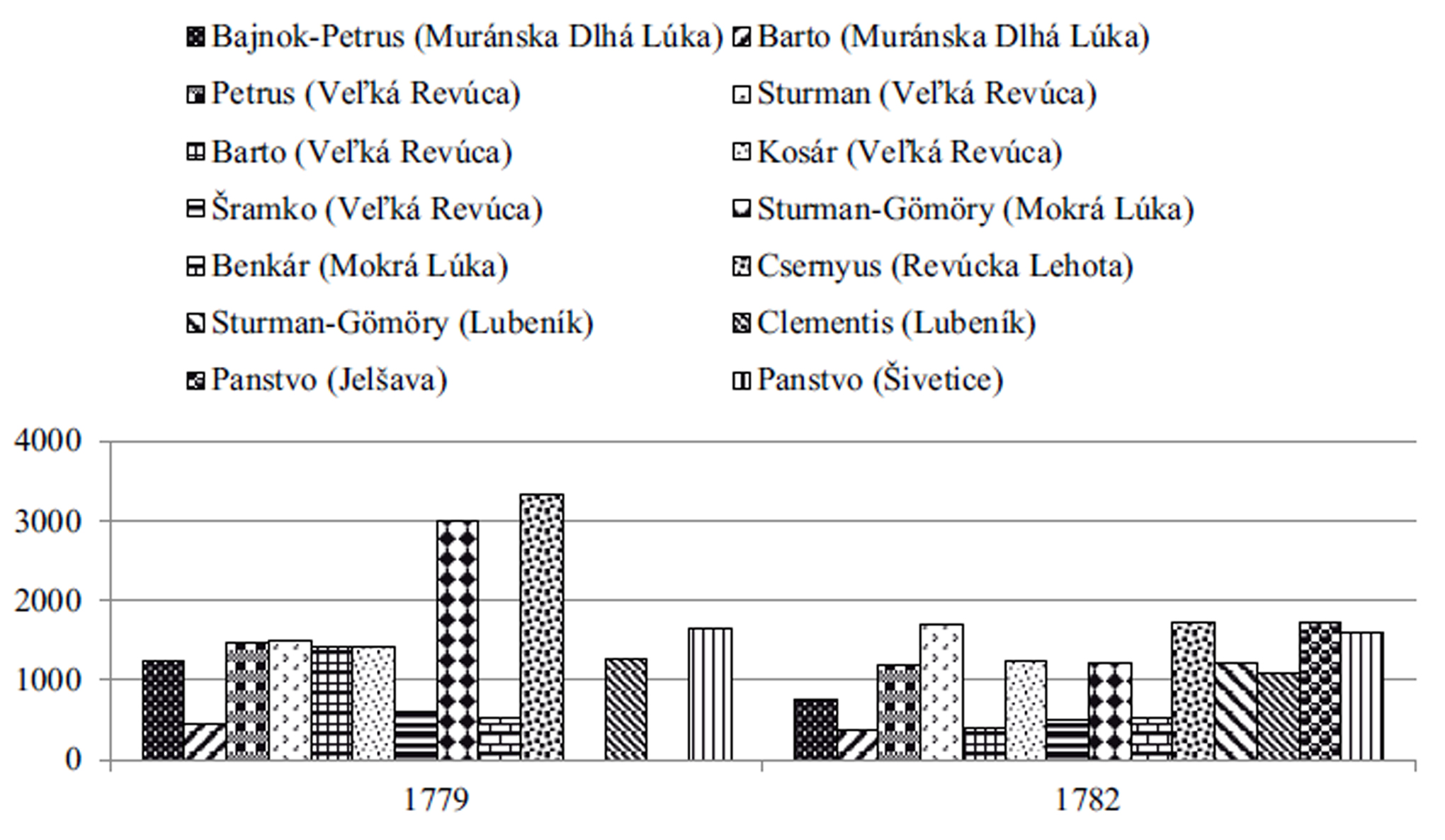
The data above reveal a quantitative growth of the iron industry in the region and point out a group of ambitious entrepreneurs who specialized in renting or building furnaces in the Kohárys’ demesne. With their purchases, they increased their wealth and asserted their economic interests with increasing self-confidence (e.g., Ondrej Šramko, the mayor of Veľká Revúca). Among the entrepreneur families, we encounter the Sturmanns (whose surname was also stylized as Sturman), who were a prototype of these small, but gradually growing first bourgeois entrepreneurs (i.e., capitalists). Among the iron-producing families of Gemer, it was definitely they who achieved the most rapid social advancement and increase in their assets.
From the early 20th century, in the interwar period (1918 to 1939) still, rumors were being spread about the Swedish roots of the Sturmanns, probably to increase the social prestige of their offspring (Veres 1922: 84; Barát 1935: 30). This Gemerian fami ly allegedly came from a marshal of the Swedish King Gustaf Adolf, an anonymous one, who had fought bravely in the Thirty Years’ War (1618 to 1648) and received great honors and estates for his merits. For reasons unknown, a branch of this unknown warrior settled first in Transylvania and, from there, made its way to Gemer (Tahy 1904: 202).
The truth was a lot simpler, however, and it was in line with the actual life of Gemer. The ancestors of this, most probably German, family of Sturmann came from Revúca. Their names are documented in registers of serfs from the year 1558. István, who lived in Mokrá Lúka (Vizesrét), was redeemed from serfdom for 280 guilders and acquired armales, along with his sons András and György, with the title of nobility Ózd et Zádorháza, on March 28, 1699. He was apparently one of the wealthiest serfs of the Kohárys’ demesne, since he owned land and ran a smelter, for which he paid rent to the royal treasury (Sarlay 1933: 35–36).[15]
The family had had considerable assets already by the late 17th century, since it had received into custody the praedia of Sirk, Turčok, and Železník, all places with significant mines of iron ore, from the Csákys. The Sturmanns acquired these definitively in 1758 (Vályi 1799: 414, 538; Heckenast 1986: 1045). Their furnaces accounted for a significant part of the iron production in the Muráň Valley. In 1779, they accounted for 25.2%, and in 1782, already 27.1% of the total iron production, overtaking not only their competitors (e.g., the Csernyuses), but even the companies of the Kohárys.[16] From this family, which was related to the Czékus family of entrepreneurs, the person who achieved the highest social recognition was Martin (Martinus, Márton) Sturmann, a quite-forgotten figure of the regional history of Gemer. He was the initiator and co-organizer of the first ironworks, a sympathizer with liberal ideas, promoter of arts, and supporter of the Lutheran Church and the needy.[17] Martin Sturmann followed in the footsteps of his father, also called Martin, who had probably laid the foundations for their family enterprise in the iron industry (Heckenast 1986: 1045).
The First Entrepreneurial Companies of the Iron Industry
In the early 19th century, Gemer had a remarkable economic capacity. As much as a half of the iron industry of Hungary was concentrated in that region. Nine smelters and 81 bloomeries, with an annual output of about 200,000 Viennese cents (11.2 million kilograms) operated there. The production facilities ran from spring to autumn. In winter, they shut down for 15 to 20 weeks. The operations were based on feudal estates, where most of the plants were situated. The feudal lords rented out the furnaces and the smelters for urbura (Eisenfron, mining revenues). This type of enterprise changed quickly, however, as closer economic collaboration, the establishment of joint stock companies, the profitability of production facilities, and naturally, achieving the highest possible profit came to the forefront (Réti 1977: 12).
The first capitalist company in Gemer was the Societas Massae Chalybeae steelworks, which operated from 1792 to 1798 in the Upper Hron region. Its shareholders had a blast furnace with hammer mills built in the village of Šumiac, but they soon began to face financial problems. They could not achieve their long-term plans of steel production and produced only raw iron. In 1798, the company declared bankruptcy and the production facilities were taken over by the Kohárys (Horváth 1811: 319; Heckenast 1986: 1046).18
A few years later, entrepreneurs in the valleys of the rivers Muráň and Rimavica were also mobilized. The Murány Union, with its seat in Bartová, was established on May 3, 1808.19 The founding members put into the company as many as 26 mines in Železník, the mining field in Rákoš, and 14 ironworks in the valley of the Muráň river. Its shareholders included members of aristocratic entrepreneur families (Martin and Ondrej Sturmann, Petróczy, Ondrej Šramko, Bartho, Bartóffy, Benkár, Engel, Clementis, Czékus), the influential German tradesman and iron entrepreneur and owner of the smelter in Rimavské Brezovo[18] Georg Ludwig Malvieux,[19] and even the small town of Veľká Revúca.[20] The business matters were handled by the president of the company was founded by the shareholders Miklós Király Szathmáry, Éva Czékus, Martin Sturman, János Kaiser, György Samarjay, János Lányi, and Izrael Gömöry, with the support of the feudal lord Count Ferenc Koháry.
the company, Martin Sturmann. Ondrej Šramko, considered to have been the first “union director,”23 apparently also held an important post in the management. Their official books and documents were kept in Slovak and German. Hungarian was additionally introduced into official communication only in 1834.24 The Murány Union established a business in Pest, where its products were sold from the year 1818 onwards by the wholesaler Antal Deron.25
Initially, the industrial complex of the union was able to produce as many as 5,000–6,000 Viennese cents of raw iron, 3,000–4,000 ingots, and 7,000–9,000 Viennese cents of pig iron (Réti 1977: 13).26 To increase its production, in 1827 and 1828 the union purchased several forests and water wheels in the valley of the Rimavica river, six hammer mills in the vicinity of Rimavská Kokava, eight refining forges (Frischfeuer) in the valley of the Klinovská Rimavica, and two hammer mills near Klenovec (Lower and Upper Hlinanec) (Koroknai – Schlegel 1978: 12).
The iron production of the union progressed rapidly. In the 1830s, it exported raw iron even to Vítkovice and began to monopolize the interior trade of Hungary. In 1843, it began to build a factory for puddling and rolling in Ózd in collaboration with the other iron companies of Gemer. Thanks to the relative expansion of the market, and to the conditions that arose in 1848–1849, the Murány Union climbed to the top among private ironworks in Hungary, and even in the field of cast iron production. However, due to the post-revolutionary, negative development of the economy and the narrower market opportunities, a recession hit this company, too. In 1850, for example, as many as 50,000 cents of raw iron remained in its warehouse unsold, leading to a significant decrease in income and the shutdown of some of its hammer mills.27 In 1851, it produced 35,854.5 Viennese cents of raw iron (Koroknai–Schlegel 1978: 12).
The other significant iron company, the Rima Coalition (or Rima Ironworks – Rimai Vasművelő Társaság – as it was usually referred to) was established on May 13, 1810, with its seat in Rimavské Brezovo in the Malohont region. Its share capital consisted of 128 shares at a nominal value of 2,000 guilders. Its major shareholders included the noblemen Count József Luzsénszky, Count Alajos Forgács, members of the Kubinyi family, Martin Sturmann, and the Murány Union (Koroknai 1977: 465). The lawyer of the company was Miklós Ratkó.[21] Technical matters, the development of iron infrastructure, the increase in the output of its hammer mills and furnaces, and mining and business matters were entrusted to the talented Frigyes Heincz, who held the post of inspector and was a prefect from 1826 (Koroknai 1978: 164). In its Article 12 regarding administrative rules, the “Corporate Agenda” of 1812 respected all the commonly spoken languages in the region (i.e., Latin, Slovak, and Hungarian): “Every clerk shall make notes daily about the economy he is handling and shall submit these in time either in Hungarian, or in Latin, or in Slovak, for audit to the respective bureau” (Koroknai 1977: 465).
The industrial and raw material base of the coalition consisted of factories in Rimavské Brezovo, Likier, and Hnúšť, and iron ore mines in Železník, Rákoš, and the Rimavica Valley (Réti 1977: 14). Right in the year of its establishment, its assets increased significantly by its acquisition of land from Baroness Erzsébet Luzsénszky.[22] Over time, the coalition acquired large forest properties in the cadastral areas of the villages Vyšná Pokoradz, Čerenčany, Selce, Rimavská Kokava, Rimavská Baňa, Likier, and Tisovec. As Réti estimated, at its establishment, the Rima Coalition was able to produce raw iron amounting to 7,000–8,000 Viennese cents and a significant amount of malleable iron of 4,000–5,000 Viennese cents. In the first two decades of the 19th century, the company exploded in the Hungarian market and significantly increased its production capacity. It established two new hammer mills and blast furnaces (in Ráztočno, Likier, and Rimovce). It was not a chance that the first iron cartel agreement on the prices of iron products in Hungary, which was basically a market regulation, was reached between this coalition and the Koburgs’ ironworks. However, the early 1830s brought not only a cholera epidemic and a social crisis, but also financial distress. The coalition acquired a loan with a significantly higher interest rate (research has not focused on concrete providers of such capital yet), and it could reimburse it only with a significant delay and only thanks to the new, more favorable situation and an increase in production. In 1839, for example, it increased the amount of malleable iron to 13,200 Viennese cents (Réti 1977: 15).
Réti formulated a thesis that the Rima Coalition began to gradually lag behind the Murány Union. As he noted, the Rima Coalition had produced the same amount of raw iron as the Murány Union in 1841 (10% each), but a few years later it fell behind its regional competitor and was unable to increase production, while the union doubled its own production and overtook even the Koburgs’ ironworks. Réti’s estimate is based on the earlier research of Gyula Mérei, but he did not quantify the extent of the decline of the production of the company in Rimavské Brezovo. According to the Austrian mining statistics of 1839, it is noteworthy that iron producing companies in Gemer were able to produce more raw iron together (the Murány Union 20,155 Viennese cents and the Rima Coalition 28,260 Viennese cents) than the Koburgs’ company (36,800 Viennese cents). In the field of cast iron production, however, both the union and the coalition lagged significantly behind the companies of not only the Koburgs, but also of the Andrássys (Réti 1977: 17).[23]
The shareholders of the coalition were aware of the decline and of their technolo gical backwardness and problems with domestic consumption; therefore they contacted Tivadar Rombauer,[24] a native of Levoča, who was already a recognized expert at that time, and offered him the post of company director (Lehoczky 1965: 82). Probably at the initiative of Rombauer and the other managers of the coalition and the union, the most significant meeting of the iron producing companies in Gemer took place under the leadership of Count György Andrássy.[25] They met on January 23, 1843, in the picturesque mansion of the Andrássys in Krásnohorská Dlhá Lúka.[26]
This was essentially the first time that the situation and the alternatives in the development of the Hungarian iron industry were discussed systematically. The partici pants identified the basic problems (i.e., the limitations of an underdeveloped iron market, the poor transport infrastructure, the obstacles in the form of export duties, and the overall backwardness of the country). They initiated the abolition of the customs border between Austria and Hungary, and they called for the protection of the export of iron products from the Habsburg Monarchy. They pointed out the necessity of a rational construction of a railway network between Hungary and foreign lands, as well as between the developing Pest and the most important regions of the iron industry. The participants considered it important to financially support industrial entrepreneurship by establishing a bank of superregional significance in Košice. They initiated the development of secondary mining schools and universities and the exchange of experience between stakeholders in the iron industry (Réti 1977: 18). These progressive proposals and recommendations reflected the liberal ideas of Count György Andrássy and the knowledge he gained during his travels in England, France, and the German lands from 1832 to 1834. As a close collaborator of Count István Széchenyi, he advocated for the modernization of Hungary (Brigovácz 2008: 167–188). On the other hand, the presented proposals also reveal the Andrássys’ strong lobbying motives and their long efforts to uplift and further develop the iron industry and the road network in Gemer and, thereby, also their family mines, smelters, and factories.[27]
The meeting in Krásnohorská Dlná Lúka became a crucial one for the establishment of Rimamurány–Salgótarján Ironworks. That is where the idea to establish an iron factory in Ózd in Borsod County, which would focus its production on a voluminous amount of railway tracks for the construction of a countrywide railway network in Hungary, was formulated.
On October 14, 1844, in Rimavská Sobota, the Murány Union, the Rima Coalition, and the aristocrat entrepreneurs of the iron industry, including the most active Andrássys, approved a plan to establish an iron factory in Ózd and create a new organizational structure of the Gemer Ironworks Association (Gömöri Vasművelő Egyesület).[28] Allegedly, the first person to have publicly pronounced this was a delegate of the Murány Union, János Czibur (Óvári 1967a: 440). The company started its activities officially on May 17, 1845 (Szigetvári 1962: 152).36
The place of the new plant, however, became the subject of an extensive debate.[29]Already back in 1843, Count György Andrássy preferred the cadastral area of the village of Sajópüspöki, while others were for several localities in the valley of the Slaná (Sajó) river. At their meeting in Rimavská Sobota, a proposal for a further unspecified place at the northern foothills of the Mátra mountain range also came up. The Rima Coalition suggested the valley near the village of Sajóvárkony in the vicinity of Ózd. Ultimately, the stakeholders agreed on Ózd, where they purchased a property of an area of 20 cadastral jutros. The construction of the factory began on April 20, 1845. The machinery was provided by the Lutz & Dobs machine factory from Brno. Twenty to 25 specialists and 80–100 day laborers worked on erecting the structures. The management of the Gemer Ironworks Association consisted of five members. Its president was Pál Király Szathmáry, the director of the Rima Coalition.[30] Technical work was supervised by the above-mentioned Tivadar Rombauer. The Murány Union was represented by the engineer of Gemer County, János Czibur, and a mining expert, the metallurgical engineer József Benkár (Réti 1977: 18–19).[31] The technical director was an Austrian engineer, Kajetán Fohn, who supervised the construction and was responsible for the acquisition of machinery for the production of raw and malleable iron and components.[32]
The company had a share capital of 250,000 guilders and issued 25 shares for its acquisition (i.e., each share was worth 10,000 guilders). Of the shares, 40% was owned by the Murány Union and the Rima Coalition (owning five shares each). Count Károly Andrássy and the banker Móric Ullmann Szitányi owned two shares each; Pál Király Szatmáry, the squires Sámuel Draskóczy[33] and Ferenc Ragályi, the towns of Rimavská Sobota and Veľká Revúca, the engineers of the company (Rombauer, Fohn, and Gotthard), and small local entrepreneurs owned one share each. The group of the small local entrepreneurs included not only prominent officials and experts in the iron companies of Gemer (the drafter of the foundry in Hnúšť, Frigyes Heincz[34] of the Rima Coalition and János Czibur of the Murány Union), but also an iron trader (Pál Jurenák from Pest) (Réti 1977: 19; Jenei 1980: 52; Szigetvári 1962: 152).[35]
The ironworks (rolling mill) in Ózd was designed to produce railway tracks, sheet metal, and steel of various type in a quantity of about 100,000 Viennese cents. It was equipped for this purpose with 10 puddling furnaces and steam engines with 90 horsepower, which powered a lathe, sheet metal cutters, and pumps. To ensure production, contracts to supply raw iron were reached with the Murány Union, the Rima Coalition, and the companies of the Andrássys. The company acquired the right to mine lignite in the vicinity of Ózd, with which it was experimenting successfully. A safe and fast transportation of the products required transport networks to be built, so a bridge was erected near the village of Sajópüspöki, and the road between Ózd and Bánréve was renovated (Szigetvári 1962: 152; Réti 1977: 19). The technological significance of the ironworks in Ózd for Hungarian railways was immense as, until then, the country had had to rely on Austrian and Czech lands (Präval in Carinthia and Vítkovice) for providing rolled iron products (Óvári 1967a: 437). However, the envisaged lucrative deal with the Central Hungarian Railways (Magyar Központi Vasúttársaság, Ungarische CentralEisenbahn) was not struck, and in 1847, the Gemer Ironworks Association had to resort to increasing its capital to 350,000 guilders to maintain its liquidity (Óvári 1967b: 489).[36]
Nevertheless, the management and the shareholders were optimistic about the future. Work was progressing well, although the industrial complex was still unfinished. What they could not have foreseen, however, were the events of 1848 and 1849, specifically the state of war, the disruption of the economy, and the subsequent crisis with a major impact on the development of the iron industry in Gemer.
In the Service of the War Economy
With respect to private mining and iron industry, noteworthy, and even progressive, changes took place in the spring of 1848. In May, the Hungarian government, led by Lajos Kossuth, began to form a new organizational structure for mining, metallurgy, and iron production in Hungary and tried to reduce its dependence on Vienna. At their negotiations in Pest, the members of the parliament and the delegates of mines and iron companies repeatedly discussed a new form of Hungarian economy, the harmonization of the interests of the state and of the individuals, as well as the need for a new mining law and the improvement of the social status of miners (partly to eliminate social and ethnic unrest). The representatives of the Rima Coalition (Vilmos Kubinyi, Tivadar Rombauer, and Miklós Ratkó) and the Murány Union (József Benkár) also participated in these negotiations. All of them actively worked in committees that dealt with specific problems of individual production areas (Sashegyi 1969: 323–352).
The idea to unite forces and create more efficient forms of entrepreneurship in the iron industry was also revived. It came up on May 10, 1848, when the representatives of the Murány Union initiated their fusion with the Rima Coalition, but the shareholders of the coalition rejected it (Réti 1977: 20–21). The position and the business strategies of the Murány Union and the Rima Coalition changed drastically in the autumn of 1848, when the definitive rift between imperial Vienna and revolutionary Pest escalated into armed conflict. Iron-producing companies and enterprises specializing in the production of iron components became crucial elements of the emerging Hungarian arms industry, which were to ensure the self-sufficiency of the Hungarian revolutionary army and provide an arsenal especially for artillery and infantry. On the other hand, the interventions of Kossuth’s government and the forceful enforcement of state interests met with passivity, and sometimes even unwillingness, from private iron-producing companies, which regarded these regulations and intentions as harmful. The reason was that the rapid reprofiling of iron companies required not only the modification of their machinery and new investments, but to a certain extent, even retraining their workforce and employing new specialists. Some companies saw in the purchase orders and loans of the revolutionary government an escape from their crisis and an opportunity to increase their liquidity and, in a very short time, they became subsuppliers of the National Arms Factory (Országos Fegyvergyár) in Pest. Some entrepreneurs were more cautious and waited. However, especially after September 1848, Minister of Defence Lázár Mészáros stepped in drastically and forced them to actively participate in the armament policy of the Hungarian government. Lázár went as far as threatening unwilling entrepreneurs with “nationalizing” (i.e. confiscating) their property.
In the case of the Rima Coalition, it was Lajos Kossuth himself who intervened. We do not know the details of the attitude of the management and the shareholders, but in a letter dated November 20, 1848, Kossuth urged them impatiently to produce cannonballs and grenades of the required quantity. Three days later, a contract was signed by a delegate of the coalition, Vilmos Kubínyi, and Minister of Defence Lázár Mészáros. According to this contract, the coalition was liable to supply 10,000 grenades, weighing seven Viennese Pfunds, for the Hungarian revolutionary army and deliver them to Pest by March 19, 1849. Production took place in Hnúšťa. After inspection, the ministry paid 12 guilders for 100 Viennese Pfunds of good ammunition and three guilders for nonfunctional ones. The coalition had to transport these unusable cannonballs at its own cost to the premises of the National Arms Factory (Szigetvári 1962: 154).
The Rima Coalition produced 20,568 grenades in total, of which it delivered only 17,314. Due to the retreat of the Hungarian revolutionary forces, the rest were stored in a mine near the village of Sirk, from where they were later transported to Málinec to be smelted. However, the imperial forces confiscated them, along with their molds (Szigetvári 1962: 157).
On the surface, the Gemer Ironworks Association took a proactive part in arms production. It contacted Gerhard Heinrich Knutzen,[37] an engineer of Dutch origin in Pest, in the matter of rifle production for the infantry. A contract was signed on July 12, 1848. Knutzen was to study rifle production in England, Belgium, and France, and acquire machinery for the production on behalf of the company. However, due to the state of war and the closure of the borders of the Habsburg Monarchy, this project did not unfold as anticipated (Szigetvári 1962: 158).
In the autumn of 1848, the Hungarian government returned – that is to say, in an escalated situation, it had no other choice but to return – to its original idea of producing rifles in Hungary. On November 21, 1848, it entered into a contract with Knutzen and provided a loan of 60,000 guilders, at 4% interest, to the Gemer Ironworks Association and undertook to provide components so that the rolling mill in Ózd could commence production. However, the company did not proceed well with rifle production, whether due to the worsening political and economic conditions or due to the threat of invasion by Austrian troops. An unexpected change occurred in early January 1849, when the Hungarian government fled Pest away from the advancing Austrian troops. Tivadar Rombauer, who was liable for the evacuation of the National Arms Factory, moved the lathes, the drills, and the other machines for rifle production to Ózd, where production started immediately under the supervision of the state. Due to alleged sabotage (non-repaired machines, no coal, disorganization of the production), however, rifle production progressed slowly. By June 1849, only three 350 Viennese Pfunds of sheet metal had been processed for rifles. The machinery of the National Arms Factory was ultimately transported back to Pest (Szigetvári 1962: 158–165; Óvári 1967b: 485).
On June 21, 1849, without scruples, the Gemer Ironworks Association quantified its financial demands against the state. It demanded 36,932 guilders for the use of machines, for unfulfilled contractual obligations, for laborers’ wages, and for the produced iron products, and it appears to have received this amount (Szigetvári 1962: 166).
In the summer of 1849, iron production in Gemer stopped completely. The ironworks in Ózd was occupied by Slovak voluntary corps led by Major Henrik Lewartovski. The premises were meticulously burgled and some of the machines, technical equipment, and 520 Viennese Pfunds of rolled iron were taken away (Óvári 1967b: 485).
The Quest for New Paths
After the revolution, iron-producing companies faced a number of problems, especially financial and economic ones. The completion of major technological investments in iron and steel production, which had begun before 1848, became a priority. Domestic capital was inadequate. Moreover, major Hungarian commercial banks, mainly the ones in Pest, had not yet specialized in targeted lending to industries. In an economically subverted country, foreign capital was being cautious and some firms, for example the Gemer Ironworks Association, struggled with financial difficulties. The departure of qualified foreign experts, which began already in March 1848, and the shortage of the part of the workforce that had joined the Hungarian revolutionary army and had been persecuted after the Surrender at Világos, worsened the situation further (Vass 1977: 9).
The management and the shareholders of the Murány Union, the Rima Coalition, and the Gemer Ironworks Association were aware of the problems that hindered progress. Austrian iron companies were increasingly dominating the Hungarian market, and Hungarian iron companies, not only not proceeding jointly, but sometimes even going against each other, could not seriously compete. On the other hand, they could capitalize on the experience that they had gained with the establishment of the ironworks and rolling mill in Ózd. To join forces was therefore not only logical, but even indispensable.
Their fusion was urged especially by the Gemer Ironworks Association, which was in financial distress due to the worthless Kossuthian currency and an inadequate amount of goods in stock and was in danger of bankruptcy. The reason for the accumulation of the banknotes of the revolutionary Hungarian government was that Gemer, whose territory had not yet been entered by Austrian and Russian troops in the summer of 1849 became an “island” for this money. A “regional bubble” was essentially created, which led to a decline of all the economic sectors. An influx of worthless “Kossuthian banknotes” began from the neighboring counties, and the population tried to get rid of them as fast as possible (Steier 1937: 588; Óvári 1967b: 485–486).
In this difficult situation, when production facilities had not been operating for almost two years, what would have been lifesaving for the management of the Gemer Ironworks Association would have been a large loan (they needed capital in the amount of 60,000 guilders) or foreign investment. Two of its delegates, the squire Gyula Draskóczy and János Czibur, were therefore commissioned to gain financial aid. After their negotiations in Pest and Vienna failed, they tried their luck in Carinthia and Styria, also in vain. Ultimately, they managed to attract a Viennese iron-producing company, Lachner & Heinrich, which provided a loan of 21,000 guilders and even guaranteed the sale of their products. Thanks to this modest loan, shareholders’ donations, and the involvement of an expert, the Austrian engineer Valentin Gotthard, production resumed in Ózd in early 1851. Laborers were recruited from the close vicinity, such as from Betliar. However, despite the initial, although only partial, success, the collaboration with the Viennese company became problematic and the crisis of the company deepened further (Óvári 1967b: 485–486).
In 1852, on the initiative of the Rima Coalition, negotiations began over the establishment of a new company. The Rimamurány Ironworks Association (Rimamu rányvölgyi Vasmű Egyesület) was established on July 6, 1852, with the fusion of three enterprises – the union, the coalition, and the mining company – by joining their production capacities and funds. The focus of iron production in the wider region definitively shifted to Ózd. A share capital of 55% was raised by aristocrats, 25% by small entrepreneurs (i.e., forgers), 15% by the towns of Rimavská Sobota and Veľká Revúca, and 5% by traders.[38] Gusztáv Fáy[39] became the president of the Rimamurány Ironworks Association, and the experienced József Benkár was appointed as its chief inspector, which was essentially its director, and he held this post until his retirement in 1856. He was succeeded by the above-mentioned, agile József Volny, whose leadership was considered by the contemporaneous press as years of boom for the ironworks in Ózd.
Under the directorship of Benkár, new investments were implemented, such as the construction of steam hammers and steam boilers and residential buildings for the laborers. However, the proposed comprehensive modernization, thanks to which the output of the ironworks in Ózd would have achieved iron production in the amount of 30,000 Viennese Pfunds, did not take place due to the cautiousness of the shareholders. Progress was more systematic under Volny, who was more successful at convincing the shareholders to fund new projects (a rolling mill, soldering furnaces, cutters). In 1858, he managed to achieve an old goal: their new workshop began to produce railway tracks. Another achievement of his was the establishment of the ironworks in Borsodnádasd in 1864. However, the Rimamurány Ironworks Association also inherited a heavy burden from the Gemer Ironworks Association, the scandal of the so-called Hungarian money. From 1850, the Viennese government demanded that it pay back the 60,000-guilder grant provided to the people of Gemer by the Hungarian revolutionary government. A lawsuit followed, which dragged on until as late as 1863. In that year, the company had to surrender and pay a smaller amount, 36,000, which it nevertheless missed badly in its subsequent years.
The 1850s brought other negative developments in the iron industry, too. The iron producing companies of the monarchy could not compete with English producers of railway tracks, so they were forced to change their manufacturing profile and redirect it to steel bar production. This change led to overproduction and, consequently, to a long crisis in the Hungarian iron industry (Óvári 1967b: 486).
Conclusion – The Vision of the Centralization of the Iron Industry of Hungary
“In the future, our iron industry can develop only in the current direction and only on the present-day basis, but for it to be able to meet the justified demand of the consumers for cheap iron, it must adjust; on the other hand, in the case of the liberalization of the internal market, it is necessary for it to resist the discounted products of foreign competition; the scattered small companies must unite into larger units.” (Volny 2003: 41) This is how József Volny formulated his vision based on his long experience and contemporaneous trends. His words also confirm the progressive 19th-century idea that the socioeconomic modernization of Hungary, the upliftment of backward areas, and the civilizational progress of the population can be ensured not only by the state, but also by entrepreneurial groups that had large raw material reserves and capital and could attract experts with adequate technological and managerial experience. Of course, the state had to respect the principles of, sometimes overly idealized, laissez-faire and bear in mind the tried and tested principles of supply and demand to create suitable laws and an overall “healthy atmosphere” for entrepreneurship in the country.
In Volny’s concept, the economic elite was assigned a prominent position at the regional level. With their close collaboration, the aristocracy, the wealthy middle nobility, and the corporations could establish entrepreneurship in iron production, mining, and metallurgy, and make it more efficient. Their activities could be of a major significance for the national economy and earn recognition and facilitate the social development of the region. He also investigated the most important political, financial, and transport possibilities of the development of mining and metallurgy, not only in the region of Gemer, but also in comparison with the other regions of Upper Hungary. Although unconsciously, but in the depths of his deductions, he did identify four longintertwined phenomena: the attitude of the Austrian/Hungarian state to iron-producing companies (industrial policy and its metamorphoses), the application of the latest technological know-how from abroad, the activities of entrepreneurs, especially from among the aristocracy, and the centralizing process of the iron-producing companies.
According to some other experts, the self-sufficiency of Hungarian iron companies could have been realistically achieved, to a certain degree, by increasing their capacities, but they still would have had to have relied on the import of steel and iron products from Austria (Kerpely 1884: 29). Technological innovations began to be applied, including the transition from water sources to steam engines, a more intense use of coke, and the planning of more modern smelters. Finally, an influx of foreign, especially Austrian, capital and the arrival of experts from Czechia, Austria, and Germany could also be observed. Nevertheless, the foundations for the new development of the iron industry in Hungary and Slovakia were laid by the experience of the iron entrepreneurs of the first half of the 19th century.
Literature
Barát, Endre 1935. A magyar nőnevelés apostola. In Ujság, 8 December 1935, Vol. 11, No. 280, 30.
Berend, T. Iván – Szuhay, Miklós 1975. A tőkés gazdaság története Magyarországon 1848– 1944. Budapest, Kossuth Könyvkiadó; Közgazdasági és Jogi Könyvkiadó.
Boros, Gábor. A diósgyőri kohászat Csavar- és Húzottáru Gyárának története 1770–2007.
Miskolc, Pfliegler J. Ferenc Emlékére a Borsod-Abaúj-Zemplén Megyei Levéltárért Alapítvány, 2007.
Borovszky, Sámuel (ed.) 1903. Gömör-Kishont vármegye. Budapest, Apollo Irodalmi Társaság.
Brigovácz, László 2008. Egy tanulmány értékű napló – Andrássy György angliai utazása. In Történeti Tanulmányok, Vol. XVI, Acta Universitatis Debreceniensis, Series Historica LX, Debrecen, Debreceni Egyetem, 167–188.
Eisele, Gusztáv 1907. Gömör és Kishont törvényesen egyesült vármegyének bányászati monografiája. Vol. 1. Selmeczbánya, Kiadja az Országos Magyar Bányászati és Kohászati Egyesület Borsod-Gömöri Osztálya.
Erdélyi, János 1846. Nemzeti iparunk. Pest, Heckenast Gusztávnál.
Fényes, Elek 1847. Magyarország leírása. Vol. 1. Pest, Nyomatott Beimelnél.
Fricz-Molnár, Péter 2019. Király Irén családtörténeti visszaemlékezése. Turul, 2019, Volume 92, Issue 4, 175–187.
Frisnyák, Sándor 1996. Az Árpád-kori Magyarország gazdaságföldrajza. Földrajzi Közlemények, 1996, Volume 70, Issue 2–3, 119–136.
Gaučík, Štefan 2020. Podnik v osídlach štátu. Podnikateľské elity na príklade Rimamuránskošalgótarjánskej železiarskej spoločnosti. Bratislava, Historický ústav SAV; Veda.
- Balázs, Éva – Makkai, László (eds.) 1962. Magyarország története 1526–1790. Budapest, Tankönyvkiadó.
Heckenast, Gusztáv 1958. A murányvölgyi vashámoros céh szabályzatai (1585 – 1713 – 1755). Történelmi Szemle, 1958, Volume 1, Issue 3–4, 430–447.
Heckenast, Gusztáv 1961. A feudáliskori magyarországi vaskohászat historiográfiája. Történelmi Szemle, Volume 4, Issue 1, 1961, 123–129.
Heckenast, Gusztáv 1973. Železiarsky priemysel Rožňavy na začiatku 18. storočia. Obzor Gemera, 1973, Volume 4, 139–141.
Heckenast, Gusztáv 1980. A vashámor elterjedése Magyarországon (14–15. század). Történelmi Szemle, 1980, Volume 23, Issue 1, 1–29.
Heckenast, Gusztáv 1985. A vaskohászat technikai szintje Magyarországon a 16–18. században. Századok, 1985, Volume 119, Issue 4, 917–940.
Heckenast, Gusztáv 1986. Magyarország vastermelése II. József korában. Századok, 1986, Volume 120, Issue 5–6, 1040–1094.
Horváth, Mihály 1811. Az ipar és kereskedés Magyarországban a három utólsó század alatt. Buda, A Magyar Kir. Egyetem betűivel.
Izsó, István 2006. Szemelvények a középkori montanisztika magyarországi történetének írott forrásaiból (1000–1526). Rudabánya, Érc- és Ásványbányászati Múzeum Alapítvány.
Jenei, Károly 1980. Az alapítás és üzembe helyezés. In: Berend, T. Iván (ed.). Az Ózdi Kohászati Üzemek története. Ózd, Ózdi Kohászati Üzemek.
Kaposi, Zoltán 2002. Magyarország gazdaságtörténete 1700–2000. Budapest; Pécs, Dialóg Campus Kiadó.
Kerpely, Antal 1884. A magyar vasipar jövője (a legközelebbi tíz évben). Budapest, A M. T. Akadémia könyvkiadó-hivatala.
Koroknai, Ákos 1977. Egy feudáliskori részvénytársaság (Rimai Coalitio) szervezete és működése. Levéltári Szemle, 1977, Volume 27, Issue 3, p. 457–487.
Koroknai, Ákos 1978. Heincz Frigyes, a Rimai Coalitió kiemelkedő műszaki vezetője. Műszaki értelmiségi életút a XIX. század elején. Bányászati és Kohászati lapok. Kohászat, 1978, Volume 111, Issue 4, 163–171.
Koroknai, Ákos – Schlegel, Oszkár 1978. A Rimamurány-Salgótarjáni Vasmű Részvénytársaság története 1808–1918. A vállalat gazdasági levéltára alapján. Budapest, VÍZDOK.
Lacko, Miroslav 2015. Štátne financie habsburskej monarchie a uhorská meď v období vojny o rakúske dedičstvo. Na ceste k novým kontraktom. Historický časopis, 2015, Volume 63, Issue 2, 209–230.
Lehoczky, Alfréd 1965. Rombauer Tivadar és a borsodi ipar. Borsodi Szemle, 1965, Volume 9, Issue 2, 82–84.
Mérei, Gyula 1951. Magyar iparfejlődés 1790–1848. Budapest, Közoktatásügyi Kiadóvállalat.
Mikulik, József 1880. A bánya- és vasipar története Dobsinán. Budapest, Az Athenaeum R. társulat könyvnyomdája.
Mikulik, József 1885. Magyar kisvárosi élet 1526–1715. Rozsnyó, Kovács Mihály könyvnyomdája.
Mózes, Mihály 1988. Az erdélyi-bánáti nagyipari fejlődés főbb bekapcsolódási szektorai (1867– 80). Magyar Történeti Tanulmányok, 1988, Vol. 21, Debrecen, KLTE, 27–40.
Ondrušová, Eva 2013. Kameralistika v teórii a praxi: prípad Habsburskej monarchie. Kováč, Dušan et al. Sondy do slovenských dejín v dlhom 19. storočí. Bratislava, Historický ústav SAV, 158–172.
Óvári, Antal 1967a. Az ózdi vasmű alapításának első üzeméveinek vázlatos története I. Kohászati Lapok, 1967, Volume 100, Issue 10, 437–442.
Óvári, Antal 1967b. Az ózdi vasmű alapításának első üzeméveinek vázlatos története II. Kohászati Lapok, 1967, Volume 100, Issue 11, 485–491.
Paulínyi, Ákos 1963. A szlovákiai bucakemencék (ún. tótkemencék) és a bucaművelet a XVIII. században. Adatok a közvetlen eljárás történetéhez Magyarországon. Magyar Tudományos Akadémia Műszaki Osztályának Közleményei, 1963, Volume 32, 423 – 447.
Réti, R. László 1977. A Rimamurány-Salgótarjáni Vasmű Részvénytársaság története 1881– 1919. Budapest, Akadémiai Kiadó.
Sarlay, Soma 1933. A Sturman-család eredete. Turul, 1933, Vol. 47, Nos. 1–2, 35–36.
Sarusi Kiss, Béla 1997. Vasgyártás és vasgazdálkodás Murányban a XVI. században. Fons, 1997, Volume 4, Issue 1, 79–98.
Sashegyi, Oszkár 1969. Bányapolgárok a forradalomban. Az 1848. évi országos bányászati értekezlet jegyzőkönyve. Levéltári Közlemények, 1969, Volume 40, Issue 2, 325– 352.
Steier, Lajos 1937. A tót nemzetiségi kérdés 1848–49-ben. Budapest, Kiadja a Magyar Történelmi Társulat.
Szigetvári, István 1962. Iratok a Rimamurány-Salgótarján Vasmű Rt. levéltárából az 1848– 1849. évi szabadságharc hadianyaggyártásának történetéhez. Levéltári Közlem é nyek, 1962, Volume 33, Issue 1, 285–310.
Szilágyi, Gábor 1960. Iratok a Rimamurány-Salgótarjáni Vasmű üzemi bizottságainak történetéhez 1945–1946-ban. Levéltári Közlemények, 1960, Volume 31, Issue 1, 285–310.
Tahy, István 1904. Tahyak és azokkal rokon családok. Budapest, Pátria Irodalmi Vállalat és Nyomdai Részvény-társaság nyomása.
Vályi, András 1799. Magyarország leírása. Vol. 3. Buda, A királyi universitásnak betűivel.
Vass, Tibor 1977. Jelbeszéd az Ózdi Finomhengerműben. Miskolc, Hermann Ottó Múzeum.
Volny, József 2003. Gömör megye bányaipara (1867). Rudabánya, Érc- és Ásványbányászati Múzeum.
Veres, Szilárda 1922. Emlékeim 1847–1917. Budapest, Légrády testvérek kiadása.
Ungár, László 1936. Magyarország pénzügyei 1848–1849-ben. Századok, 1936, Volume 70, Issue 1–3, 598–660.
To make stew, you need a hare, and to establish a monarchy, you need a king. Former Crown Prince Wilhelm II’s relationship with the National Socialist movement during the 1932 German presidential election
Introduction[1]
Prince Georg Friedrich of Prussia announced in a press release in the spring of 2023 that he was withdrawing his claim on numerous Hohenzollern family estates, castles, and works of art. Moreover, the family was abandoning the lawsuits against the German state.[2] The disputed assets are estimated to be worth hundreds of millions of euros. The prince, who since 2014 had been negotiating with the federal government, Berlin, and the state of Brandenburg about the return of these assets, justified the decision by saying that he wanted to promote an unbiased historical discussion on the role of the Hohenzollern dynasty in the 20th century. The Hohenzollerns played a prominent role in German history, so the ongoing interest of historians is entirely understandable. What needs to be explained, however, is how the withdrawal from legal proceedings is related to the historiographical debates.
The 47-year-old Prince Georg Friedrich is the great-grandson of the last German emperor, Wilhelm II. Although the emperor had signed his forced abdication in November 1918 while in exile in the Netherlands, he held hopes of returning until his death in 1941. In the spring of 1920, the Dutch government allowed the dethroned monarch to move into a villa he had bought in the town of Doorn, where he lived until his death, with a small court at his disposal. The former emperor remarried after the death of Empress Auguste Victoria. His second wife, Princess Hermine, consistently supported her husband’s efforts to reclaim the imperial throne, often with excessive zeal. Although she was never crowned, Princess Hermine expected to be addressed as Her Imperial Highness. Those around her did not find her agreeable but rather aggressive, and the emperor’s children did not maintain a close relationship with her.
The monarch’s eldest son, Crown Prince Wilhelm, also harbored the goal of restoring the monarchy. In the autumn of 1918, he too fled to the Netherlands, but in late 1923, Chancellor Gustav Stresemann allowed his return to Germany on the condition that he stay away from politics (Pekelder – Schenk – Bas 2021). However, the former heir to the throne openly sympathized with the National Socialist Party from the late 1920s, and his ties with the NSDAP (Nationalsozialistische Deutsche Arbeiterpartei) continued even after 1933.
At the end of World War II, the Allied powers divided Germany into four zones of occupation. Most of the Hohenzollern estates and assets fell within the Soviet zone, and later became part of the GDR from 1949. The Communist government confiscated all movable and immovable property of the Hohenzollern family, making any claim for their return impossible until 1990. A few years after the reunification of Germany, in 1994, the German parliament established the legal possibility for the restitution of To make stew, you need a hare, and to establish a monarchy, you need… assets confiscated between 1945 and 1990 under the Indemnification and Compensation Act (AusglLeistG).[3]
Section 3 of the act excludes the possibility of restituting real estate assets; instead, the owners are entitled to compensation. According to Section 5, ownership of certain movable assets, if they were publicly accessible in public collections at the time the law came into effect, revert to the original owner after 20 years. However, Section 1(4) of the act excludes from compensation those whose ancestors played a significant role (erheblicher Vorschub) in the National Socialist or Communist dictatorships. The investigation of the former crown prince became indispensable under the law, because in 1945 he was the senior head of the Hohenzollern family. Therefore, the consequences of his actions continue to influence not only his family’s moral standing but also the assessment of his descendants’ claims. The question now is whether the crown prince played a significant role in the rise to power of the National Socialists and the consolidation of the Nazi dictatorship. Thus, the protagonist of this article is not Prince Georg Friedrich, but his great-grandfather, Crown Prince Wilhelm. This study examines the relationship between the former crown prince and leaders of the National Socialist party in the late 1920s and early 1930s, with a particular focus on the German presidential election.
Expert opinions pro and contra
Negotiations between the German government and the Hohenzollern family already began in 1991, behind closed doors. The family’s senior leader at the time, Prince Louis Ferdinand, the son of Crown Prince Wilhelm (and the grandfather of Georg Friedrich), announced his claim to the family’s assets, which had been nationalized by the communists after the war. After a lengthy investigation, in 2014, the authorities concluded that Wilhelm’s activities did not fall within the scope of Section 1(4) of the 1994 AusglLeistG. It is likely that the decision was influenced by the expert opinion prepared by Cambridge professor of history Christopher Clark at the family’s request.[4] Clark, a respected figure in professional circles researching modern European history, opined that, although the former crown prince expressed sympathy for the National Socialists on certain occasions, his overall actions and statements should not be regarded as a significant endorsement.[5] Clark argued that the driving force behind Wilhelm’s behavior was the otherwise illusory hope that Hitler would help bring about the restoration of the monarchy.[6] The crown prince, in Clark’s view, often overestimated his own importance, while in the eyes of the Nazi leaders he was merely a minor player.[7] Clark also claimed that the majority of the Germans harbored supportive feelings for the monarchy, but this sympathy did not extend to the crown prince, who was, in fact, quite disliked. This unpopularity was great even among noble families as they saw the embodiment of Prussian monarchy traditions in the President of the Reich Paul von Hindenburg.[8] The National Socialist leaders recognized this; therefore, they did not really need Wilhelm’s support. Moreover, he was often referred to with derogatory terms.[9] A few years later, when the debate had already become public and his work heavily criticized, Clark partially revised his position, considering the crown prince’s role in the rise of National Socialism to be more significant than previously thought (Pekelder – Schenk – Bas 2021).
Meanwhile, 20 years passed and both parties became driven by the desire to finally agree. At the time, it seemed that they would reach an agreement that would be reassuring for the family, but the press picked up on the case (Röd 2014), and the Finance Minister of Brandenburg withdrew (Pekelder – Schenk – Bas 2021). Following this turn, the state government commissioned two renowned researchers to prepare additional expert opinions. This is how the studies by Stephan Malinowski and Peter Brandt were published in 2014. Malinowski is an established researcher of the relationship between the German aristocracy and the National Socialist movement, while Brandt is a specialist on Prussia, but his research also includes the history of nationalism and the labor movement.
An essential premise of Malinowski’s extensive 100-page study is that, solely based on his lineage, Wilhelm cannot be dismissed as a mere inconsequential figure. Prior to the monarchy’s downfall, he held the position of the eldest son of one of Europe’s most illustrious emperors, serving as the heir to the throne and maintaining a constant presence in public life. Even after the monarchy’s demise in 1918, certain political factions and a substantial portion of the populace continued to uphold the monarchy’s significance, ensuring that the crown prince retained a prominent role. Despite the waning of his political influence due to the defeat in the war and the overthrow of the monarchy, his societal and symbolic significance endured (Malinowski 2014).
An array of documents substantiates the crown prince’s persistent endeavors to forge a political alliance between conservative factions and National Socialist elements, primarily from 1932 to 1934. Despite his efforts yielding no success and his involvement gradually diminishing after 1934, coming to a halt in 1940, Wilhelm can be held accountable for fostering the recognition of National Socialism, both domestically and internationally. This, however, does not alter the fact that, from a political perspective, Wilhelm was never considered part of the Nazi inner circle and did not provide significant financial backing to the NSDAP (Malinowski 2014).
In his research, Brandt delved into the crown prince’s political engagement spanning from 1924 to 1938. By analyzing Wilhelm’s statements in chronological sequence, Brandt’s findings underscore the substantial role played by the crown prince’s actions in bolstering the ascent of the National Socialist movement and the consolidation of its regime. This influence was particularly pronounced during the tumultuous dissolution of the Weimar Republic and the first years of Hitler’s chancellorship.[10] The crown prince drew inspiration from the Italian fascist state, viewing it as a viable model for implementation in Germany, with the active participation of Hitler. A pivotal error on his part, however, lay in his unwavering belief that a Hohenzollern prince was indispensable to the long-term interests of the National Socialist elite.[11] Owing to his deep involvement in politics, members of the resistance movement personified by von Stauffenberg refrained from considering the crown prince’s inclusion in their schemes to assassinate Hitler in 1944. Remarkably, the crown prince went as far as prohibiting his son from establishing any contact with the resistance, despite Louis Ferdinand’s earnest appeal for Wilhelm’s consent.[12]
The former Crown Prince’s return to Germany
The crown prince had grappled with concentration difficulties since childhood, adversely affecting his academic performance, resulting in mediocre scholastic achievements. After embarking on two years of legal studies, he received a brief military training and served in various ranks within the army during his youth. His unhappy marriage to Princess Cecilia of Mecklenburg-Schwerin yielded six children, but the prince, renowned for philandering tendencies, spent limited time with his family (Pekelder – Schenk – Bas 2021). Behind the front lines, officially leading German forces but effectively commanding a small unit, he was involved in the protracted trench warfare at Verdun that began in February 1916 and persisted for nearly a year. His actions during this time drew substantial criticism, both contemporaneously and in later years. Following Germany’s defeat in World War I, he resided on the Wieringen island in the north of the Netherlands until 1923. It was there that on December 1, 1918, he penned a declaration renouncing his claims to the throne.
The circumstances and interpretations of the permit issued by the Stresemann government in October 1923, facilitating the prince’s return to Germany, have long been debated. The crown prince asserted his desire to participate in his children’s upbringing and oversee his estates and therefore appealed to the Reich government. Fulfilling Wilhelm’s request posed a considerable challenge for the chancellor, yet ultimately, the president of the Reich and the government granted their consent. Two versions of the agreement exist, with a pivotal distinction: one required the prince to abstain from any political activity upon his return, while the other merely prohibited political involvement. Stresemann claimed during a government meeting in the fall of 1923 that the prince’s declaration was available. It was not until Stresemann’s death in 1929 that the content and format of the crown prince’s declaration, whether verbal or in writing, became a topic of public discourse in Germany.[13]
Upon the prince’s return in 1923, Germany faced daunting challenges, including the looming threat of civil war in some regions, internal political strife with significant casualties, hyperinflation reaching catastrophic levels, the French invading the Ruhr region, and Hitler’s unsuccessful coup attempt in November. However, the prince sought a life of comfort and leisure. Among his estates, he selected Cecilienhof Palace in Potsdam and Oels Palace in Silesia as his residences. Engaging in sports, hunting, travel, and social events, he could finance his lifestyle because the government of the Republic had returned a significant portion of the aristocratic families’ estates, despite constitutional provisions allowing for uncompensated expropriation. This divisive yet gallant and generous decision aimed to foster reconciliation between noble families and the Weimar regime.
During the first years following his return, Wilhelm refrained from direct involvement in political affairs, although he remained socially engaged. He maintained a personal acquaintance with Hermann Göring, dating back to their encounter on the Western Front during World War I. After 1923, they visited each other on several occasions, and it is possible that Göring played a role in arranging the first meeting between Adolf Hitler and the crown prince. In 1926, Hitler, likely alongside Ernst Röhm, received an invitation to one of Wilhelm’s residences, Cecilienhof. At the time, Hitler had garnered recognition due to his 1923 coup attempt trial, yet it is perplexing why Wilhelm welcomed the failed coup leader who was in the process of reorganizing his party (Malinowski 2014). The meeting, with its exact date concealed, was disclosed by the prince in an unpublished memoir of only 30 pages in 1946. In it, he emphasized Hitler’s unimpressive appearance but captivating lively eyes and passionate demeanor (Machtan 2021).
The prince also utilized Viktoria von Dirksen’s salon in Berlin as a venue for meetings with prominent National Socialist figures and some conservative party leaders. Ms. Dirksen, who regularly hosted notable figures from the political, economic, and cultural spheres during the 1920s, enjoyed warm relations with high-ranking NSDAP officials. For instance, Göring recommended Joseph Goebbels to Ms. Dirksen (Fröhlich 1987), whom she supported financially until his financial situation improved. Magda Goebbels and Viktoria also became friends. The salon saw frequent visits from the crown prince, his wife Cecilia, and his brothers August Wilhelm and Eitel Friedrich, as well as Count Ciano, Mussolini’s son-in-law.
The former crown prince regarded Italy as a model due to the Italian monarchy’s transformation, in his view, replacing outdated institutions with modern ones, abolishing parliamentary constraints, and ousting political opponents. His admiration for Benito Mussolini was evident, with Mussolini’s photograph adorning his desk at Cecilienhof. In 1928, the prince had a personal audience with Mussolini, which he described enthusiastically in a letter to his father, Wilhelm II. He portrayed Mussolini as an energetic and resolute statesman who had completely reshaped Italy, eliminating socialism, communism, democracy, and Freemasonry. The prince expressed satisfaction that il Duce sought close ties with Germany, contingent on Germany’s strengthening and right-wing orientation. He also criticized German political circles for their shortsightedness in attacking Mussolini over the South Tyrol issue (Ilsemann 1968).
Shortly after Stresemann’s death in 1930, Wilhelm joined the Stahlhelm (Steel Helmet), a paramilitary organization comprised of WWI veterans that opposed the Weimar Republic. By then, it boasted one million members. The prince increasingly stepped into the political arena, where he sought to fashion himself as a conductor orchestrating the collaboration between conservative and far-right parties opposed to the Weimar Republic. From 1930 onward, he transitioned from covert presence to open action. Wilhelm’s brother, Eitel Friedrich, represented the family at a so-called national opposition meeting organized on October 11, 1931, in Bad Harzburg on the initiative of Alfred Hugenberg, leader of the Deutschnationale Volkspartei (DNVP). While the crown prince played a minor role in organizing the event, he fervently supported the goals of the participating parties and organizations, united in their aim to dismantles the Weimar democratic framework. Wilhelm focused on bridging the divide between the Stahlhelm and the SA, as well as reconciling substantial differences of opinion within the Bad Harzburg Front. Given the NSDAP’s ascendance as the second-strongest party in the Reichstag since the fall of 1930, Hitler emerged as an unavoidable political player, although the “old” right-wing parties still aimed to contain him. The crown prince’s priority was reconciling these differences, as it allowed him to avoid choosing between the “old conservatives” and the “new conservatives.” By doing so, he hoped not to undermine the monarchy’s prospects (Pekelder – Schenk – Bas 2021). During this period, Hitler had a substantial need for Wilhelm’s assistance, as he believed that with the crown prince’s support, he could establish closer ties to President Hindenburg and his inner circle. Unlike certain members of his family, the prince refrained from joining the NSDAP, the SA, or the SS. Nevertheless, owing to his distinguished lineage, he remained an asset to the National Socialists, even without formal party membership. Despite his sympathy for the NSDAP, the prince did not blindly align with Nazi ideology, and his aversion to Jews was restrained compared to sentiments expressed in some of his father’s statements.[14]
The former Crown Prince’s role in the presidential election
In 1932, the expiration of Hindenburg’s presidential mandate shifted the focus of domestic political struggles to the presidential elections scheduled for March. On January 4, the prince wrote a letter to his adjutant and confidant, Louis Müldner, revealing his intention to make a momentous decision about his future: he aspired to run for the presidency, viewing it as a sole opportunity to restore the monarchy. The letter disclosed that he had garnered support from the Stahlhelm and Hugenberg’s monarchist DNVP, and he also hoped for backing from other influential figures. He considered the
National Socialists’ support essential and was optimistic about reaching an agreement with them. He also believed that offering Hitler the chancellorship in exchange for his backing could serve as the foundation for a deal (Machtan 2021). The crown prince calculated that, similar to during the previous presidential election in 1925, right-wing parties would unite behind a single candidate in the first round. He envisioned himself as that candidate, because neither the DNVP nor the NSDAP supported Hindenburg. Moreover, the elderly president was unlikely to run against a Hohenzollern. Only from the lines regarding his father’s stance could hints of uncertainty be inferred, and these fears seemed reasonable.
On January 10, 1932, Hitler paid a visit to the prince at Cecilienhof, where the prince outlined his plans for the candidacy.[15] Cecilia, the prince’s wife, noted in a letter to one of her sons that the tea party unfolded in a pleasant atmosphere, and “Don Adolfo” made a very favorable impression on his hosts (Machtan 2021). One reason for the good mood might have been Hitler’s alleged promise that, if he were appointed chancellor, one of his initial acts would be to facilitate the return of the Hohenzollern family (Machtan 2021). However, these mutual promises were not translated into actions. The prince’s efforts could not ease the tension between Hugenberg and Hitler, and he also received a stern prohibition from Doorn. Wilhelm II threatened to excommunicate his eldest son from the family if he pledged allegiance to the republic as president of the Reich (Ilsemann 1968). Following this verdict, Goebbels publicly announced Hitler’s candidacy for the presidency at a crowded meeting in the Berlin Sportpalast (Goebbels 1994).
In the absence of a common right-wing candidate, in the first round held on March 13, the NSDAP nominated Hitler, the DNVP and Stahlhelm backed Theodor Duesterberg, the bourgeois parties and the Social Democrats supported Hindenburg, and the Communists backed Ernst Thälmann. Hindenburg narrowly missed an absolute majority in the vote, while Hitler gained 30.1%, Thälmann 13.2%, and Duesterberg 6.8%. Consequently, a runoff election was scheduled for April 10. The prince’s hopes for a united right-wing front were shattered, and his expectation of consolidating various factions within this diverse and loose coalition proved illusory. On March 4, the prince attended Duesterberg’s campaign rally,[16] and on the eve of the election, he was present at the NSDAP campaign-closing event. On the evening of the election, he was Göring’s guest at the house of the Nazi luminary, where the possibility of candidacy resurfaced.
A few days later, the prince received representatives from the DNVP and the NSDAP.
However, despite the results of the first round, this meeting, which also included Mussolini’s envoy, failed to bring them any closer to a common candidate. Subsequently, on March 23, the prince composed a letter to Hugenberg and urged him to support Hitler in the runoff. This letter was prompted by the DNVP and Stahlhelm’s call to their supporters to abstain from voting on April 10. In his letter, the prince reminded Hugenberg of the objectives of the Harzburg Front and emphasized that withholding support would lead to the disintegration of the national front (Machtan 2021). Before the runoff, Duesterberg withdrew from the race, but Hugenberg rejected the prince’s request.
In the meantime, the prince remained committed to his candidacy. He wrote another letter to his father, reiterating his reasons for pursuing the presidency. His envoy visited Hermine in Doorn and requested her intervention. Although the imperial couple, particularly Hermine, sympathized with Hitler and viewed his potential appointment as chancellor as a significant step towards monarchy restoration, they strongly criticized the crown prince’s aspirations for the presidency. They had reasonable concerns that the prince aimed to claim the throne for himself rather than for his father. The precise date of Hermine’s initial meeting with Hitler remains uncertain, but it is well documented that during her visits to Germany, she occasionally met with the party leader. For instance, in November 1931, in the salon of Baroness Tiele-Winckler, she listened with enthusiasm to Hitler’s extensive monologue on how to handle all the “November traitors,” referring to those who proclaimed the republic (Malinowski 2021). After her return, she conveyed to the emperor her impressions in warm words, also embellishing and overthinking them, which – not for the first time – raised false hopes in the former emperor.
Their concerns extended to the prince’s wife, who made comments in Berlin’s social circles that raised doubt about the emperor’s suitability to rule. These remarks also reached Doorn. The emperor reproached his daughter-in-law, suggesting that her Russian and Danish ties made her appear disinterested in Germany and Prussia, implying that her support for the prince’s presidential run was driven by her desire for the throne (Ilsemann 1968). However, the accusations against Cecilia, particularly those concerning her emotional attachment, lacked a solid foundation. Besides Hermine, other family members did not take these claims as credible. While it is true that Cecilia’s mother was a Russian grand duchess, her sister became Queen of Denmark, and Cecilia cherished memories of the loving family atmosphere at the estates of her father, the Grand Duke of Mecklenburg, she wholeheartedly and enthusiastically represented German national interests as the crown princess. The emperor and Hermine, however, had valid reasons to assume that Cecilia’s political activism was motivated by her dream of restoring the monarchy. She was the founder and patron of the Queen Luise League (Bund Königin Luise), the women’s “branch” of the Stahlhelm, where she tirelessly worked until its self-abolition in 1934. The organization was named after Queen Luise of Prussia, Cecilia’s grandmother. In the 1920s, it operated as the only women’s organization in the country, excluding Jewish applicants and identifying “foreign races” and monarchy-rejecting individuals as Germany’s internal and external enemies. They promoted these ideals through nationwide educational programs, emphasizing the traditional role of women centered around the concepts of the mother-wife-home.
While awaiting his father’s response, the prince conveyed to Hitler through one of his confidants, the playwright Joachim von Ostau, his intention to run in the runoff election. If elected, his plan was to dissolve the Reichstag and appoint Hitler as chancellor. According to Ostau’s account, Hitler accepted the proposal. The party leader suggested that the prince be nominated by Hugenberg’s party, with the condition that if this prompted Hindenburg to withdraw, the NSDAP would also withdraw Hitler’s nomination. However, the meeting between the prince and Hugenberg never took place because in the final days of March, the emperor informed his son via telegram of his rejection. The prince resisted Cecilia’s efforts to turn him against his father (Machtan 2021). This settl ed the matter, and in the runoff election, Hindenburg had to compete with Hitler.
On April 1, in Oels, the prince issued a statement signing it as Crown Prince Wilhelm. In it, he asserted that abstaining from the runoff election incompatible with the principles of the Harzburg front and declared support Hitler on April 10. German and foreign audiences learned about the prince’s position as early as April 3. Most newspapers covered the news extensively, portraying it as a sensation and continuing to do so until election day. The liberal Vossische Zeitung reminded its readers that in the first round, the prince voted for Duesterberg, and had previously identified as a libe ral. Therefore, his public support for Hitler was deemed as credible as his promise from 1923.[17] The next day, the newspaper did not interpret the prince’s actions as his own decision but as an order originating from Doorn. With this decision, the article continued, the Hohenzollerns had turned their backs on Hugenberg, who had distanced himself from Hitler, and had endorsed the “man from Braunau.”[18] The following day, the Vossische Zeitung found it peculiar that, while the National Socialist electoral machinery was roaring with renewed vigor, even the Völkischer Beobachter was embarrassingly silent about the prince’s statement.[19] A day later, the paper published a letter from Hindenburg to Marshal Ferdinand Foch dated July 9, 1919, in which he requested Foch’s intervention to prevent the extradition and prosecution of Wilhelm II. The newspaper criticized the ex-emperor for campaigning against his protector after almost a decade and a half, showing ingratitude instead of gratitude.20 One day before the vote, the [20]Vossische Zeitung reported on a National Socialist election rally in Erfurt attended by August Wilhelm, one of the prince’s younger brothers. There, the prince had confirmed that the emperor had “explicitly permitted” him to participate in the National Socialist election campaign. This statement served as a response to Elard von Oldenburg-Januschau,[21] a staunch supporter of the Hohenzollern monarchy and, not incidentally, Hindenburg’s old comrade-in-arms, who was calling for Hindenburg’s support in this fierce election campaign.
The Berliner Tageblatt brought up longstanding rumors suggesting that the Hohenzollerns had been making donations to the National Socialists.[22] Conversely, the Welt am Montag presented the regular financial support of the NSDAP as an established fact, implying that the Hohenzollern family aimed to soften the party leaders’ hostility towards the monarchy through this financial support.[23] The communist newspaper, Die Rote Fahne, also featured a statement by the former crown prince endorsing Hitler. This gave the newspaper an opportunity not only to criticize the “Hohenzollern gang” campaigning for the National Socialist but also to launch an attack on the Weimar system, which they accused of squandering the workers’ taxes to enable a lavish lifestyle for the former crown prince.[24] The Social Democratic Vorwärts sarcastically remarked that the prince should be thanked for his statement,[25] while the conservative Deutsche Allgemeine Zeitung, closely aligned with the industrial magnates of the Ruhr region, expressed regret for the prince, who they saw as aligning with the losing side.[26]
The prince’s statement also made its way into Hungarian newspapers. Most of them, such as the Budapesti Hírlap[27] and the Magyar Hírlap,[28] simply reported it without adding further commentary. Only the Pesti Hírlap went a step further and reflected on reports from German newspapers, quoting an article from the Berliner Tageblatt that mentioned the crown prince’s breach of his oath to the government in 1923.[29]
We only have one recorded response from Hitler to the prince’s statement. He expressed his gratitude, stating, “I greatly appreciate the former crown prince’s action.
This was a completely spontaneous statement on his part, and with this, he has publicly aligned himself with the core of the German nationalists.” He conveyed these remarks to Sefton Delmer, a British journalist born in Berlin, who worked for the Daily Express. However, Hitler also made it clear in his response to a question regarding any potential quid pro quo that Germany had more important issues to address than debating the form of government (Machtan 2021). Delmer first interviewed Hitler in April 1931 (Delmer 1962), and they continued to meet on several occasions. On April 5, 1932, for example, the quoted interview took place while Delmer accompanied Hitler and his entourage on a plane during their travels to election rallies (Delmer 1962).
In the runoff election, Hitler lost to Hindenburg by nearly six million votes. Following the first round, Carl von Ossietzky noted with restrained optimism that, while Germans had said no to fascism on March 13, the defeat did not push Hitler into a catastrophic situation. Ossietzky remarked, “Adolf Bonaparte will have to wait for his own 18 Brumaire.”[30] However, Ossietzky’s colleague, Hanns-Erich Kaminski, expressed a more bitter perspective after the runoff. He contended that although Hindenburg had won, fascism was far from defeated. He warned the German populace that “contrary to the illusion created by Hindenburg’s re-election, it must be clearly stated: this election was not a struggle between democracy and dictatorship. Instead, it was more akin to two competing business entities quarreling over profits before ultimately merging.”[31]
In a letter to the British media mogul Lord Rothermere on June 20, 1934, the prince proudly asserted that he had thrown his support behind Hitler at a time when numerous conservative politicians were still hesitating. He asserted that his political endeavors, particularly the appeal he had made between the two rounds of the presidential election, had garnered two million votes for Hitler (Pekelder – Schenk – Bas 2021). However, the accuracy of this claim remains uncertain, and it is unclear upon what evidence the prince based this statement.
Conclusion
Subsequent events proved Kaminski’s keen insight. In the spring of 1932, Hitler officially lost the presidential race, but the true losers were the proponents of the Weimar Republic. The Hohenzollerns did not come any closer to the throne either. The prince’s aspirations were impeded not only by the family’s deep-seated conflicts, but also, and primarily, by his own personality. He positioned himself poorly in the complex web of alliances, misunderstanding the complex political landscape and placing undue faith in Hitler as a custodian of Prussian traditions. The prince’s involvement in the presidential election contributed to the downfall of the Weimar Republic. By putting his name and symbolic authority in the service of the National Socialists, he bore responsibility for weakening the traditional strongholds of the right and facilitating the acceptance of the NSDAP.
Moreover, his modest personal qualities also hindered his ability to temper rival forces, especially as political animosity escalated and violence became a daily occurrence. For him, comfort took precedence over hard work, his ambitions tended towards grandiosity, and his lack of strategic vision was not compensated for by an effective operational planning. Whereas, for a monarchy, a king is needed, just as a hare is needed for stew, as Otto von Bismarck aptly noted long ago, “Pour faire un civet, il faut un lièvre, et pour faire une monarchie, il faut un roi” (Bismarck 1928: 155).
Literature
Ausgleichsleistungsgesetz (AusglLeistG) (Gesetz über staatliche Ausgleichsleistungen für Enteignungen auf besatzungsrechtlicher oder besatzungshoheitlicher Grundlage, die nicht mehr rückgängig gemacht werden können (gesetze-im-internet.de)
Bismarck, v. O. 1928. Gedanken und Erinnerungen. Stuttgart-Berlin, J.G.Cotta’sche Buchhandlung Nachfolger, 1928. Die drei Bände in einem Bande.
Clark, Ch. Gutachten. 2011. hohenzollern.lol.
Delmer, S. 1962. Die Deutschen und ich. Hamburg, Nannen Verlag.
Fröhlich, E. 1987. Joseph Goebbels und sein Tagebuch. Vierteljahrshefte für Zeitgeschichte. München, 1987/4.
Goebbels, J. 1994. Napló. Dunakönyv Kiadó.
Ilsemann, v. S. 1968. Der Kaiser in Holland. Aufzeichnungen des letzten Flügeladjutanten Kaiser Wilhelms II. Monarchie und Nationalsozialismus 1924-1941. (Edited by Harald von Koenigswald) München, Biederstein.
Machtan, L. 2021. Der Kronprinz und die Nazis. Hohenzollerns blinder Fleck. Berlin, DunckerHumblot.
Malinowski, S. 2014. Gutachten zum politischen Verhalten des ehemaligen Kronprinzen (Wilhem Prinz von Preußen 1882-1951). (2014 online publication).
Malinowski, S. 2021. Vom König zum Führer. Sozialer Niedergang und politische Radikalisierung im deutschen Adel zwischen Kaiserreich und NS-Staat. Berlin, Akademie Verlag.
Pekelder, J. – Schenk, J. – Bas, v. d. C. 2021. Der Kaiser und das Dritte Reich. Die Hohenzollern zwischen Restauration und Nationalsozialismus. Göttingen, Wallstein Verlag.
Röd, I. 2014. Kritik an Hohenzollern-Entschädigung ― Grüne und Linke reagieren mit Unverständnis auf den Vorbescheid des Amts zur Regelung offener Vermögensfragen.
Minority Research Journals in Slovakia and Hungary
It is hardly debatable that in the decades since the regime change, significant institutionalization has taken place in the Central European genre of ethnic studies, particularly in the field of minority research. Numerous academic, governmental, and university institutes, as well as research centers established by the affected communities, have started their operations. Most of them seek to adapt to the conditions of international project financing, which, partly in a fortunate manner, encourage cooperation and the exploration of new subject areas. In part, this process has also had some undesirable consequences, pushing longitudinal research and time series analysis into the background. All of this continuously has shaped and transformed the institutions dealing with Central European ethnic processes, a transformation that can be readily traced in the emergence, disappearance, and migration to the internet of the associated specialist journals.
Among the Hungarian-language minority-focused journals, Kisebbségkutatás (Minority Research) edited by Győző Cholnoky, recently ceased publication after a 27– year run between 1991 and 2018. The issues from 1997 to 2018 are freely accessible via the popular Hungarian journal database MATARKA. The second and third volumes of Magyar Kisebbség (Hungarian Minority), published by a foundation in Cluj-Napoca and substantial in documentation, databases, and thematic compilations, also appear to have—hopefully only temporarily—stalled. From the older journals published in Hungary, the Regio: kisebbség, társadalom, politika (Regio: minority, society, politics), founded by László Tóth in 1990, still appears regularly, and it has been published and cared for by the Institute for Minority Studies for the past two decades. The journal’s past issues are available on the Electronic Periodical Database (www.epa.hu). Similarly, digital issues of Pro Minoritate journal published since 1991 are available on the website of the foundation with the same name.
Considered a joint cultural journal of Hungary’s minorities, Barátság (Friendship) used to be a monthly publication and is now issued six times a year. Featuring welldesigned, high-quality visual artwork, the journal defines itself as a “cultural and public affairs journal that serves the mutual understanding of the peoples of Hungary.” The issues of this periodical, now in its 30th volume, are available on the Nemzetiségek (Nationalities) portal (http://nemzetisegek.hu/), which continuously offers rich informational material.
Kisebbségi Szemle (Minority Review)
Among the minority journals in Hungary, one of the latest and relatively less-known ones is the Kisebbségi Szemle, led by Zoltán Kántor from the Institute for National Policy Research. The journal has been published since 2016, and its digital versions are available for free download on the website of the Bethlen Gábor Foundation: (https://bgazrt.hu/nemzetpolitikai-kutatointezet/folyoiratok/kisebbsegi-szemle/). To pique your interest, we would like to draw your attention to two studies from 2022 Issues 3 and 4. Tamás Szabó, an Assistant Professor in political science at Sapientia Hungarian University in Transylvania, examines the foreign policy activities of the Democratic Alliance of Hungarians in Romania (Romániai Magyar Demokrata Szövetség, RMDSZ) in his two-part study titled “The Foreign Policy Advocacy of Ethnic Parties”. In the first part published in issue 2022, number 3, the author outlines the theoretical framework of the analysis. He emphasizes that, much like Bulgarian Turkish parties and Hungarian parties in Slovakia and Serbia, the RMDSZ had to grapple with the question of how its foreign policy maneuverability was fundamentally shaped by participation in the government over one or two electoral cycles. This position entailed institutionalized coalition partnership and discipline, while also bringing forth a greater initiative potential derived from the party’s opposition role. During the RMDSZ’s first period of participation in government from 1996 to 2012, the successful NATO accession and European integration represented common foreign policy priorities with the majority partners, much like the Hungarian Coalition in Slovakia during its participation in the two governments of Mikuláš Dzurinda.
In the second part of his study published in Kisebbségi Szemle’s 2022/4 issue, Tamás Szabó reviews the international repercussions of the status law adopted by the Hungarian National Assembly in 2001 and the RMDSZ’s role as a mediator and balancer in the bilateral and international disputes. Following Romania’s EU accession on January 1, 2007, the author notes significant steps taken by the RMDSZ during the “Europeanized foreign policy” era. However, once the alliance went into opposition from 2012 and temporarily lost its role of balance in the Romanian party system, a noticeable turnaround occurred in the foreign policy activities of the Transylvanian Hungarian party. Alongside the Federal Union of European Nationalities (FUEN), the RMDSZ played a significant, even leading role in the Minority SafePack Initiative (MSPI) launched as a European citizens’ initiative in 2013. After MSPI collected more than 1,000,000 valid signatures in at least seven EU member states by April 3, 2018, a legislative proposal by MSPI was submitted to the new committee formed after the European Parliament elections on January 10, 2020. The proposal was presented to the European Commission on February 5, 2020. The MSPI encountered significant government resistance in Romania and Slovakia, highlighting the fact that the foreign policy maneuverability of ethnic parties can trigger significant counter-reactions throughout.
Under the banner of “Europeanized foreign policy,” the RMDSZ produced a shadow report on the Framework Convention for the Protection of National Minorities and the European Charter for Regional or Minority Languages adopted by the Council of Europe. The RMDSZ drew the attention of the U.S. government to severe infringements affecting the Hungarian community in Transylvania, such as injustices in the restitution of historical church community assets.
Tamás Szabó’s study makes several important conclusions, which seem applicable to other Hungarian minority parties as well. In particular, the following statement is worth quoting: “The ethnic parties’ involvement in foreign policies has been promoted by both internal and external factors. While, at the domestic political level, the limits of cooperation with the majority and the marginalized position resulting from the opposition role brought strategies for representing minority interests in foreign affairs to the forefront, at the international level, interconnected processes (such as the more prominent role of kin states [or motherlands]), transnationalization of politics, internationalization of minority issues, and European integration) have significantly facilitated the formation of coalitions and the organization of ethic parties into transnational networks.”
From the rich content of the 2022/4 issue, it is important to draw attention to Norbert Tóth’s well-documented and significant study on the commitments made by the Visegrád Four (V4) countries regarding the European Charter for Regional or Minority Languages. The author, an associate professor and department head at the Ludovika University of Public Service, offers an excellent overview of the commitments made by the Czech Republic, Poland, Slovakia, and Hungary concerning the 98 legal norms outlined in the charter.
As European linguistic diversity, unfortunately, is visibly reflected in language rights as well, it had to be stipulated at the time of the charter’s release that contracting states were not obliged to accept and recognize every provision. Among the V4 states, Poland has assumed just 37 commitments, yet it endeavors to apply them to 19 languages used within its territory. In contrast, the Czech Republic has pledged 48 provisions, primarily related to two minority languages: Polish and Slovak. Slovakia regards 53 commitments of the charter as mandatory, while Hungary has 57 legal obligations. Moreover, within these countries, not all rights are provided to every minority in their territories. The author thoroughly presents the commitments made in the fields of education, justice, public administration, media, and culture. Although the four countries committed to 81 out of 98 legal obligations, only 20 of these legal norms are obligatory for all V4 member states. It goes without saying how important it would be to monitor the results of regular European Commission inspections and, even more so, to collect compliance with the commitments in local shadow reports.
The same issue of the Kisebbségi Szemle contains, among other contributions, a historiographical overview by Ildikó Bajcsi, a researcher at the Clio Institute, on the interpretations of Trianon in Slovak historiography. The author concludes, among other things, that rather than focusing on political history analyses, there is potential for creating a complementary historical overview through studies, books, and research in the fields of social and cultural history, as well as investigations “from the perspective of memory politics.”
Minority policy in Slovakia. Critical Magazine
Regarding the state of minority journals in Slovakia, besides the journal of the Forum Institute in Šamorín, we find primarily regular scientific studies on minority topics in the Slezský sborník published by the Silesian Museum in Opava and the Človek a spoločnosť (ČaS) journal of the Slovak Academy of Sciences’ Institute of Social Sciences in Košice. The latter journal, titled Individual and Society, has been published in English since 2018 (https://individualandsociety.org/).
In the following, we present the Menšinová politika na Slovensku. Kritický magazín, first published between 2011 and 2014 and reintroduced in 2020, available in both Slovak and English. It is published by the Center for the Research of Ethnicity and Culture (Centrum pre výskum etnicity a kultúry; CVEK), a non-governmental, independent social association based in Bratislava. The journal, under the leadership of project manager Alena Holka Chudžíková and editor Elena Gallová Kriglerová, is published online twice a year and is accessible on the journal’s website (https://mensinovapolitika.eu).
In the first issue of 2022, released in late February (https://mensinovapolitika. eu/2022/02/), four studies are available in both Slovak and English. Kriglerová analyzes the possibilities, obstacles, and risks associated with the mass influx of Ukrainian refugees into Slovakia that is expected to occur with the outbreak of the RussoUkrainian war. According to data from 2022, since the beginning of the war in 2014, over 56,000 Ukrainian citizens have applied for a temporary or permanent residence permit in Slovakia. The author quotes Interior Minister Mikulec, stating that, if necessary, Slovakia could provide accommodation for tens of thousands more refugees. Kriglerová also highlights the results of research on the Slovak population’s opinion regarding migration. Research revealed that in 2022, 85% of the Slovak public consi dered the prevention and control of mass migration to be important, largely due to the impact of the 2015–2016 Syrian and Afghan refugee waves. However, it is worth noting that the willingness to accept Ukrainian war refugees in January 2022 was significantly higher than the general sentiment expressed in the 2022 research.
The study’s conclusion draws attention to the fact that, despite changes to immigration laws, Slovakia lacks an effective system for integrating refugees and immigrants settling in the country on a long-term basis. The CVEK’s research program for 2020–2021 also examined the topic of foreigner integration in Slovakia. The results of this program are summarized by Michaela Píšová, who highlights the common phenomenon of rejection due to the lack of personal relationships with Slovakians and knowledge of the Slovak language. Those immigrants settling in Slovakia face substantial challenges when attempting to communicate in English with the majority of the Slovak population and various institutions. Dark-skinned immigrants often experience prejudice from the majority population. Nevertheless, foreign nationals who have established permanent residency in Slovakia hold very positive views about the country’s security and the freedom to practice their own religious and cultural identities.
In her brief analysis of the 2021 census ethnic and language data, Alena Holka Chudžíková highlights three noteworthy phenomena. First and foremost, the author underscores the possibility of multiple ethnic identities. Thanks to the option of dual declaration, the decline in the number of individuals identifying primarily as Hungarian was effectively halted. This is attributed to the 34,098 individuals who identify themselves as Hungarian alongside other identities. As a result, the number of ethnic Hungarians decreased by a modest 2,313 individuals, which is significantly less compared to the decline of hundreds of thousands in the preceding 20 years. At the same time, the number of those identifying as Rusyn nearly doubled between 2011 and 2021, increasing from 33,482 to 63,556, even though only a minority of them (23,746 individuals) listed Rusyn as their primary ethnicity. Dual ethnic identity has been a longstanding characteristic of the Roma population in Slovakia, and this method may represent a positive development for them as well. In 2011, 105,738 individuals identified as Roma, whereas in 2021, this number rose to 156,164. Nevertheless, only 67,179 individuals listed Roma as their primary ethnic affiliation. Additionally, the willingness to acknowledge ethnic heritage was evident in the data pertaining to 8,538 ethnic Germans and 1,838 Jewish Slovak citizens. In both cases, the majority did not list German or Jewish as their primary ethnicity.
The latest issue of the journal, published in 2022 as Issue 2, presents two studies that delve into the impact of radical and extremist tendencies permeating youth in Slovakia. Jana Kadlečíková underlines the fact that authorities and social organizations dealing with this matter tend to respond reactively, often only after conflicts have already erupted. Their efforts consistently lack preventive measures, educational tools, and interventions. Research conducted by CVEK last year also indicated that schools bear the brunt of this responsibility, despite being already overwhelmed with numerous other tasks. Additionally, support and guidance for extracurricular activities among young people, except for various sports, appear to be rather limited. It appears that the government sector is struggling with uncertainty, while municipalities and social organizations are, for the most part, ill-prepared for such preventive endeavors. It would be undoubtedly crucial to conduct separate research focused on analyzing youth within the two largest minority communities in Slovakia.
Alena Holka Chudžíková presents the findings of a program that investigated the dynamics and potential collaboration between the Slovak police and young individuals. According to data gathered through focus group interviews, young people also recognize the significance of the police presence in preventing and addressing extremist phenomena. However, their interpretation of democracy frequently extends beyond the boundaries accepted by state authorities. This reality, combined with the prevailing lack of trust in these authorities, unquestionably leads to the author’s concluding observation that the majority of teenagers do not closely heed the official warnings and notifications from law enforcement agencies.
The journal presents a compelling interview conducted by Svetluša Surová, an expert in European minority self-governance and a member of the Slovak community in Vojvodina. In this interview, she engages with Professor David Smith, who is the Alec Nove chair in Russian and East European Studies at the University of Glasgow and serves as the editor-in-chief of the journal Europe-Asia Studies. Furthermore, Professor Smith is a member of the Council for European Studies and undertakes editorial responsibilities for the council’s exceptionally captivating and high-quality journal, Europe Now (https://www.europenowjournal.org/issues/past-issues/).
Surová, in a previous issue of Menšinová politika, explored the concept of national councils responsible for minority cultural autonomies, a significant but neglected addition to the minority legislation draft led by the Plenipotentiary for Minorities László Bukovszky. In her interview with the British professor, she also raised questions about the potential for institutionalizing the communal rights of minorities. One of the research projects conducted by Professor Smith of University of Glasgow involved a comparison of minority models in various European countries. Based on this research, he shared the view that the effective provision of collective rights for minority communities becomes most successful when these communities form integrated groups within the societal, economic, and political lives of the respective country. Even in such cases, individual-based cultural self-governance solutions seem to be more successful than territorial autonomies. While these solutions are essential political institutions, they are less likely to be accused of endangering the political and territorial integrity of the country. However, for non-integrated or partially integrated, marginalized, and discriminated minority groups, cultural autonomy may not be a feasible path, as their situation requires solutions to many other fundamental issues that cultural self-governance institutions are not suitable for. David Smith illustrates this contradiction through the example of the cultural self-governance of the German and Roma minorities in Hungary: while the former successfully organizes and oversees the strengthening of German minority education, the local, regional, and national Roma cultural self-governance bodies consistently face serious problems in all aspects of community life.
In the era of online portal dominance, a pressing question emerges: how can traditional print and digital journals, known for their commitment to scientific rigor and methodology, secure their future? The wealth of content featured in the Hungarian and Slovak minority reviews discussed above serves as a clear indicator. Within the often disorderly and unfiltered landscape of online platforms, marked by the absence of essential academic references, the fields dedicated to the study of minority issues will persistently demand, and should wholeheartedly welcome, the provision of rigorously substantiated, verifiable information and findings offered by scholarly journals for a considerable time.
Monuments. Sacral (and “sacral”) monuments in the Carpathian Basin
Liszka, József: Monumentumok. Szakrális (és „szakrális”) kisemlékek a Kárpát-medencében [Monuments. Sacral (and “sacral”) monuments in the Carpathian Basin]. Komárom– Somorja, Fórum Kisebbségkutató Intézet– Etnológiai Központ, 2021, 702 p.
For nearly four decades, one of the most prominent aspects of József Liszka’s wide-ranging scientific interests and rich work has been the research of sacal monuments.1 This assertion holds true, even when viewed from the other way around: for decades, József Liszka has been a leading figure in the study of Hungarian (especially among Hungarians in Slovakia) sacral monuments. This fact implies that his endeavors have been fruitful, leaving an indelible mark and creative influence in virtually every facet of this specialized field of study.
Concerning primary research, he tirelessly roams the countryside, meticulously documenting our sacred small relics, cataloging their external characteristics and cultural context in which they are revered. With an aim to provide a platform for Hungarian research findings, he launched the Sacral Monuments Archive a quarter-century ago, offering a treasure trove of “descriptive cards” and a rich photographic collection. Over the years, Liszka has occasionally sat down at his desk to syn-
thesize fundamental research, his own and the observations of others, as well as insights from Hungarian and international literature. His comprehensive analyses shed light on various facets of the world of sacred small relics. In addition to his three books on this subject (Szent képek tisztelete [The Veneration of Holy Images], 1995; Állíttatott keresztínyi buzgó ságbul [Erected out of Christian Fervor], 2000; Szent Háromság egy Isten dicsőségére… [For the Glory of Holy Trinity One God…], 2015), he has contributed with over 50 articles to Hungarian and foreign journals and essay collections. Amid his diligent fieldwork and contemplations, he has also built other strong foundations: he is the founder of the Ethno logical Centre in Komárno (which prominently features folk religiosity among its areas of focus), serves as research coordinator, mentors fellow researchers, organizes conferences, and assumes the role of a journal editor.
All these diverse endeavors are now culminated in his recently published work titled Monumentumok [Monuments], where the author systematically reviews research findings related to sacral monuments of the Carpathian Basin. Given the varying depths and qualities of basic research available across regions, it is evident that Liszka’s primary focus lies in summarizing our knowledge of sacral monuments among Hungarians, par-
1 The Editor would like to point out to a translatological issue here: Hungarian term “szakrális kisemlékek” can be translated, literally, as “sacred small relics”, referring to the physical size of these monuments, i.e. that they are relatively small, definitely smaller than “big” monuments. Nevertheless, according to the Reviewer, term “sacred small relics” does not make much sense in English. Thus we use the term “sacral monuments” in this review, contributing perhaps to a scholarly discussion on the issue.
ticularly those in Slovakia and/or among Roman Catholic Hungarians. In some respects, the book offers more than just a monograph. On the one hand, it provides a glimpse into Liszka’s decades-long contemplations, reflections, and uncertainties as a researcher, transcending the conventional dry academic discourse. On the other hand, it sets forth a program, identifies research gaps, outlines directions, and introduces fresh perspectives. For instance, by placing the word “sacral” in quotation marks in the subtitle, Liszka not only suggests but also leaves open a phenomenon that challenges the traditional interpretation of sacral monuments: the question of public sculptures representing communal (national, political, etc.) sacredness outside the confines of conventional religious contexts.
In terms of sheer volume, Monuments is an imposing work. Divided into four chapters, it spans 514 pages, brimming with the author’s summaries, conclusions, and reflections. The text is accompanied by 438 illustrations, predominantly photographs, and an additional 188 pages are devoted to appendices, including an extensive bibliography, an image index, and references. The book does not provide summaries in foreign languages, but nonHungarian readers can gain insight into its structure and rich content by referring to the Slovak and German tables of contents.
The first chapter, titled “Módszerek, források, adatbázisok” [“Methods, Sources, Databases”], serves as the “textbook” section of the book, offering a meticulous presentation of the methodology and minimum requirements for successful fieldwork and documentation. Additionally, it introduces primary source types (archival materials, maps, engraving, postcards, etc.) and elucidates their significance and utilization. Through illustrative examples, Liszka guides the readers through the fascinating case study of two sacred small relics, unveiling their microhistories through archival images.
The second chapter, spanning nearly 100 pages, delves into the complexities of typology and terminology. Liszka first thoroughly examines and clarifies the concept of sacred small relics with a comprehensive review of international scholarly literature. The primary organizing principle of typology – supported by a review and critique of typological experiments known from international literature – is form, somewhat downplaying considerations of functionality and content. By emphasizing characteristics of form, he presents a comprehensive typological sequence that breaks away from folk and regional terminologies. With necessary refinements, this typological sequence serves the purpose of establishing a consistent, descriptive terminology system.
The third chapter, titled “Tartalom és forma” [“Content and Form”], extends over 300 pages and, this time, organizes the world of sacred small relics by content rather than form. It commences with representations of the Holy Trinity, progresses through sculptural works portraying the Holy Family and its members (Mary, Joseph, Jesus, and others), and extends to monuments representing the cult of individual saints. Starting with the most beloved saints in Hungarian folk religiosity, such as St. John of Nepomuk, St. Wendelin, and St. Florian, it explores a wide range of weather saints, plague saints, and helper saints, ultimately concluding with an exploration of the “territory of sacredness” represented by national patron saints (including saints of the Árpád dynasty, led by St. Stephen). Each subsection starts with recommended readings and a brief research overview, and after a discussion of cultural, religious, and devotional context, follows a discussion structured around iconographic types of representation. The subsections close with an examination of the geographical distribution and the elaboration of regional differences. The chapter concludes with an exploration of the phenomenon of the sacred depot (deponia pia) and its instructive interpretative possibilities, along with questions concerning the coloring of sacral monuments and the aesthetic value system within the community and monuments preservation.
In the fourth chapter, titled “Szoborsorsok” [“Fates of the Statues”], thought-provoking discussions emerge regarding the cultural history and the social and functional contexts of sacral monuments installations. This section also explores the adaptation of new forms in response to the COVID-19 pandemic, emphasizing the role of personal and collective selfexpression, which at times overshadow the religious dimension. Moreover, the author poses intriguing yet challenging questions concerning the origins and microhistories of individual small monuments: why they were situated in specific locations, why they were adorned with specific attributes, why they were subsequently relocated, and how did these changes collectively evolve within the community?
Monuments stands as an indispensable monograph that provides a wealth of knowledge and visual resources. It offers a comprehensive summary of the most significant research findings and analyses related to sacral monuments in the Carpathian Basin, with meticulous attention to their formal, functional, iconographic, and devotional aspects. The book systematically organizes our understanding of documented materials on sacral monuments in the
Carpathian Basin, providing a holistic view of their historical backgrounds, appearances, iconographic programs, and distribution within the Hungarian-speaking regions, and regional peculiarities in these cults and representations. It is our hope that Liszka’s book will serve as a wellspring of inspiration to researchers delving into the realm of sacral monuments, motivating them to further enrich the subject by addressing knowledge gaps, conducting further collections and studies, and exploring the theoretical questions and novel perspectives elucidated in this monumental work.
Attila Terbócs
László Tost, Mayor of Košice
Szeghy-Gayer Veronika: Tost László, Kassa polgármestere [László Tost, Mayor of Košice]. Kassa/Košice, Kassai Magyarok Fóruma, 2022, 220 p.
Péter Váczy, possibly regarded as the “most Slovak historian”2 by the Hungarian minority public between the interwar period due to his connections to both Vrútky and Košice, serves as an undisputed reference point. His 1931 study on local history, when viewed nearly a century later, can serve as a significant starting point for Veronika Szeghy-Gayer’s new monograph on László Tost, and offer a broader interpretation of it.
Váczy’s regrettably relatively overlooked study primarily focuses on the methodology of local history, concentrating on the identification and meticulous analysis and methods while placing the historian’s personality in the background. According to this perspective, the general understanding of history and historiography, which relies on synthesis, fails to consider the nuances of local history. In other words, overarching summaries of social, political, economic, and cultural tendencies are susceptible, and their findings may be reduced to mere outlines because they often neglect the concept of relativity. When it comes to the region (in Váczy’s case, the countryside), he advises against historical generalizations, as they are unable to provide detailed portraits and, being somewhat detached from empiricism, may not resonate with “today’s individuals.” Nevertheless, he does not overly idealize specifics either. Váczy does not perceive a competition between these two historiographical approaches; instead, he suggests that gener alized approaches should draw from the results of local research. The fundamental question revolves around how a historian, when examining local patterns, processes individual “sets of facts.” It is a common understanding that “available sources dictate the path to follow.”[1]
His thought process is indeed inspiring, but I modify one point of it, or rather, my fundamental approach differs: I do not exclude „the variable value of the writer’s personality” from my investigation. This is because I also seek to understand the motivations behind SzeghyGayer’s research, which is rooted in place and personality (Váczy succinctly phrases it as: “The historian is the one who embodies the current state of historiography in a non-existing personality”4). However, I also aim to shed light on “the advantages and disadvantages of the local history method.”
Veronika Szeghy-Gayer stands out as one of the most versatile members of the younger generation of Hungarian historians in Slovakia. Her research encompasses the history of the Hungarian and Jewish minorities, the political elite, and variations and changes in Central European memory culture, and also displays an interest in social history-based urban and regional history.
Szeghy-Gayer places the “biographical canvas” on Váczy’s above-mentioned theoretical and local history frame (encompassing the geographical areas of Buda and Košice and the geographical regions of Orava, Sáros, and Zemplén). She meticulously employs all relevant and usable sources to depict the somewhat fragmented, obstacle-ridden, and tragic life of László Tost, along with the history of the family’s former gardening dynasty, spanning from the turn of the 18th and 19th centuries to the 20th century.
The author’s motivation serves as an exemplar (inspired by the former Tost house): by delving into the past, she aims to gain a better understanding of the present while breathing life into history. In a way, her approach resembles that of a novelist: she taps into the power of imagination, as she expresses it: “The unique building was suddenly populated with flesh-and-blood people before my eyes” (p. 11). However, this atmosphere is imbued with the tragic essence of life. Szeghy-Gayer focuses on the intricate interconnections in László Tost’s life, examining a selected slice that is not arbitrarily chosen. She works with small-scale narratives, where the characters – especially the widows, whose fates reveal distinct stories – occupy their rightful places.
It is important to highlight (and the author does not conceal this fact) that she worked with less-than-ideal sources and information. This is because the Tost legacy as a closed archival unit does not exist. Thus, the reconstruction of not only László Tost’s figure but also the history of the Tost family is fraught with interruptions due to limited source material. However, it is precisely this scarcity that has propelled her towards innovative approaches while carefully weighing the significance of general or national historical events. She provides a well-justified explanation for this situation and the associated research challenges at the conclusion of her book.
The book, well-crafted and captivating (with a harmonious blend of text and illustrations), comprises 15 chapters and is accompanied by thorough notes that do not overwhelm the narrative. The volume concludes with a section on sources, a bibliography, and a brief author profile.
Veronika Szeghy-Gayer’s book effectively illustrates that in our narrower geographical context, social history writing is gaining prominence. The previously less favorable scenario, marked by the dominance of political history and the marginalization of social historians, as observed by Vilmos Erős a decade ago,[2] is gradually giving way. The social history perspective is experiencing significant and positive transformations within the realm of historical thinking among the Hungarian community in Slovakia.
National Loyalty and Changing the Guard. The Disenfranchisement of the Jews of Komárom and the Surrounding Area (1938–1944)
Bajcsi Ildikó: Nemzethűség és őrségváltás. A komáromi és környékbeli zsidóság jogfosztása (1938–1944). [National Loyalty and Changing the Guard. The Disenfranchisement of the Jews of Komárom and the Surrounding Area (1938–1944)]. Budapest, Múlt és Jövő–Clio Intézet–Impulzus, 2023, 204 p.
Ildikó Bajcsi, the Budapest-based Clio Institute’s talented young researcher needs no introduction. Her writings are well known in academic circles in both Hungary and Slovakia, and her lectures are followed by the general public with an interest in history. I will only mention just a few highlights from the long list of her works. First and foremost, her very first monograph entitled “Hungarian Minority Mission in Czechoslovakia. The Community Engagement of the Sarló Ge neration After Trianon” (Bajcsi 2021) was published as the conclusion of her doctoral research. Additionally, on its website, the Clio Institute published some of her more extensive studies, such as “Regional Conflicts and Elite Organisation in Komárom and Komárom District Following the First Vienna Award” (Bajcsi 2020c), “Slovak Historians’ Inter pretations of Trianon: A Historiographical Review (1989–2019)” (Bajcsi 2020b), and „Jews in the way of a new life: Andor Jaross and the Jewish Question (1938–1940)”
(Bajcsi 2023b).
Based on this, it is evident that, as a social historian, Ildikó Bajcsi focuses primarily on the city and region of Komárom (Slovak: Komárno) and tackles the intricate topics of the existence, identity, and history of the local Jewish minority. It is also clear that the author limits her scholarly interest to the first half of the 20th century.
In the introduction of her book, the author refers to her earlier work entitled “Nationalism and Changing of the Guard: Discrimination Against the Jewish Population in Komárom (1938–1941),” also to be found on the Clio Institute’s website. The volume deals with the same topic and expands the time frame until 1944. Based on my experience as a specialist writer, I would like to point out that this approach is undoubtedly correct as new sources continually emerge, and there is always room for new perspectives in the analysis of existing ones. As I often say, there is no such thing as a finished book!
As for the research methodology, it follows and fully meets the expectations of the social sciences. The author first processed the available Hungarian and Slovak-language literature on her topic, especially on the Komárom region and the Jews of southern Slovakia (Hungarian: Felvidék), then divided the existing material into chapters for her book. I must note that even if processing the secondary lite rature’s facts and findings about the region had been the sole accomplishment, it would have already been a significant advancement for further research. The main contribution of the author, however, is that she has uncovered archival sources to shed light on national issues at the local level, which she has placed perfectly in the historical context drawn from the secondary literature. Ildikó Bajcsi mainly conducted research at the Nitra State Archives in Nyitraivánka and its branch archives in Komárom. There, she examined the records of Komárom County reannexed to Hungary, which include records of the county and district chief magistrates as well as records of the Komárom municipal authorities. Additionally, she reviewed a large number of contemporary press materials, among which I only mention the articles from the Komáromi Lapok. This is also a novelty since a significant portion of these sources had never been brought to light in a single study before.
The book, which is divided into 13 chapters (including subchapters), is extremely carefully annotated in almost 700 footnotes, with an extensive bibliography, and it should not scare away those who are only interested in history as laymen. Ildikó Bajcsi’s style is engaging and easily understandable, and her work’s structures and logical construction greatly helps readers navigate through the labyrinth of events. Moreover, her writing is enriched by touching and poignant personal stories, making it even more captivating. An example of this is the case of Mrs. Sándorné Földes, a resident of Komárom, who addressed Miklós Horthy’s wife directly with the following text in a petition, all for the sake of her daughter: “My 20-year-old daughter, who converted to the Calvinist faith, just as I did, is considered Jewish according to the Second Jewish Law, and despite her outstanding performance at the Hungarian Trade Academy in Bratislava (Hungarian: Pozsony), she cannot find work anywhere because she is considered a Jew. She is consumed by the worst thoughts, and I fear that she might commit suicide in her hopeless situation” (Bajcsi 2023a: 82). Was the petition successful? –
Ildikó Bajcsi’s book reveals this detail as well.
The author’s openness to the general public is evident from the inclusion of carefully selected period photos throughout the book. Furthermore, there are rare images, such as a photo of the Wilhelm family from Komárom, which the author obtained from and published with the permission of the Jewish Community of Komárno.
The structure of the book essentially follows chronological order: the main topic of the book (i.e., the discrimination against the Jewish community in Komárom) is brought to the forefront after a concise summary of the background events following the First Vienna Award (November 2, 1938). It then proceeds to examine the local implementation and the impact of the Second, Third, and Fourth Jewish Laws, ultimately leading to the period of ghettoization and deportation.
While it would be preferable for the readers to discover the book for themselves, I believe that a concise summary of the contents and an outline of the main issues presented constitute an essential part of a book review. In this context, considering the limitations of this review, I will not proceed chapter by chapter but instead focus on the thread of the topics that I see logical.
Antisemitism was not foreign to Czechos lovak politicians at all: the local Jewish population was mistreated by the zn of the Komárom Jewish community remained Hungarian-speaking and Hungarian in sentiment. From Ildikó Bajcsi’s book, we learn that Rabbi Ernő Waldmann, who lost his life in Auswitz in 1944, even corrected a Czecho=slovak school inspector: “Sir, there is not a single person in our community who knows the state language, so it is not necessary for the pastor to know it” (Bajcsi 2023a: 26).
The Jewish community in southern
Slovakia, including in Komárom, received the First Vienna Award with apprehension, as Hungary had already implemented the First Jewish Law at the time of the territorial annexation. The author points out that, from the perspective of the local Jewish community, this should be considered the “lesser evil”: in the newly established Slovakia, a puppet state of Germany under Jozef Tiso’s presidency issued racial anti-Jewish laws akin to the Nuremberg Laws as early as 1939. Following the annexation, antisemitic incidents occurred, such as the destruction of the bust of Dr. Mór Lipscher, the chief physician of Komárom who had performed the first brain tumor surgery in Hungary.
A crucial part of the book is the in-depth analysis of the antisemitism of Andor Jaross, the Minister without Portfolio for Upper Hungarian Affairs, who played a key role in creating the image of the “opportunistic,” “returning” Jews. The antisemitic-turned Felvidéki Magyar Hírlap, for instance, claimed that Jews had formed their own political party and declared themselves Jewish during the census, causing such a decline in the Hungarian population in Bratislava and Košice (Hun garian: Kassa) that they lost their language rights. The author points out that there was indeed a high level of assimilation among the Jews in Kassa after the change of power, but this was not the case in Komárom. Further more, it is essential to highlight that Ildikó Bajcsi has also examined Jaross’s view in light of the People’s Court records held in the Budapest City Archives. She also discusses Jaross’s exoneration cases and his circle’s corruption cases related to the revision of industrial permits. An important part of the economic destitution of the Jewish community in southern Slovakia was played by the revision of the industrial permits. The book includes a number of locally relevant cases of industrial revision, as well as a series of personal conflicts resulting from the society’s growing antisemitism. One such example from the Royal Persecutor’s Office in Komárom was reported by Ferenc Lovász against Henrik Reif, of Jewish descent, who “On October 3, 1939, during an altercation at the Otthon Café called [Lovász] a shit and said that the levente institution is also shit” (Bajcsi 2023a: 93).
The conflict between Komárom’s mayor, Gáspár Alapy, and Miklós Balogh, a funeral director who was also involved in the city administration, is clearly outlined in the examination of the period following the Second Jewish Law. Alapy displayed excessive tolerance toward the local Jewish population, and thus, he was also transported in 1944. (The author actually commemorated Alapy separately in her “From the Mayor’s Office to the Cattle Car”; see Bajcsi 2020d.) The book vividly illustrates the strawman system that allowed people to circumvent the Jewish Laws, as well as the operation of the silent partnership. To highlight the former, the book quotes Komáromi Lapok: “they enjoy the fruits of the Christian conjuncture, and the strawman, the business substitute, who is rewarded with 160–200 pengős, strolls down the street or basks in front of his shop, having cooked his soup well” (Bajcs 2023a: 92).
We learn that Alapy advocated for the Thrid Jewish Law because he expected it to clarify the application of the law and eliminate illegalities. This may lead to an interesting conclusion: although the Third Jewish Law undoubtedly had a racial foundation based on the German model, it still enforced the uniquely Hungarian form of economic-social (the socalled Prohászka-style) antisemitism. In 1941, however, the vision of the Holocaust began to emerge on the pages of Komáromi Lapok: “When asked to exclude Jews from the local market, one of our leading officials said that, although he is not an anti-Semite, he is willing to exterminate all Jews if the law so ordered. But due to respect for the law, he will not carry out anything the law does not command
(Bajcsi 2023a: 105). The anti-Jewish perspective of the press, which reinforced economic stereotypes, is also illustrated with a collection of contemporary articles. With these, the author also indicates that acts of economic fraud were shown to be committed mainly by Jews. Dezső Weisz, for example, had to pay a fine of 400 pengős for selling, for public consumption, milk diluted by 40% with water. In 1943, he was also interned for dealing sheep cheese for more than double the official price (Bajcsi 2023a: 123).
As the land redistribution in Czechoslo vakia between 1920 and 1935 barely benefited Hungarians, during the execution of the Fourth Jewish Law, efforts were made to compensate for this. Furthermore, the revision of the Czechoslovak Land Reform invalidated numerous legitimate Jewish land acquisitions. In her book, Ildikó Bajcsi highlights the corruption surrounding land redistribution and describes the measures taken to ensure the continuity of production.
The year 1943 marked a transition for the Hungarian Jewish community, since legislative activity had virtually ceased. Furthermore, the author includes other intriguing aspects, such as the Komárom forced labor camp workers. For instance, Ottó Gimes, a worker in the camp, filed a complaint against his sergeant, stating: “Seargant Durmics kept the company in constant terror, constantly made antiSemitic remarks, praised Szálasi, and regularly beat us to a bloody pulp. Durmics, a harsh, merciless sadist, determined to carry out all kinds of wrongdoing, used tortures of various kinds, drove us into puddles, constantly struck us, or had us beaten, hit some of us on the head with logs, and forced others into the icy Danube, and my comrade Kellner died of a disease he thus contracted (Bajcsi 2023a: 157).
Before the concluding section, we read about the ghettoization of the Jewish community in Komárom, their desperate struggle for survival, the rescuers, and the deportations. For example, a fur trader appealed to the gendarmes, hoping that if he were arrested, he could escape deportation. The passage from the handwritten autobiography of Szilárd Holczer is equally heartbreaking: “The loading into the trains took place under horrible conditions, with the Hungarian gendarmes beating the people like cattle into the wagons. There they slept. There they carried out their necessities, crammed into tiny little spaces, the sick wailing, screaming. You can imagine what a train like that must have looked like when it arrived at Auschwitz and the doors were opened” (Bajcsi 2023a: 166). Incidentally, trains from Győr and Komárom were mistakenly directed towards Kassa instead of Strasshof in Austria.
Finally, after this rather concise content summary, I would like to commend the meticu lous editorial work, which reflects well on the Clio Institute, and to add a personal recommendation for the book. My professional background is in the history of public law and administrative history, so I must admit that my more rigid regulatory and enforcement-oriented thinking means that I am relatively far removed from social history. The author, a social historian, may not even realize how much source material she has processed for my preferred disciplines. I was most impressed by the parts that describe how in November and December 1938, during the period of military administration, the gendarmerie used the lack of “communal affiliation” (pertinenza, illetőség) as a reason for deportation, whereas in February 1939, the Slovak–Hungarian bilateral agreement introduced the more modern concept of permanent residence (Bajcsi 2023a: 45). Another example is where the author discusses that, since the mass deportation of Jews had already begun in Slovakia in 1942, the Hungarian authorities had to face a wave of refugees in the border areas. In Komárom, a “criminal organization” assisting in such escapes was uncovered in the spring of 1942 (Bajcsi 2023a: 124–125).
Needless to say, the book contains loads of source material on how the Jewish Laws were applied and circumvented; the word “disenfranchisement” in the title of the book already implies this. Connected to this, I note that the author has also looked through the baptismal records in the Roman Catholic parish of north Komárom and has kept track of the number of converting Jews, which was a tactic less and less successful as the Jewish Laws appeared. Ildikó Bajcsi’s latest book thus offers useful information for colleagues working in other fields as well, and I heartily recommend it to them.
To conclude, I encourage the author to continue her research! Although she briefly touches on it in the final pages of the book, it would be interesting to examine the return of Holocaust survivors, and the rebuilding, in the light of another change of power, of the local Jewish community in the area that once again became part of Czechoslovakia. It would be worthwhile to organize the sources from the perspective of Hungarian public administration by adding more information about the chief magistrates’ person, career, and legal practices, especially their relationship with the Jewish community. We could learn more about them, just as Mayor Alapy’s way of thinking becomes evident. I wish the author continued her research on this topic with similar success!
Bajcsi Ildikó 2023a. Nemzethűség és őrségváltás. A komáromi és környékbeli zsidóság jogfosztása (1938–1944). Budapest, Múlt és Jövő–Clio Intézet–Impulzus.
Bajcsi Ildikó 2023b. „Az új életnek útjában áll a zsidóság”: Jaross Andor és a zsidókérdés (1938–1940). Clio Műhelytanulmányok, 1. sz. https://www.clioinstitute.hu/muhelytanulmanyok
Bajcsi Ildikó 2021. Kisebbségi magyar küldetés Csehszlovákiában: A sarlós nemzedék közösségi szerepvállalása Trianon után. Budapest, L’Harmattan.
Bajcsi Ildikó 2020a. Nemzethűség és őrségváltás. A komáromi zsidóság diszkriminációja (1938–1941). Clio Műhelytanul mányok, 11. sz. https://www.clioinstitute.hu/ muhelytanulmanyok
Bajcsi Ildikó 2020b. Szlovák történészek Trianon értelmezései: Historiográfiai áttekintés (1989–2019). Clio Műhelytanulmányok, 4. sz. https://www.clioinstitute.hu/muhelytanulmanyok
Bajcsi Ildikó 2020c. Regionális konfliktusok és elitszerveződés az első bécsi döntést követően Komáromban és a Komáromi járásban. Clio Műhelytanulmányok, 2. sz. https:// www.clioinstitute.hu/muhelytanulmanyok
Bajcsi Ildikó 2020d. Polgármesteri székből a marhavagonba (Alapy Gáspár). In: Czókos Gergely–Kiss Réka–Máthé Áron–Szalai Zoltán (szerk.): Magyar hősök: Elfeledett életutak a 20. századból. Budapest, Mathias Corvinus Collegium–Nemzeti Emlékezet Bizottsága– Mandiner.hu, 11–15. p.
Gábor Hollósi
Attempts of self-determination by the Carpathian Rusyns in the 1860s
DOI: https://doi.org/10.61795/fssr.v25y2023i5.04
Introduction
In the linguistically, culturally and denominationally diverse Kingdom of Hungary, Latin was the language of education and office until the first half of the 19th century. After a struggle lasting about half a century, Act II of 1844 made Hungarian the exclusive language, except for in Croatia, which was granted a six-year grace period. However, there was no mention of the other languages used in the country. Nor were there any references to nationalities in the laws of 1848. The issue of nationalities became prominent in Parliament from 1861, following the Serbian and Slovak movements and the October Diploma of 1860 of the Habsburg Emperor, which made it clear that Hungary too needed to institutionalize national equality (Nagy M. 2017: 139–157). In one of the accompanying documents of the October Diploma, the Habsburg Emperor stipulated Hungarian as the language of the Hungarian offices, but also declared that the muni cipalities could determine the language of their internal affairs and the language of instruction in schools and that citizens could address the state offices in their own language (Deák 2009: 77–78).
Hungarian politicians did not consider territorial (political) autonomy for minorities to be conceivable, but only the granting of basic linguistic and cultural rights within the framework of “a unified and indivisible Hungarian nation in accordance with the histo rical concept of the Hungarian state” (Vasas 2001: 99–128). The national minority representatives of the parliament proposed a list of “all peoples living in the country” and their definition as “nationalities with equal rights.” In contrast, Act XLIV of 1868 on National Equality codified the “indivisible, united Hungarian nation,” relying on indivi dual rights instead of collective rights for nationalities (Szarka 2017: 1575).
The title of the Act XLIV of 1868 refers to national equality, but the law deals almost exclusively with language use: it states that the only official language is Hungarian, and regulates “the official use of the various languages in vogue in the country” (i.e., it defines nationalities primarily by their language, so it is in fact a language law; Andrássy 2017a: 4; Andrássy 2017b: 69–70; Nagy 2017: 71). Evans also concluded that the legislation narrowed the nationality question explicitly to the problem of language, but also pointed out that the introduction, which attempted to reconcile the many views, ended up being a “grammatical jungle,” which contributed to its later widespread misunderstanding (Evans 2006: 195). To quote the passage of law in question: “As all the citizens of Hungary, according to the principles of the Constitution, constitute one nation in political terms, the indivisible and united Hungarian nation, of which all citizens, of whatever nationality, are equal members; as this equality of rights can only be subject to special rules for the official use of the various languages in vogue in the country, and only to the extent that the unity of the country, the practical necessity of government and administration, and the accurate administration of justice require; the full equality of rights of the citizens of the country in all other respects remaining intact, the following rules for the official use of the various languages will serve as a standard [… ].”1 Within the political nation of Hungary, the Hungarian linguistic-cultural element has mostly prevailed (Evans 2017: 32), as a result of the political practice of Magyarization.
There is a rich literature on Hungarian nationality policy and the aspirations of individual ethnic groups in the period, including a relatively modest one on the Ruthenians (or Carpathian-Rusyns). In this paper, we will attempt to group together the claims made in connection with the Ruthenian nationalist movement in the period around the Austro-Hungarian Compromise of 1867.
Official language
The legal regulation of language use has been common in Europe since the modern age. However, to this day there is no uniform definition of national, official or state language, the content of which is determined by the legislation of each state. Traditionally,
the French Cardinal Richelieu is considered to be the first politician to have pursued a conscious language policy, consciously linking the existence of the state and the nation to a single national language (Szalayné Sándor 2009: 1343).
In the Habsburg Empire, the language issue began to be politicized from the end of the 18th century, before which linguistic diversity had not been a political difficulty. The members of the dynasty learned and spoke many languages, and St. Stephen’s admonition that a country with one language and one custom was weak and fallible was a topos familiar to the Austrians (Evans 2006: 183). The rise of one living language above the others took place in the 18th century. In the competition between the different German language standards, the “correct” German language emerged, and Joseph II was the first of the monarchs to be taught it. This “correct” language was not, however, identical with the “German national language.” Joseph II made German official in 1784, stressing that it was not for his own convenience, as he was quite fluent in Latin. However, he considered Hungarian to be underdeveloped and believed that it was spoken only by a minority (Evans 2006: 185–187). In response, the Hungarian nobility began its half-century-long struggle for the officialization of the Hungarian language, which was to be successful. At the same time, as Gyula Szekfű put it, the linguists, steeped in the ideas of the Enlightenment, had to realize that the boundaries of language and state did not yet coincide (Szekfű 1926: 23). Szekfű cited the example of Zólyom County, which in its appeal for the development of the Hungarian language, complained that nationalities were hindering the spread of the Hungarian language (i.e., “the patriotic wish of the greater part of the country”; Szekfű 1926: 34).
The use of official language in the post-1848–1849 period remains one of the most controversial issues in the Hungarian system of government. In the initial period, efforts were made to ensure that local offices used the mother tongue of the local population. However, instructions and intentions were not always sufficient: the official often gave priority to his own spoken language, and for certain languages there was no uniform language norm (“official language”), which was the case not only for Ruthenian, but also for Slovak and Romanian. At the same time, illiteracy was a problem among the population, as was the use of Cyrillic letters. From 1850 onwards, the language of the offices was again German, instead of Hungarian (Deák 2009: 37). This was the last attempt to govern the empire in one language. However, the exceptionally confrontational nature of the system soon became apparent (Evans 2006: 192).
The October Diploma of 1860 reorganized the use of languages in state offices, restoring the Hungarian official language. The emperor instructed the Hungarian Chancellor Count Antal Forgách to draft a law on the use of languages by nonHungarian citizens, but the chancellor felt that where there was no complaint, no action was needed, and that there was no need for uniform regulation (Evans 2006: 86–87). The Act XLIV of 1868 on National Equality did not change the mainstream approach. Prime Minister of Hungary Baron Dezső Bánffy summed up the issue thusly: “If everyone in the country will be able to speak Hungarian, as is everyone’s duty under the law, there will be no need, from an equity point of view, to talk about the language use be nefits granted to nationalities under the law in question” (Bánffy 1903: 33).
This was a departure from the practice of the Austrian Empire. The December Constitution in 1867, among other things, made Ruthenian the official language in Galicia, together with Polish, and in Bukovina, together with Romanian. The legislation legally enshrined the existing multilingual administrative practice. Its real novelty was the inclusion of a guarantee of legal redress: in the event of a nationality-linguistic violation of rights, recourse could be had to the courts. With the 1861 patent, representatives in the Imperial Council could speak in their mother tongue, although until 1917 only speeches in German were recorded in the minutes (Evans 2006: 194). From 1866, the national laws in Galicia were also published in German, Ruthenian, and Polish (Nagy 2019: 143–144).
The Austrian Empire was historically divided into provinces. The most autonomous, largest, and most populated of these was Galicia, with a predominantly Polish and Ruthenian-Ukrainian population, which from 1867 was effectively an autonomous province. After the turn of the century, Galicia’s population exceeded eight million, while the center, Lviv, had a population of 200,000. In Galicia and Bukovina, which were part of the empire, the Russophile and Ukrainianophile tendencies competed with each other in the early 19th century. From the mid-1800s onwards, Vienna clearly supported the Ukrainian over the Russian among the competing linguistic and national trends.
The region later called Transcarpathia or Subcarpathia is much smaller in area, consisting of just villages and a few small towns, and has a much smaller population. The weakest lobbying was on the part of the Rusyns, although modern historiography describes the second half of the 19th century as a period of the Rusyn “awakening,” “national rebirth” and “nation-building.” The “people” spoke the local regional dialect, but the intelligentsia was trilingual: Russian, Ukrainian and Ruthenian consciousness struggled with each other. Even that particular local language was not uniform, with rela tively significant differences between its dialects, and so the problem of the lack of a standard variety could not be solved by choosing a single dialect. Although many Slavic peoples in Europe and the monarchy were working to codify their own standard language varieties during the period, these examples did not have a decisive influence on the Ruthenians in Hungary (Csernicskó and Fedinec 2018: 141–182).
During the era of the dualism, there were several attempts to replace the Cyrillic script with Latin script in the Ruthenian language (Csernicskó 2013: 102–103). These attempts were unsuccessful, and beyond that period, apart from isolated attempts in Slovakia, the Cyrillic script was no longer questioned (Gustavsson 1998: 75–98). Despite the enthusiasm of the renowned Slavicist Sándor Bonkáló in 1915 for the publication of a new type of textbook, which he personally approved and which was approved by the ministry, after the Greek Catholic Bishop of Eperje, István Novák István, ordered that the teaching of the Ruthenian mother tongue in his diocese should be carried out from textbooks “based exclusively on the Latin alphabet and Hungarian phonetics,” the idea of Latinization merely added to the list of isolated attempts (Bonkáló 1916: 333).
Parliamentary representation
Three general elections were held in Hungary between 1848 and 1867, and 13 during the dualist period. The electoral system was determined by Act V of 1848 on the election of the delegates (representatives) to the national assembly on the basis on the principle of popular representation, by Act II of 1848 on the election of parliamentary deputies on the basis of representation of the people (Transylvanian Act), by Act XXXIII of 1874 on the amendment and supplementation of Act V of 1848 and Act II of 1848, and by Act XIV of 1913 on the election of the members of the Parliament. Act V of 1848 introduced a territorial electoral system in place of the previous system of envoys, with direct elections to the seats of deputies taking place in the center of the constituency. Elections were held in stages rather than on a single day. The post-Compromise elections were characterized by party participation. The parties were organized on the basis of their attitude to the Austro-Hungarian Compromise, and it was around this issue that the sharpest debates were held. Until 1919, less than 10% of the Hungarian population had the right to vote.
The purpose of the elections was to form the House of Representatives. The 1848 law provided for the formation of electoral districts, but in such a way that the “division of the country into electoral districts for the purpose of dispatch, and the jurisdictional territory and autonomy of counties, districts and free royal cities” did not cause any change (§ 4; i.e., the boundaries of the above administrative units were not crossed by the electoral districts). The House of Representatives, excluding Transylvania, consisted of 377 deputies, of which six were elected from the County of Maramarosh, four from the Counties of Ung and Bereg and two from the County of Ugocha. After the AustroHungarian Compromise, the constituencies were modified by the Act XLIII of 1868 on the Detailed Regulation of the Unification of Hungary and Transylvania, but these changes did not affect the northeastern part of the country, where the majority of the Ruthenian population lived. The “national question” was also raised during the preparation of the new electoral law, but the Act XXXIII of 1874 left the constituencies practically untouched, with two exceptions (Budapest and the Krajina), and subsequent changes were only a reaction to administrative changes. The northeastern part of the country was affected by the Act LXIII of 1881 on the adjustment of the boundaries of certain jurisdictions, when a settlement was annexed from Ung County to Zemplén County and from Bereg County to Ung County. The next electoral law, Act XIV of 1913, provided for the creation of a new law regulating constituencies, which was not adopted (Szabó 2002: 59–82).
According to the law, a constituency shall elect one representative. The Explanatory Memorandum to the Act states that “I consider it a definite mistake to portray our non-Hungarian fellow citizens as opponents of Hungarianness.[1][2] Life and experience contradict this. There are also many constituencies today where there are hardly any native Hungarians among the voters, yet without any opposition from any nationality, strong supporters of Hungarian national policy win seats. But I would like to emphasize that any electoral reform that would entail the marginalization of the Hungarian element would be an unforgivable political mistake.”3
The boundaries of the constituencies are decided by the county assembly. An interesting case from 1861 is discussed by Ruszoly. The boundaries of the electoral constituencies of Bereg County were determined by the county assembly in such a way that their centers were to be located in the field towns with a Hungarian population, crossing ethnic boundaries (Ruszoly 1983: 131). According to contemporary reports, in the Felvidék district of Bereg County, the center of which was Nagybereg, the Hungarians and the “Hungarian-Russians” (Ruthenians) elected Lőrinc Buday as a representative by a joint vote. After the election, a group of “Hungarian-Russians” complained to Parliament about the election of a Hungarian representative in a district populated predominantly by non-Hungarians. Upon investigation, the complaint was rejected by the relevant department of the House of Representatives. According to the reasoning, there is no evidence that the final result does not correspond to the actual will of the electorate, and the appearance of any circumstances giving the election of representatives the appearance of a nationalist party struggle must be avoided (Ruszoly 1983: 131–131).
During the debate in the House of Representatives on April 30, 1861, István Demjén (Kaszony district of Bereg County) said that “[…] the complainants present the issue as if the wish of the thousands of Ruthenians of Bereg County to elect a Ruthenian deputy from one of their districts was a universal one, and as if this universal wish had been prevented by intrigue, intimidation and violence. However, we know the situation in Bereg County–thank God!–there is no ethnic friction at this time.”[3] László Tisza (Tenke District of Bihar County) found it necessary to note that “here it was not the Ruthenian nationality that took action against other nationalities; it was the raw masses who took action against their leaders, the intelligentsia.”[4] At the same time, Sándor Seregélly (Ökörmező district of Máramaros County) pointed out the problem of constituency boundaries: “in my opinion, the crime, the cause of the trouble, stems from the fact that Bereg County did not arrange and draw the boundaries of the constituencies in a fair way.” Such and similar reasons “awaken in some nationalities an acceptable demand for separate territory, separate autonomy.”[5]
József Bánó (Héthárs district of Sáros County) on April 30, 1861, said the following: “Concerning the national frictions concerning the Slavic and Ruthenian movements, which are also mentioned in the petition, and which I have heard about so far, I am obliged to declare that we, the representatives of the northern and northeastern counties, who also represent partly Ruthenian and partly Slavic-speaking people, are not aware of any such movement, except for this one case; and having read in the newspapers of Slavic and Ruthenian programmes, I must declare here that no one in this country is qualified to propose a programme but the Slavs and Ruthenians who are in this House.”[6]
The above comments foreshadowed another problem. Who can represent the nationalities? According to the cited House of Representatives debate elected representatives do not need to belong to a particular nationality, although there was a demand for them to do so. The 1861 manifesto of the Ruthenians of Maramures argued that the Act V of 1848 should be amended to take account of nationality proportions in the constituency system and to allow Ruthenian voters to choose a Ruthenian representative (Ruszoly 1977: 28–29).
In 1865, Bereg County officially put on the agenda to change the constituencies at least enough to change their centers. Ruthenian clergymen and municipal judges, as well as several Ruthenian municipalities, requested this, but the committee meeting of October 5, chaired by Deputy Governor of the Archbishopric Sándor Buday, rejected this request. The rejection was made according to the reasoning that “the majority conside red that the creation of constituencies and their centers was within the rights of the assembly, which had been dissolved [in 1848] and could no longer convene, but this current committee no longer has the power to deal with this issue” (Cited by Ruszoly 1999: 255).
Territorial autonomy
Adolf Dobriansky is one of the best-known Ruthenian politicians of the period. Two questions from the literature on Dobránszky are highlighted. The first is that in the 1850s– 1860s several lists of informers were known in the Hungarian capital. One list from 1867 included his name. Subsequent research has proved that a well-known figure in the Ruthenian movement was the unpaid correspondent of the police director in Kassa in the 1850s (Deák 2006: 37). The second is that in 1861, when the case of Lőrinc Buday was discussed in the House of Representatives, complainants also objected to Dobriansky’s mandate, and he failed to retain it. During the debate on April 30, which was similar to the Buday case, members who spoke emphasized that “Mr Dobránszky came in with the Russians in 1848 and acted as a commissioner for them […] we know that he brought the Muscovites upon us […] we can also see his behavior during the election (i.e., that he wanted to unite the Ruthenians against the Hungarians)”[7] (See also Yekelchyk 2007: 48). In fact, it was due to this that he lost the mandate that he had won in 1861, the certifying committee not recognizing his election.
The support of the Tsarist army, which crushed the Hungarian Civic Revolution and War of Independence, was true not only of Dobriansky, but also of another emblematic figure of the Russian national awakening, the author of the Russian national anthem, Alexander Dukhnovych, who wrote in his autobiography: “One thing in life has really given me joy, and that was in 1849, when I first saw the glorious Russian army. I cannot describe the feeling of joy I had when I saw the first Cossack on the streets of Eperjes [in Slovak: Prešov]. I danced and cried with joy […]” (Dukhnovych 1967: 106–107; Magocsi 1975: 362). Magocsi emphasizes that both were residents of Prešov, not poli tic ally active in the territory of the later Transcarpathia (Magocsi 2010–2011: 169).
Dobránszky published the speech, which was omitted in 1861, in several languages. A summary of his demands is found in several places. Mayer, for example, quotes him as follows: “1. In the regions where the Ruthenian [Russian] people live, either alone or in a mixture with the Slovaks, Ruthenian or Slovak-Ruthenian, capitals should be established, and there all affairs should be conducted in Ruthenian. The Ruthenian or Ruthenian-Slovak capitals should form their own districts, with a Ruthenian court and higher educational institutions (law academy, gymnasium). The
Ruthenian people should have access to education. 3. the Ruthenian [HungarianRussian] people should be able to hold a national assembly every year, where they can discuss the affairs of the people and elect their ecclesiastical and secular representatives. The goal is to establish a Ruthenian congregation and a Ruthenian bishopric in Maramures. 4. The Ruthenian people should have representatives Vienna. In Buda there should be a Ruthenian church not only for the army but also for the civilian population. 5. the Ruthenian people should be free to turn to the whole world for help, and to resettle freely from the kingdom in question, should the Hungarian rulers again come to rule this land, from which God save us” (Cited by Mayer 1974: 1146–1147).
Although, as mentioned above, Chancellor Forgách did not go through with the drafting of the law on the use of languages by nationalities, he did set up a committee on the issue, of which Dobriansky was a member (Csernus-Lukács 2017: 189– 200). Dobránszky initiated several actions to gain support for his autonomy plan, but he was essentially left alone (Deák 2018: 174–175). Albert Berzeviczy, President of the Hungarian Academy of Sciences, in his work summarizing the history of the Horthy era, said that, in contrast to the loyal Ruthenians, he was the politician “whose mandate as a deputy had to be annulled because of his unbridled national agitation. He began to act as a councillor to the Buda governorate, and used his official position to encourage the Ruthenians in the northeast to assert their national distinctiveness by publishing a circular in a newspaper” (Berzeviczy 1933: 409). This is a very accurate formulation, given that even at the turn of the century, the Hungarian political elite was not prepared to recognize the Ruthenians as a separate nationality (Deák 2018: 175).
Dobriansky ran with the same programme in the 1865 election, also in Sáros County. His victory in the Makovica district was again contested. The protesters also brought up the above document as evidence against his patriotism. However, the vindication committee considered that the charges were not serious and that he could retain his mandate (Mayer 1974: 1149). In 1868, the nationality representatives tabled their own proposal in the debate on the Act XLIV of 1868 on National Equality, which included a demand for territorial autonomy, language and education. The proposal was signed by 16 Romanians, seven Serbs and one “Russian” (Ruthenian) deputy, Dobriansky (G. Kemény 1952: 5–8).
More than 50 people spoke in the general debate, but a number of them declined to speak, giving in to pressure from the “pro-Hungarian” majority, which felt that “the whole debate was not the success it had hoped for” (Schlett 2002: 60). Dobriansky, “the most unpopular member of the House of Representatives,” who “had not yet forgotten the Austrian deployment of the intervention troops of the Czar” (Kemény G. 1950: 1341), stressed in his long speech that the nationalities with the Hungarians constituted “political nation” and that the text of the law on nationalities was in fact limi ted to the use of language: “Apart from the details, which may be amended during the detailed negotiations, the majority proposal does not differ from the minority proposal in that it does not accept the carving out of jurisdictional territories, the territorial domi nation of languages, and the proportional distribution of offices and dignities among the nations, but in that it seeks to solve the nationality question on the basis of individual freedom. By silently disregarding the actual and legal existence of the nations of the country, it seeks to substantially restrict individual freedom in the use of language, and thus lays the foundation for the tendency that has become more and more prevalent in recent times, which, by outright denying the existence of non-Hungarian nations, not only recognizes the Hungarian nation alone, but also seeks to replace it as the alleged political nation of the country, and thus as the political factor of the state. I consider this procedure to be contrary to the previous procedure of this House and of the legislature, not only dangerous for the state, but also unworthy of positive law and even incompatible with our millennial Constitution itself.”[8]
In the rest of the speech, he explains in a historical discussion that “the six nations (Hungarian, Romanian, Serbian, Slovak, Ruthenian, German) living together in our country in masses […] partly formed independent states on the territory of present-day Hungary before the arrival of the Hungarians, partly settled here later under certain conditions, partly acquired it together with the Hungarian nation, and all of them jointly defended our common homeland with their fights and their wealth for almost a millennium. It turns out that these nations, as legal persons with equal rights, originally possessed separate national self-government, and even separate territories, and were in general secured for nationalities by such institutions or patent instruments, which, having the nature of treaties, cannot be altered by unilateral or majoritarian means, much less abolished, and that this condition is not only not positively opposed by our domestic laws, but is regarded as flowing from one of the directives of our constitution [the Tripartitum].”[9] Since the majority proposal does not take all this into account, it “involves the spiritual death of non-Hungarian nations.” The greatest danger of the cent ral proposal is that it weakens the love for the common homeland. Dobriansky sums up thusly: “As for the future Magyarization of non-Hungarian nations, I do not deny the possibility of this for the fragments that are scattered in the regions inhabited en masse by the Hungarian nation, especially if the Hungarian nation, as we wish, were not the oppressor of the other nations, but the leader, and thus could enjoy the blessings of peace and concord, but the Magyarization of the millions and millions of non-Hungarian nations, in view not only of the essential circumstance that these nations constitute the majority of the population of the state, but also of our geographical situation, I consider absolutely impossible [… ].”[10]
Summary
The main objection of the nationalities to the Act XLIV of 1868 on National Equality was that it offered too little for their liking, but after its introduction the main concern became to enforce it, as politics became less and less responsive to it as time went on. It is clear from the above that, although the Ruthenian national awakening has traditionally been regarded in the literature as a late and less specific event, it is worth taking a broader view of the issue, without disputing the fact itself. The lateness and lower visibility of the event was linked to the fact that it was a much smaller community than the other nationalities concerned, with a much smaller intellectual community. The contemporary House of Representatives’ diaries show that, in relation to the Ruthenians (Rusyns), the speakers were talking about religion and language, not ethnicity. The political realization of ethnicity easily led to accusations of pan-Slavic incitement.
If we take stock of the demands of the Ruthenian community in the period, we can identify the following issues: language use (in offices, education), parliamentary representation (whether anyone or a representative of the nationality is entitled to represent that nationality), and ensuring the conditions for access to parliament (the creation of a national electoral district and the realistic possibility for representatives of nationalities within the district to exercise the right to vote), as well as the idea of territorial autonomy. In this respect, they are not far behind the much more numerous and prominent Romanians, Slovaks, Serbs and Croats. The 1918 People’s Law No. X, which created Ruzka Krajina at the end of the period, was intended by the legislator to grant the Ruthenians living there “full self-determination” in certain areas. In reality, however, this did not mean “full” self-determination (Tóth 2014: 56; Tóth 2018) even in circumstances when this legislation had almost only theoretical significance.
Literature and sources
1868. évi XLIV. törvénycikk a nemzetiségi egyenjogúság tárgyában [https://net.jogtar.hu/ezer-evtorveny?docid=86800044.TV&searchUrl=/ezer-ev-torvenyei%3Fpagenum%3D28].
1868. évi XIV. törvénycikk indokolása az országgyűlési képviselők választásáról [https://net.jogtar.hu/ezer-ev-torveny?docid=91300014.TVI&searchUrl=/ezer-ev-torvenyei%3F pagenum%3D46].
Andrássy, György 2017a. A magyar nyelv és a magyar nyelvközösség jogi helyzete. In:
Tolcsvay Nagy, Gábor (ed.): A magyar nyelv jelene és jövője. Budapest, Gondolat, 2017, 64–90.
Andrássy, György 2017b. Hány hivatalos nyelve volt Magyarországnak az 1868. évi XLIV. tc. szerint? Jogtörténeti Szemle 19 (3): 4-12.
Az 1861-ik év április 2-án Pesten egybegyült országgyűlés képviselőházának naplója. Szerk. Hajnik Károly. I. Pest 1861.
Az 1865-dik évi deczember 10-dikére hirdetett országgyülés képviselőházának naplója. Szerk.
Greguss Ágost. IX. Pest 1868.
Bánffy, Dezső 1903. Magyar nemzetiségi politika. Budapest, Légrády.
Berzeviczy, Albert 1933. Az absolutismus kora Magyarországon 1849–1865. I–IV. Budapest, Franklin.
Bonkáló, Sándor 1916. Ruténeink írásreformja. Magyar Figyelő (6): 333–346.
Csernicskó, István – Fedinec, Csilla 2018. A mai Kárpátalja területének történeti-nyelvi viszonyai a 19–20. század fordulóján, kitekintéssel a mára. In: Szakál, Imre (ed.): „Indivisibiliter ac Inseparabiliter” – „Feloszthatatlanul és elválaszthatatlanul”. Beregszász–Ungvár, RIK-U, 141–182.
Csernicskó, István 2013. Államok, nyelvek, államnyelvek: nyelvpolitika a mai Kárpátalja területén (1867–2010). Budapest, Gondolat.
Csernus-Lukács, Szilveszter 2017. Felírási javaslat a nemzetiségi egyenjogúság tárgyában, 1862. Századok 151 (1): 189– 200.
Deák, Ágnes 2006. Besúgólisták a neoabszolutizmus korából. Aetas 21 (4): 21–44.
Deák, Ágnes 2009. Polgári átalakulás és neoabszolutizmus: 1849–1867. Budapest, Kossuth.
Deák, Ágnes 2018. Vizsgálat egy megyei királyi biztos ellen hivatali visszaélés ügyében. Századok 152 (1): 171–214.
Dukhnovych 1967: Духнович, Олександр 1967. Твори в 4-х томах. Т. 2. Братіслава, Словац. пед. вид-во; Пряшів, Від. укр. л-ри.
Evans, Robert 2017. Közép-Európa nyelvi és kulturális diverzitása: valóság és konstrukció. In: Szarka, László (ed.): Párhuzamos nemzetépítés, konfliktusos együttélés. Birodalmak és nemzetállamok a közép-európai régióban (1848–1938). Budapest, Országgyűlés Hivatala, 19–36.
Evans, Robert J. W. 2006. Nyelv és államépítés: a Habsburg Monarchia esete (Robert A. Kannemlékelőadás). Aetas 21 (4): 181–202.
Gustavsson, Sven 1998. Sociolinguistic Typology of Slavic Minority Languages. Slovo: Journal of Slavic Languages and Literatures (46): 75–98.
Kemény G., Gábor (ed.) 1952. Iratok a nemzetiségi kérdés történetéhez Magyarországon a dualizmus korában. I–VII. 1867–1892. Budapest, Tankönyvkiadó.
Kemény G., Gábor 1981. Mayer Mária: Kárpátukrán (ruszin) politikai és társadalmi törekvések 1860-1910. Századok 115 (6): 1340–1343.
Magocsi, Paul Robert 1975. The Ruthenian Decision to Unite with Czechoslovakia. Slavic Review 34 (2): 360–381.
Magocsi, Paul Robert 2010-2011. The Fourth Rus’: A New Reality in a New Europe. Journal of Ukrainian Studies (35-36): 167–177.
Mayer, Mária 1974. A ruszinok (kárpátukránok) és az 1865. évi képviselőválasztás. Századok 108 (4–5): 1142–1175.
Mayer, Mária 1977. Kárpátukrán (ruszin) politikai és társadalmi törekvések 1860-1910. Budapest, Akadémiai.
Nagy, Mariann 2017. Közös haza vagy magyar ország? A soknemzetiségű ország realitásai és mítoszai. In: Szarka, László (ed.): Párhuzamos nemzetépítés, konfliktusos együttélés. Birodalmak és nemzetállamok a közép-európai régióban (1848-1938). Budapest, Országgyűlés Hivatala, 139-157.
Nagy, Noémi 2017. A nemzetiségi törvény kétes öröksége: Adalékok a dualizmuskori magyar nyelvjoghoz. Jogtörténeti Szemle 19 (3): 70–74.
Nagy, Noémi 2019. A hatalom nyelve – a nyelv hatalma: Nyelvi jog és nyelvpolitika Európa történetében. Budapest, Dialóg Campus.
Ruszoly, József 1983. Mészáros Károly és a rutén nemzetiségi törekvések 1861-ben. In:
Nyakas, Miklós (ed.): Hajdúsági Múzeum Évkönyve 5. Hajdúböszörmény, Alföldi Nyomda, 129– 154.
Ruszoly, József 1999. Országgyűlési képviselő-választások Magyarországon 1861-1868. Budapest, SZTE ÁJK.
Schlett, István 2002. A nemzetiségi törvényjavaslat országgyűlési vitája 1868-ban. Magyar Szemle 11. (1–2): 40–62.
Szabó, Pál Csaba 2002. Országgyűlési választókerületek a dualizmuskori Magyarországon. Acta Universitatis Szegediensis: acta historica (114): 59–82.
Szalayné Sándor, Erzsébet 2009. A nyelvhasználat jogi szabályozhatósága. Magyar Tudomány 170 (11): 1343–1351.
Szarka, László 2017. Elmaradt nemzetiségi kiegyezés(ek). Magyar Tudomány 178 (12): 1564– 1577.
Szekfű, Gyula 1926. Iratok a magyar államnyelv kérdésének történetéhez 1790-1848. Budapest 1926.
Tóth, Norbert 2014. A kisebbségi területi autonómia elmélete és gyakorlata. Nemzetközi jogi és összehasonlító jogi analízis. Budapest, Nemzetpolitikai Kutatóintézet – L’Harmattan.
Tóth, Norbert 2018. A népek önrendelkezési joga. In: Internetes Jogtudományi Enciklopédia [https://ijoten.hu/szocikk/a-nepek-onrendelkezesi-joga].
Vasas, Géza 2001. Magyar nemzetfelfogások a dualizmus korában. 1. Magyar Szemle 10 (1–2): 99–128.
Yekelchyk, Serhy 2007. Ukraine: birth of a modern nation. New York, Oxford University Press.




